Workbook for Naturopathic Practice: Understanding Disease States and Treatment
VerifiedAdded on 2023/06/04
|36
|10605
|120
AI Summary
This workbook provides an understanding of disease states and their impact on the different body systems and the principles and practice of treating each system and condition. It includes a table with functional problems, biological systems impacted, herbal medicine treatment, active principles, supplements, and possible responses to treatment for various clinical conditions.
Contribute Materials
Your contribution can guide someone’s learning journey. Share your
documents today.
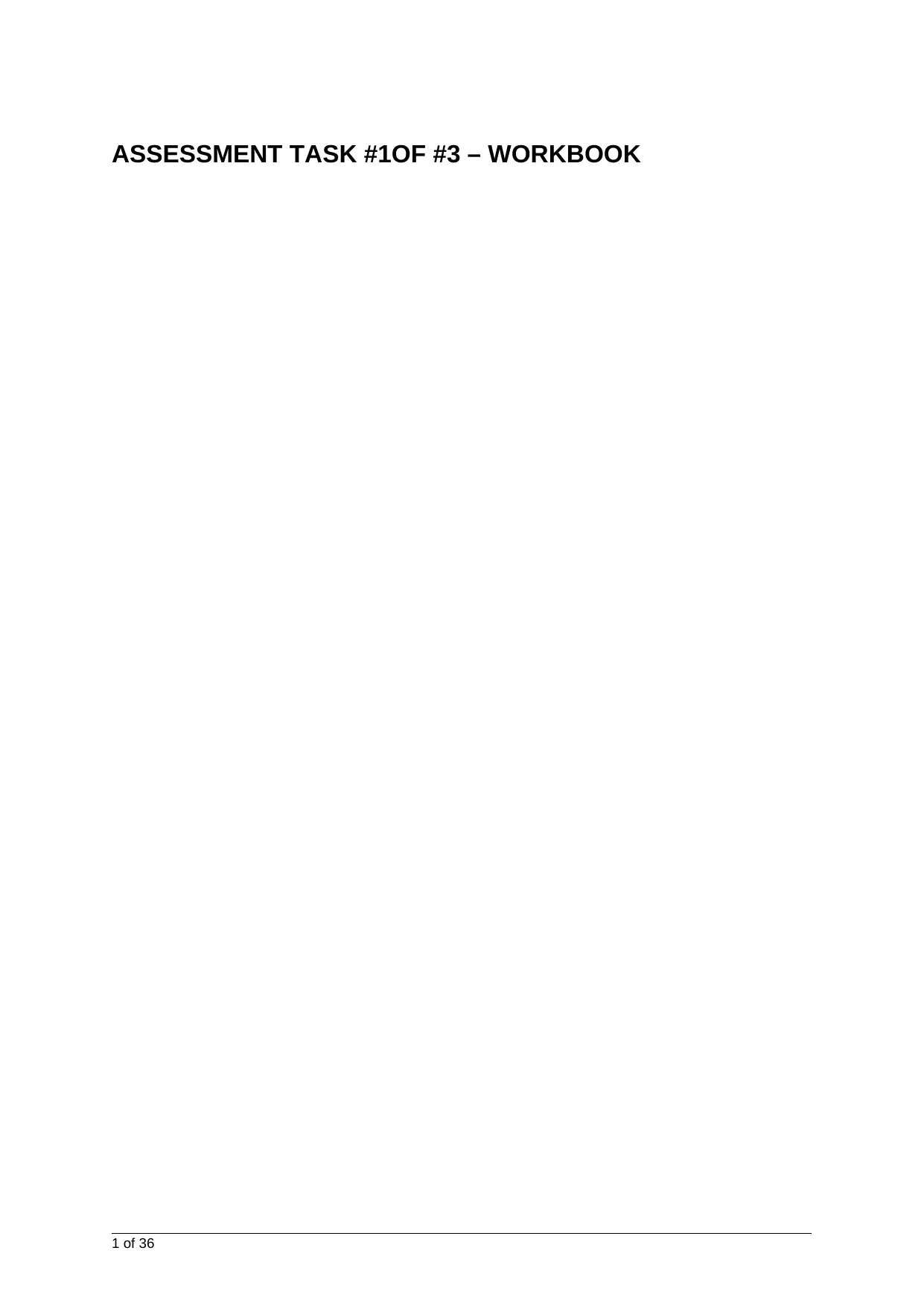
ASSESSMENT TASK #1OF #3 – WORKBOOK
1 of 36
1 of 36
Secure Best Marks with AI Grader
Need help grading? Try our AI Grader for instant feedback on your assignments.
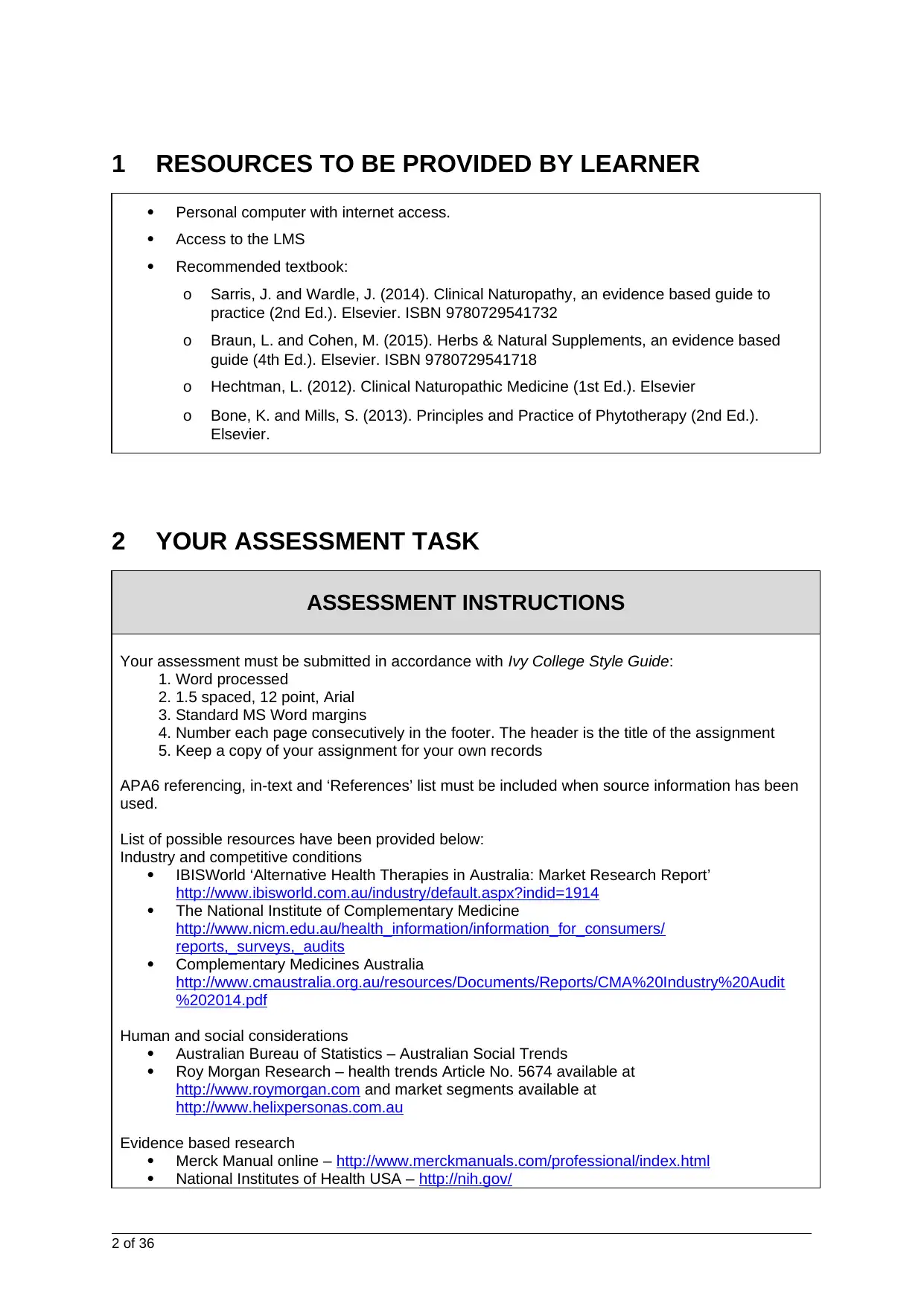
1 RESOURCES TO BE PROVIDED BY LEARNER
Personal computer with internet access.
Access to the LMS
Recommended textbook:
o Sarris, J. and Wardle, J. (2014). Clinical Naturopathy, an evidence based guide to
practice (2nd Ed.). Elsevier. ISBN 9780729541732
o Braun, L. and Cohen, M. (2015). Herbs & Natural Supplements, an evidence based
guide (4th Ed.). Elsevier. ISBN 9780729541718
o Hechtman, L. (2012). Clinical Naturopathic Medicine (1st Ed.). Elsevier
o Bone, K. and Mills, S. (2013). Principles and Practice of Phytotherapy (2nd Ed.).
Elsevier.
2 YOUR ASSESSMENT TASK
ASSESSMENT INSTRUCTIONS
Your assessment must be submitted in accordance with Ivy College Style Guide:
1. Word processed
2. 1.5 spaced, 12 point, Arial
3. Standard MS Word margins
4. Number each page consecutively in the footer. The header is the title of the assignment
5. Keep a copy of your assignment for your own records
APA6 referencing, in-text and ‘References’ list must be included when source information has been
used.
List of possible resources have been provided below:
Industry and competitive conditions
IBISWorld ‘Alternative Health Therapies in Australia: Market Research Report’
http://www.ibisworld.com.au/industry/default.aspx?indid=1914
The National Institute of Complementary Medicine
http://www.nicm.edu.au/health_information/information_for_consumers/
reports,_surveys,_audits
Complementary Medicines Australia
http://www.cmaustralia.org.au/resources/Documents/Reports/CMA%20Industry%20Audit
%202014.pdf
Human and social considerations
Australian Bureau of Statistics – Australian Social Trends
Roy Morgan Research – health trends Article No. 5674 available at
http://www.roymorgan.com and market segments available at
http://www.helixpersonas.com.au
Evidence based research
Merck Manual online – http://www.merckmanuals.com/professional/index.html
National Institutes of Health USA – http://nih.gov/
2 of 36
Personal computer with internet access.
Access to the LMS
Recommended textbook:
o Sarris, J. and Wardle, J. (2014). Clinical Naturopathy, an evidence based guide to
practice (2nd Ed.). Elsevier. ISBN 9780729541732
o Braun, L. and Cohen, M. (2015). Herbs & Natural Supplements, an evidence based
guide (4th Ed.). Elsevier. ISBN 9780729541718
o Hechtman, L. (2012). Clinical Naturopathic Medicine (1st Ed.). Elsevier
o Bone, K. and Mills, S. (2013). Principles and Practice of Phytotherapy (2nd Ed.).
Elsevier.
2 YOUR ASSESSMENT TASK
ASSESSMENT INSTRUCTIONS
Your assessment must be submitted in accordance with Ivy College Style Guide:
1. Word processed
2. 1.5 spaced, 12 point, Arial
3. Standard MS Word margins
4. Number each page consecutively in the footer. The header is the title of the assignment
5. Keep a copy of your assignment for your own records
APA6 referencing, in-text and ‘References’ list must be included when source information has been
used.
List of possible resources have been provided below:
Industry and competitive conditions
IBISWorld ‘Alternative Health Therapies in Australia: Market Research Report’
http://www.ibisworld.com.au/industry/default.aspx?indid=1914
The National Institute of Complementary Medicine
http://www.nicm.edu.au/health_information/information_for_consumers/
reports,_surveys,_audits
Complementary Medicines Australia
http://www.cmaustralia.org.au/resources/Documents/Reports/CMA%20Industry%20Audit
%202014.pdf
Human and social considerations
Australian Bureau of Statistics – Australian Social Trends
Roy Morgan Research – health trends Article No. 5674 available at
http://www.roymorgan.com and market segments available at
http://www.helixpersonas.com.au
Evidence based research
Merck Manual online – http://www.merckmanuals.com/professional/index.html
National Institutes of Health USA – http://nih.gov/
2 of 36
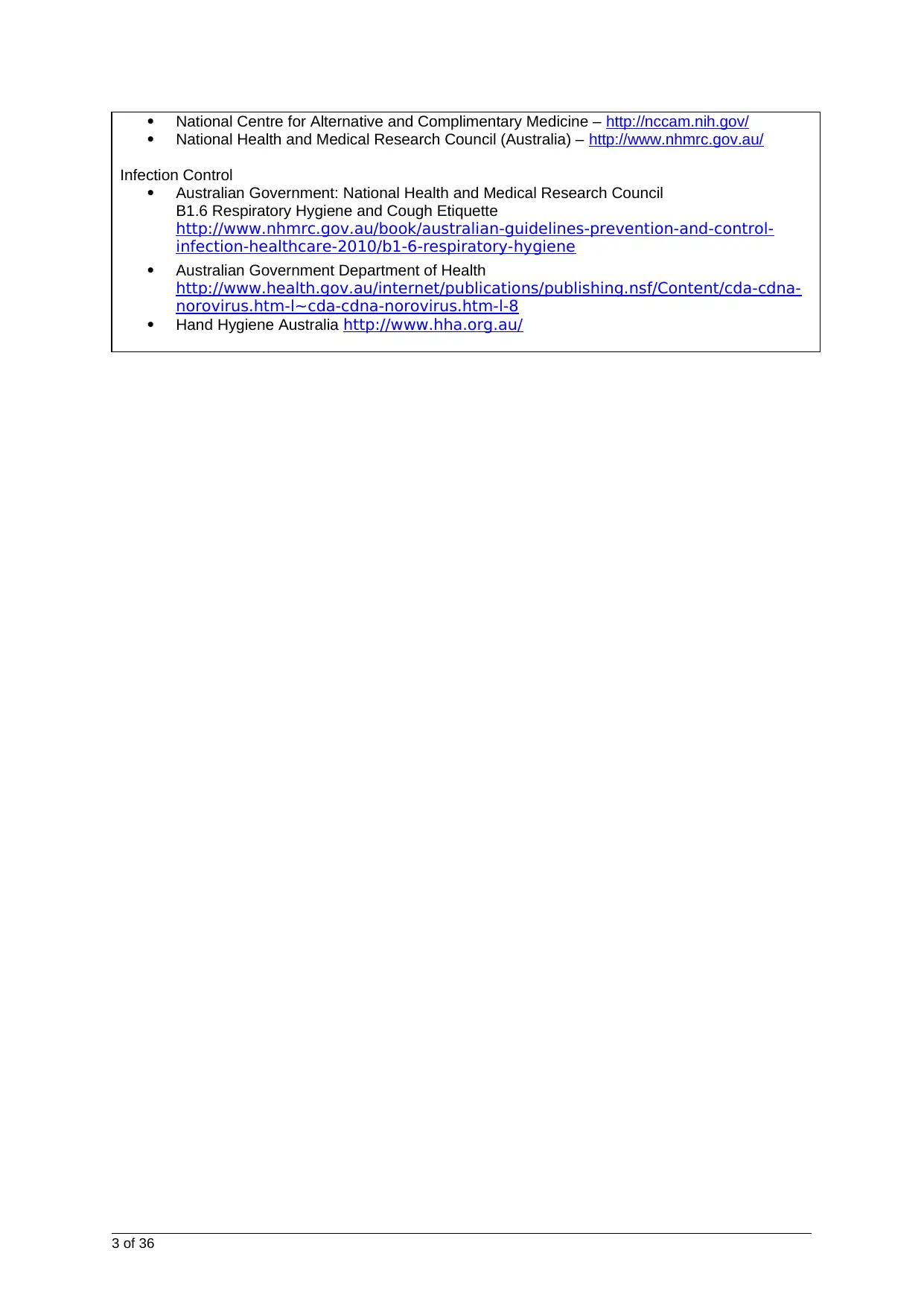
National Centre for Alternative and Complimentary Medicine – http://nccam.nih.gov/
National Health and Medical Research Council (Australia) – http://www.nhmrc.gov.au/
Infection Control
Australian Government: National Health and Medical Research Council
B1.6 Respiratory Hygiene and Cough Etiquette
http://www.nhmrc.gov.au/book/australian-guidelines-prevention-and-control-
infection-healthcare-2010/b1-6-respiratory-hygiene
Australian Government Department of Health
http://www.health.gov.au/internet/publications/publishing.nsf/Content/cda-cdna-
norovirus.htm-l~cda-cdna-norovirus.htm-l-8
Hand Hygiene Australia http://www.hha.org.au/
3 of 36
National Health and Medical Research Council (Australia) – http://www.nhmrc.gov.au/
Infection Control
Australian Government: National Health and Medical Research Council
B1.6 Respiratory Hygiene and Cough Etiquette
http://www.nhmrc.gov.au/book/australian-guidelines-prevention-and-control-
infection-healthcare-2010/b1-6-respiratory-hygiene
Australian Government Department of Health
http://www.health.gov.au/internet/publications/publishing.nsf/Content/cda-cdna-
norovirus.htm-l~cda-cdna-norovirus.htm-l-8
Hand Hygiene Australia http://www.hha.org.au/
3 of 36
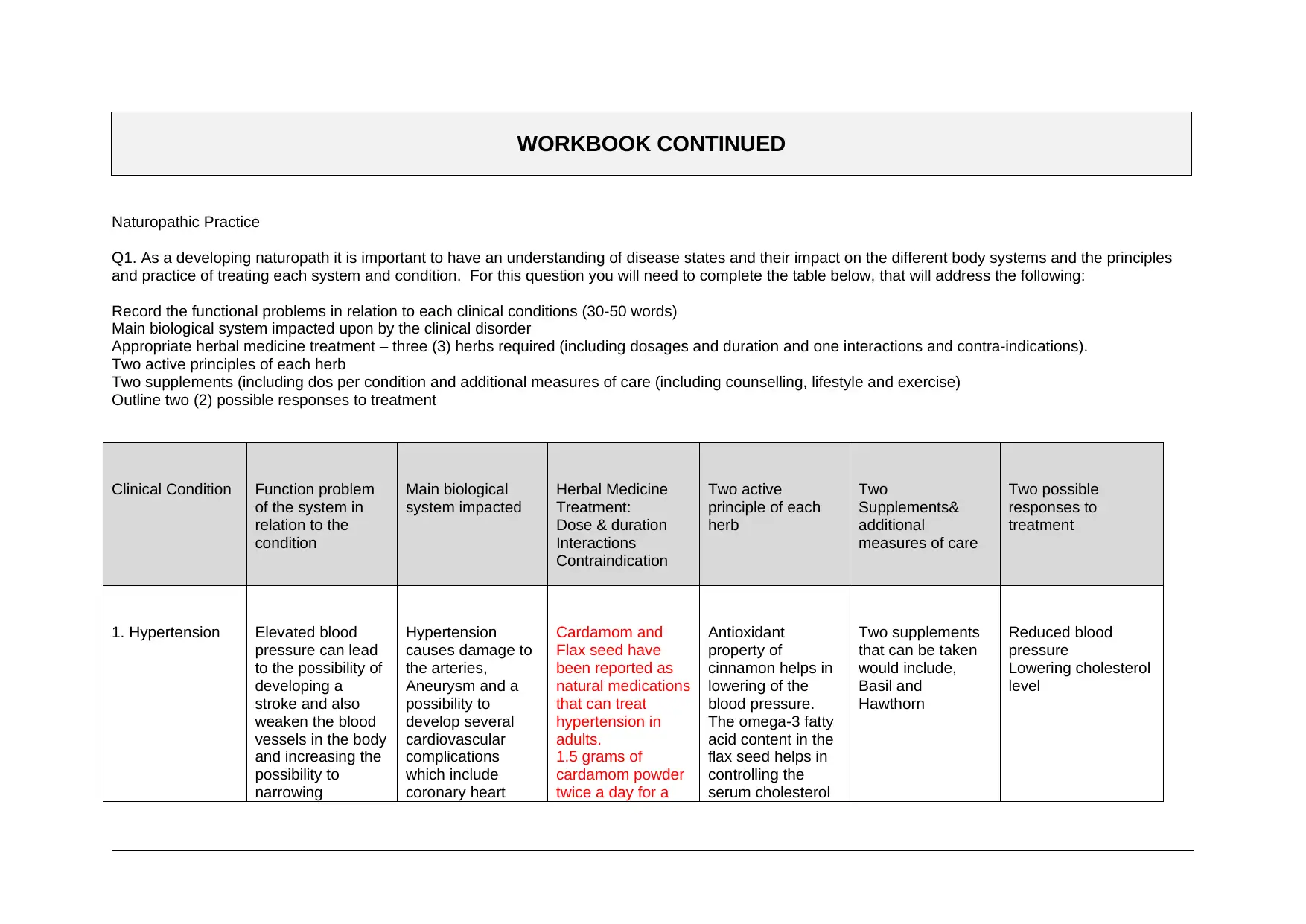
WORKBOOK CONTINUED
Naturopathic Practice
Q1. As a developing naturopath it is important to have an understanding of disease states and their impact on the different body systems and the principles
and practice of treating each system and condition. For this question you will need to complete the table below, that will address the following:
Record the functional problems in relation to each clinical conditions (30-50 words)
Main biological system impacted upon by the clinical disorder
Appropriate herbal medicine treatment – three (3) herbs required (including dosages and duration and one interactions and contra-indications).
Two active principles of each herb
Two supplements (including dos per condition and additional measures of care (including counselling, lifestyle and exercise)
Outline two (2) possible responses to treatment
Clinical Condition Function problem
of the system in
relation to the
condition
Main biological
system impacted
Herbal Medicine
Treatment:
Dose & duration
Interactions
Contraindication
Two active
principle of each
herb
Two
Supplements&
additional
measures of care
Two possible
responses to
treatment
1. Hypertension Elevated blood
pressure can lead
to the possibility of
developing a
stroke and also
weaken the blood
vessels in the body
and increasing the
possibility to
narrowing
Hypertension
causes damage to
the arteries,
Aneurysm and a
possibility to
develop several
cardiovascular
complications
which include
coronary heart
Cardamom and
Flax seed have
been reported as
natural medications
that can treat
hypertension in
adults.
1.5 grams of
cardamom powder
twice a day for a
Antioxidant
property of
cinnamon helps in
lowering of the
blood pressure.
The omega-3 fatty
acid content in the
flax seed helps in
controlling the
serum cholesterol
Two supplements
that can be taken
would include,
Basil and
Hawthorn
Reduced blood
pressure
Lowering cholesterol
level
Naturopathic Practice
Q1. As a developing naturopath it is important to have an understanding of disease states and their impact on the different body systems and the principles
and practice of treating each system and condition. For this question you will need to complete the table below, that will address the following:
Record the functional problems in relation to each clinical conditions (30-50 words)
Main biological system impacted upon by the clinical disorder
Appropriate herbal medicine treatment – three (3) herbs required (including dosages and duration and one interactions and contra-indications).
Two active principles of each herb
Two supplements (including dos per condition and additional measures of care (including counselling, lifestyle and exercise)
Outline two (2) possible responses to treatment
Clinical Condition Function problem
of the system in
relation to the
condition
Main biological
system impacted
Herbal Medicine
Treatment:
Dose & duration
Interactions
Contraindication
Two active
principle of each
herb
Two
Supplements&
additional
measures of care
Two possible
responses to
treatment
1. Hypertension Elevated blood
pressure can lead
to the possibility of
developing a
stroke and also
weaken the blood
vessels in the body
and increasing the
possibility to
narrowing
Hypertension
causes damage to
the arteries,
Aneurysm and a
possibility to
develop several
cardiovascular
complications
which include
coronary heart
Cardamom and
Flax seed have
been reported as
natural medications
that can treat
hypertension in
adults.
1.5 grams of
cardamom powder
twice a day for a
Antioxidant
property of
cinnamon helps in
lowering of the
blood pressure.
The omega-3 fatty
acid content in the
flax seed helps in
controlling the
serum cholesterol
Two supplements
that can be taken
would include,
Basil and
Hawthorn
Reduced blood
pressure
Lowering cholesterol
level
Secure Best Marks with AI Grader
Need help grading? Try our AI Grader for instant feedback on your assignments.
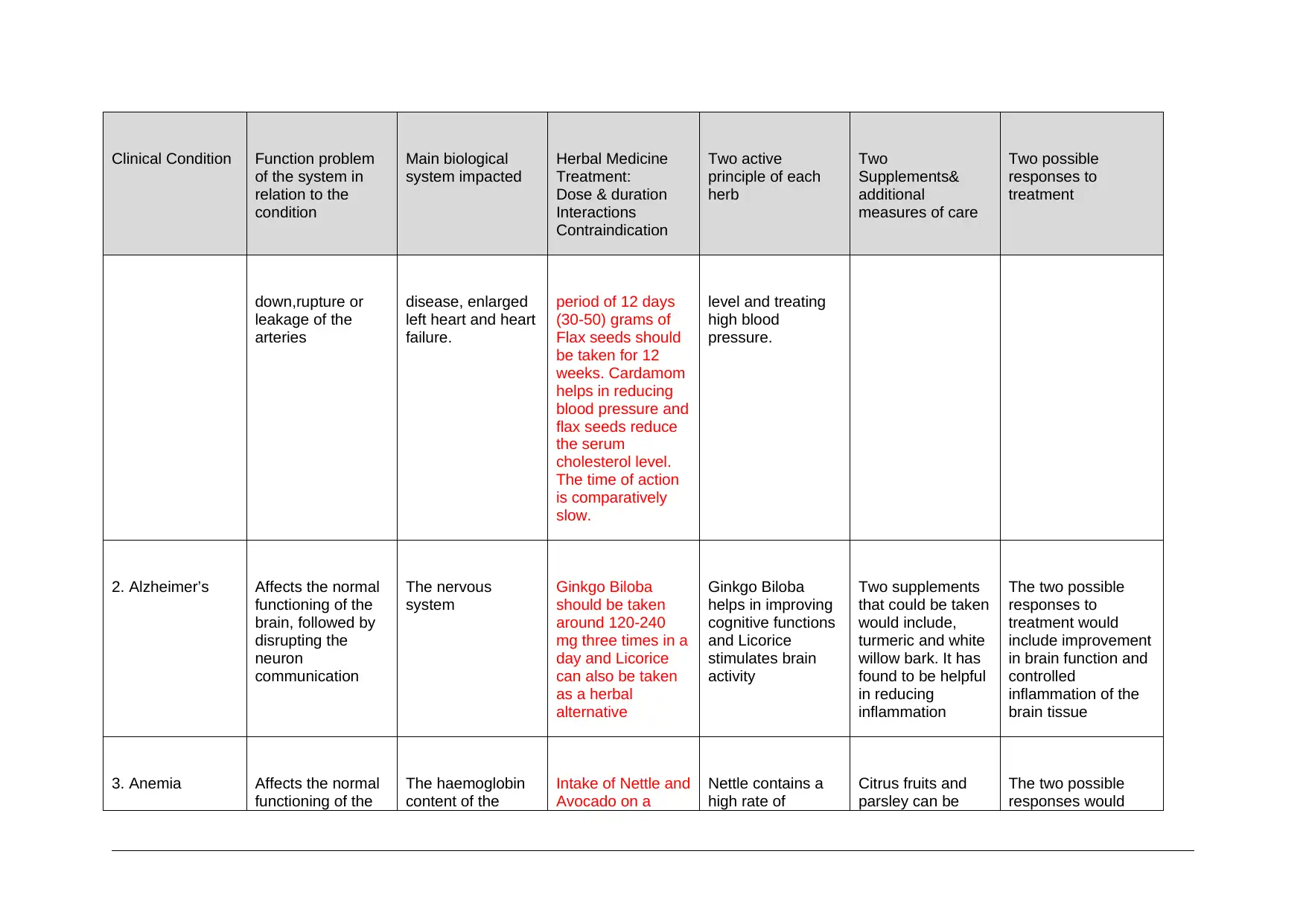
Clinical Condition Function problem
of the system in
relation to the
condition
Main biological
system impacted
Herbal Medicine
Treatment:
Dose & duration
Interactions
Contraindication
Two active
principle of each
herb
Two
Supplements&
additional
measures of care
Two possible
responses to
treatment
down,rupture or
leakage of the
arteries
disease, enlarged
left heart and heart
failure.
period of 12 days
(30-50) grams of
Flax seeds should
be taken for 12
weeks. Cardamom
helps in reducing
blood pressure and
flax seeds reduce
the serum
cholesterol level.
The time of action
is comparatively
slow.
level and treating
high blood
pressure.
2. Alzheimer’s Affects the normal
functioning of the
brain, followed by
disrupting the
neuron
communication
The nervous
system
Ginkgo Biloba
should be taken
around 120-240
mg three times in a
day and Licorice
can also be taken
as a herbal
alternative
Ginkgo Biloba
helps in improving
cognitive functions
and Licorice
stimulates brain
activity
Two supplements
that could be taken
would include,
turmeric and white
willow bark. It has
found to be helpful
in reducing
inflammation
The two possible
responses to
treatment would
include improvement
in brain function and
controlled
inflammation of the
brain tissue
3. Anemia Affects the normal
functioning of the
The haemoglobin
content of the
Intake of Nettle and
Avocado on a
Nettle contains a
high rate of
Citrus fruits and
parsley can be
The two possible
responses would
of the system in
relation to the
condition
Main biological
system impacted
Herbal Medicine
Treatment:
Dose & duration
Interactions
Contraindication
Two active
principle of each
herb
Two
Supplements&
additional
measures of care
Two possible
responses to
treatment
down,rupture or
leakage of the
arteries
disease, enlarged
left heart and heart
failure.
period of 12 days
(30-50) grams of
Flax seeds should
be taken for 12
weeks. Cardamom
helps in reducing
blood pressure and
flax seeds reduce
the serum
cholesterol level.
The time of action
is comparatively
slow.
level and treating
high blood
pressure.
2. Alzheimer’s Affects the normal
functioning of the
brain, followed by
disrupting the
neuron
communication
The nervous
system
Ginkgo Biloba
should be taken
around 120-240
mg three times in a
day and Licorice
can also be taken
as a herbal
alternative
Ginkgo Biloba
helps in improving
cognitive functions
and Licorice
stimulates brain
activity
Two supplements
that could be taken
would include,
turmeric and white
willow bark. It has
found to be helpful
in reducing
inflammation
The two possible
responses to
treatment would
include improvement
in brain function and
controlled
inflammation of the
brain tissue
3. Anemia Affects the normal
functioning of the
The haemoglobin
content of the
Intake of Nettle and
Avocado on a
Nettle contains a
high rate of
Citrus fruits and
parsley can be
The two possible
responses would
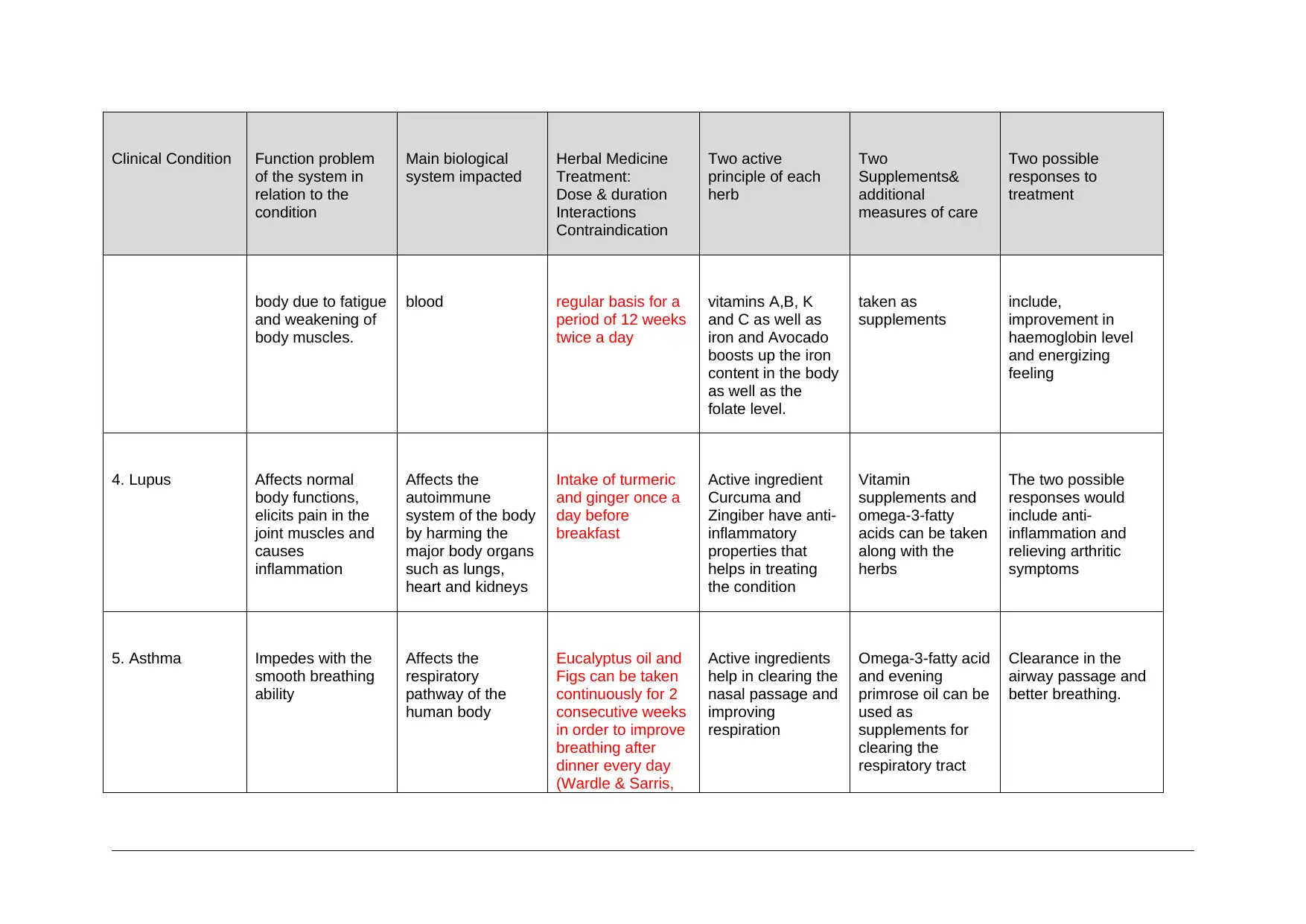
Clinical Condition Function problem
of the system in
relation to the
condition
Main biological
system impacted
Herbal Medicine
Treatment:
Dose & duration
Interactions
Contraindication
Two active
principle of each
herb
Two
Supplements&
additional
measures of care
Two possible
responses to
treatment
body due to fatigue
and weakening of
body muscles.
blood regular basis for a
period of 12 weeks
twice a day
vitamins A,B, K
and C as well as
iron and Avocado
boosts up the iron
content in the body
as well as the
folate level.
taken as
supplements
include,
improvement in
haemoglobin level
and energizing
feeling
4. Lupus Affects normal
body functions,
elicits pain in the
joint muscles and
causes
inflammation
Affects the
autoimmune
system of the body
by harming the
major body organs
such as lungs,
heart and kidneys
Intake of turmeric
and ginger once a
day before
breakfast
Active ingredient
Curcuma and
Zingiber have anti-
inflammatory
properties that
helps in treating
the condition
Vitamin
supplements and
omega-3-fatty
acids can be taken
along with the
herbs
The two possible
responses would
include anti-
inflammation and
relieving arthritic
symptoms
5. Asthma Impedes with the
smooth breathing
ability
Affects the
respiratory
pathway of the
human body
Eucalyptus oil and
Figs can be taken
continuously for 2
consecutive weeks
in order to improve
breathing after
dinner every day
(Wardle & Sarris,
Active ingredients
help in clearing the
nasal passage and
improving
respiration
Omega-3-fatty acid
and evening
primrose oil can be
used as
supplements for
clearing the
respiratory tract
Clearance in the
airway passage and
better breathing.
of the system in
relation to the
condition
Main biological
system impacted
Herbal Medicine
Treatment:
Dose & duration
Interactions
Contraindication
Two active
principle of each
herb
Two
Supplements&
additional
measures of care
Two possible
responses to
treatment
body due to fatigue
and weakening of
body muscles.
blood regular basis for a
period of 12 weeks
twice a day
vitamins A,B, K
and C as well as
iron and Avocado
boosts up the iron
content in the body
as well as the
folate level.
taken as
supplements
include,
improvement in
haemoglobin level
and energizing
feeling
4. Lupus Affects normal
body functions,
elicits pain in the
joint muscles and
causes
inflammation
Affects the
autoimmune
system of the body
by harming the
major body organs
such as lungs,
heart and kidneys
Intake of turmeric
and ginger once a
day before
breakfast
Active ingredient
Curcuma and
Zingiber have anti-
inflammatory
properties that
helps in treating
the condition
Vitamin
supplements and
omega-3-fatty
acids can be taken
along with the
herbs
The two possible
responses would
include anti-
inflammation and
relieving arthritic
symptoms
5. Asthma Impedes with the
smooth breathing
ability
Affects the
respiratory
pathway of the
human body
Eucalyptus oil and
Figs can be taken
continuously for 2
consecutive weeks
in order to improve
breathing after
dinner every day
(Wardle & Sarris,
Active ingredients
help in clearing the
nasal passage and
improving
respiration
Omega-3-fatty acid
and evening
primrose oil can be
used as
supplements for
clearing the
respiratory tract
Clearance in the
airway passage and
better breathing.
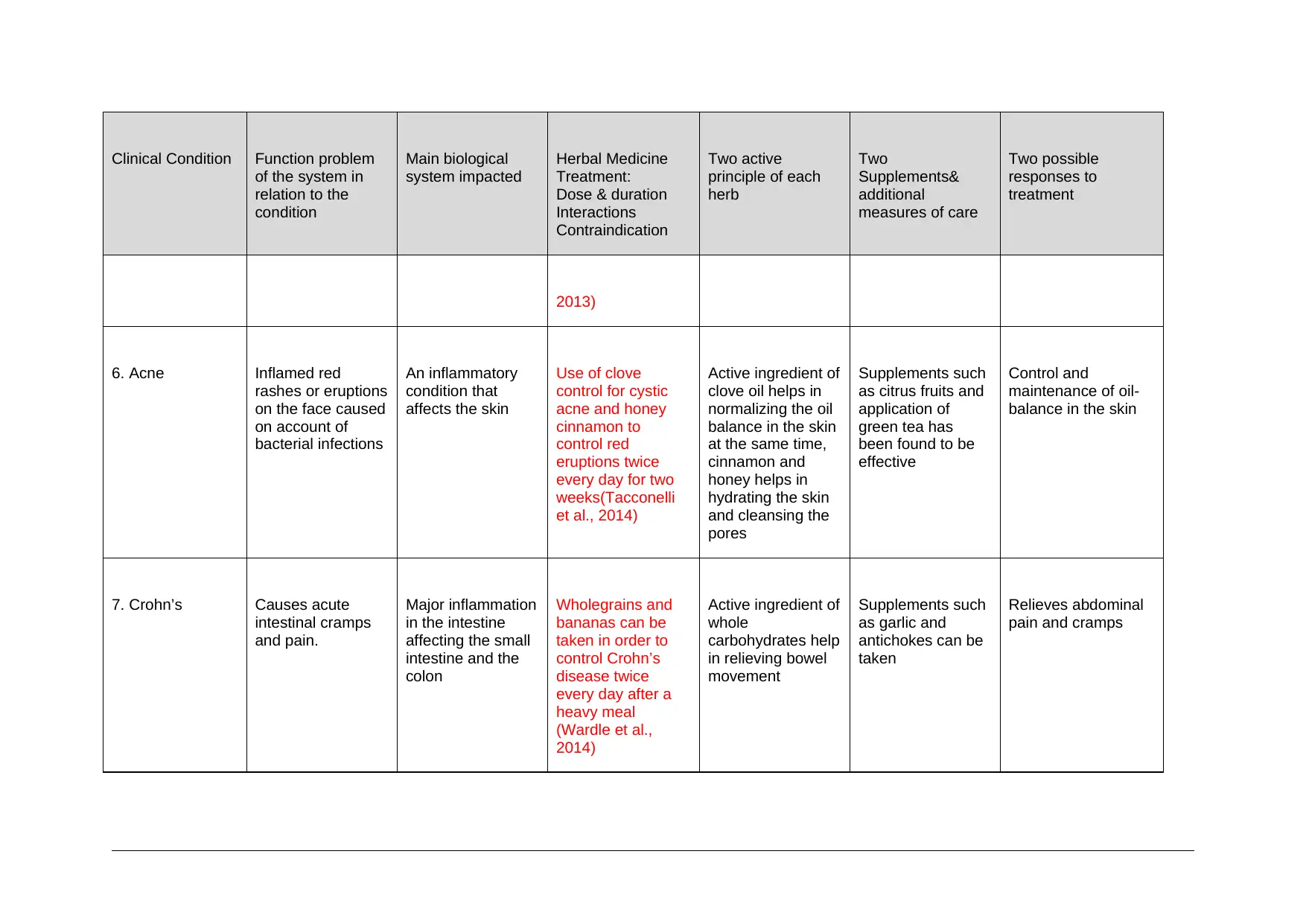
Clinical Condition Function problem
of the system in
relation to the
condition
Main biological
system impacted
Herbal Medicine
Treatment:
Dose & duration
Interactions
Contraindication
Two active
principle of each
herb
Two
Supplements&
additional
measures of care
Two possible
responses to
treatment
2013)
6. Acne Inflamed red
rashes or eruptions
on the face caused
on account of
bacterial infections
An inflammatory
condition that
affects the skin
Use of clove
control for cystic
acne and honey
cinnamon to
control red
eruptions twice
every day for two
weeks(Tacconelli
et al., 2014)
Active ingredient of
clove oil helps in
normalizing the oil
balance in the skin
at the same time,
cinnamon and
honey helps in
hydrating the skin
and cleansing the
pores
Supplements such
as citrus fruits and
application of
green tea has
been found to be
effective
Control and
maintenance of oil-
balance in the skin
7. Crohn’s Causes acute
intestinal cramps
and pain.
Major inflammation
in the intestine
affecting the small
intestine and the
colon
Wholegrains and
bananas can be
taken in order to
control Crohn’s
disease twice
every day after a
heavy meal
(Wardle et al.,
2014)
Active ingredient of
whole
carbohydrates help
in relieving bowel
movement
Supplements such
as garlic and
antichokes can be
taken
Relieves abdominal
pain and cramps
of the system in
relation to the
condition
Main biological
system impacted
Herbal Medicine
Treatment:
Dose & duration
Interactions
Contraindication
Two active
principle of each
herb
Two
Supplements&
additional
measures of care
Two possible
responses to
treatment
2013)
6. Acne Inflamed red
rashes or eruptions
on the face caused
on account of
bacterial infections
An inflammatory
condition that
affects the skin
Use of clove
control for cystic
acne and honey
cinnamon to
control red
eruptions twice
every day for two
weeks(Tacconelli
et al., 2014)
Active ingredient of
clove oil helps in
normalizing the oil
balance in the skin
at the same time,
cinnamon and
honey helps in
hydrating the skin
and cleansing the
pores
Supplements such
as citrus fruits and
application of
green tea has
been found to be
effective
Control and
maintenance of oil-
balance in the skin
7. Crohn’s Causes acute
intestinal cramps
and pain.
Major inflammation
in the intestine
affecting the small
intestine and the
colon
Wholegrains and
bananas can be
taken in order to
control Crohn’s
disease twice
every day after a
heavy meal
(Wardle et al.,
2014)
Active ingredient of
whole
carbohydrates help
in relieving bowel
movement
Supplements such
as garlic and
antichokes can be
taken
Relieves abdominal
pain and cramps
Paraphrase This Document
Need a fresh take? Get an instant paraphrase of this document with our AI Paraphraser
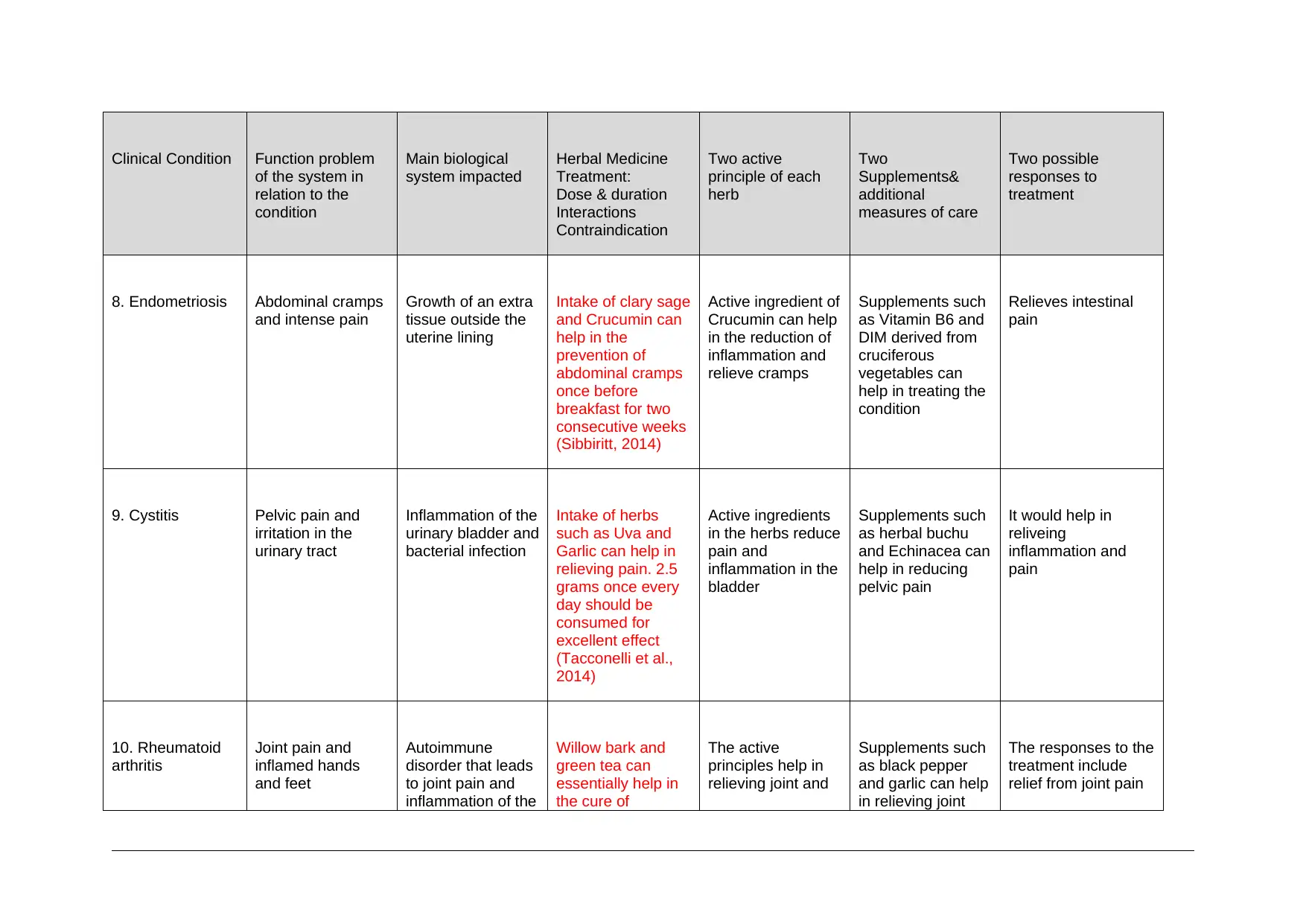
Clinical Condition Function problem
of the system in
relation to the
condition
Main biological
system impacted
Herbal Medicine
Treatment:
Dose & duration
Interactions
Contraindication
Two active
principle of each
herb
Two
Supplements&
additional
measures of care
Two possible
responses to
treatment
8. Endometriosis Abdominal cramps
and intense pain
Growth of an extra
tissue outside the
uterine lining
Intake of clary sage
and Crucumin can
help in the
prevention of
abdominal cramps
once before
breakfast for two
consecutive weeks
(Sibbiritt, 2014)
Active ingredient of
Crucumin can help
in the reduction of
inflammation and
relieve cramps
Supplements such
as Vitamin B6 and
DIM derived from
cruciferous
vegetables can
help in treating the
condition
Relieves intestinal
pain
9. Cystitis Pelvic pain and
irritation in the
urinary tract
Inflammation of the
urinary bladder and
bacterial infection
Intake of herbs
such as Uva and
Garlic can help in
relieving pain. 2.5
grams once every
day should be
consumed for
excellent effect
(Tacconelli et al.,
2014)
Active ingredients
in the herbs reduce
pain and
inflammation in the
bladder
Supplements such
as herbal buchu
and Echinacea can
help in reducing
pelvic pain
It would help in
reliveing
inflammation and
pain
10. Rheumatoid
arthritis
Joint pain and
inflamed hands
and feet
Autoimmune
disorder that leads
to joint pain and
inflammation of the
Willow bark and
green tea can
essentially help in
the cure of
The active
principles help in
relieving joint and
Supplements such
as black pepper
and garlic can help
in relieving joint
The responses to the
treatment include
relief from joint pain
of the system in
relation to the
condition
Main biological
system impacted
Herbal Medicine
Treatment:
Dose & duration
Interactions
Contraindication
Two active
principle of each
herb
Two
Supplements&
additional
measures of care
Two possible
responses to
treatment
8. Endometriosis Abdominal cramps
and intense pain
Growth of an extra
tissue outside the
uterine lining
Intake of clary sage
and Crucumin can
help in the
prevention of
abdominal cramps
once before
breakfast for two
consecutive weeks
(Sibbiritt, 2014)
Active ingredient of
Crucumin can help
in the reduction of
inflammation and
relieve cramps
Supplements such
as Vitamin B6 and
DIM derived from
cruciferous
vegetables can
help in treating the
condition
Relieves intestinal
pain
9. Cystitis Pelvic pain and
irritation in the
urinary tract
Inflammation of the
urinary bladder and
bacterial infection
Intake of herbs
such as Uva and
Garlic can help in
relieving pain. 2.5
grams once every
day should be
consumed for
excellent effect
(Tacconelli et al.,
2014)
Active ingredients
in the herbs reduce
pain and
inflammation in the
bladder
Supplements such
as herbal buchu
and Echinacea can
help in reducing
pelvic pain
It would help in
reliveing
inflammation and
pain
10. Rheumatoid
arthritis
Joint pain and
inflamed hands
and feet
Autoimmune
disorder that leads
to joint pain and
inflammation of the
Willow bark and
green tea can
essentially help in
the cure of
The active
principles help in
relieving joint and
Supplements such
as black pepper
and garlic can help
in relieving joint
The responses to the
treatment include
relief from joint pain
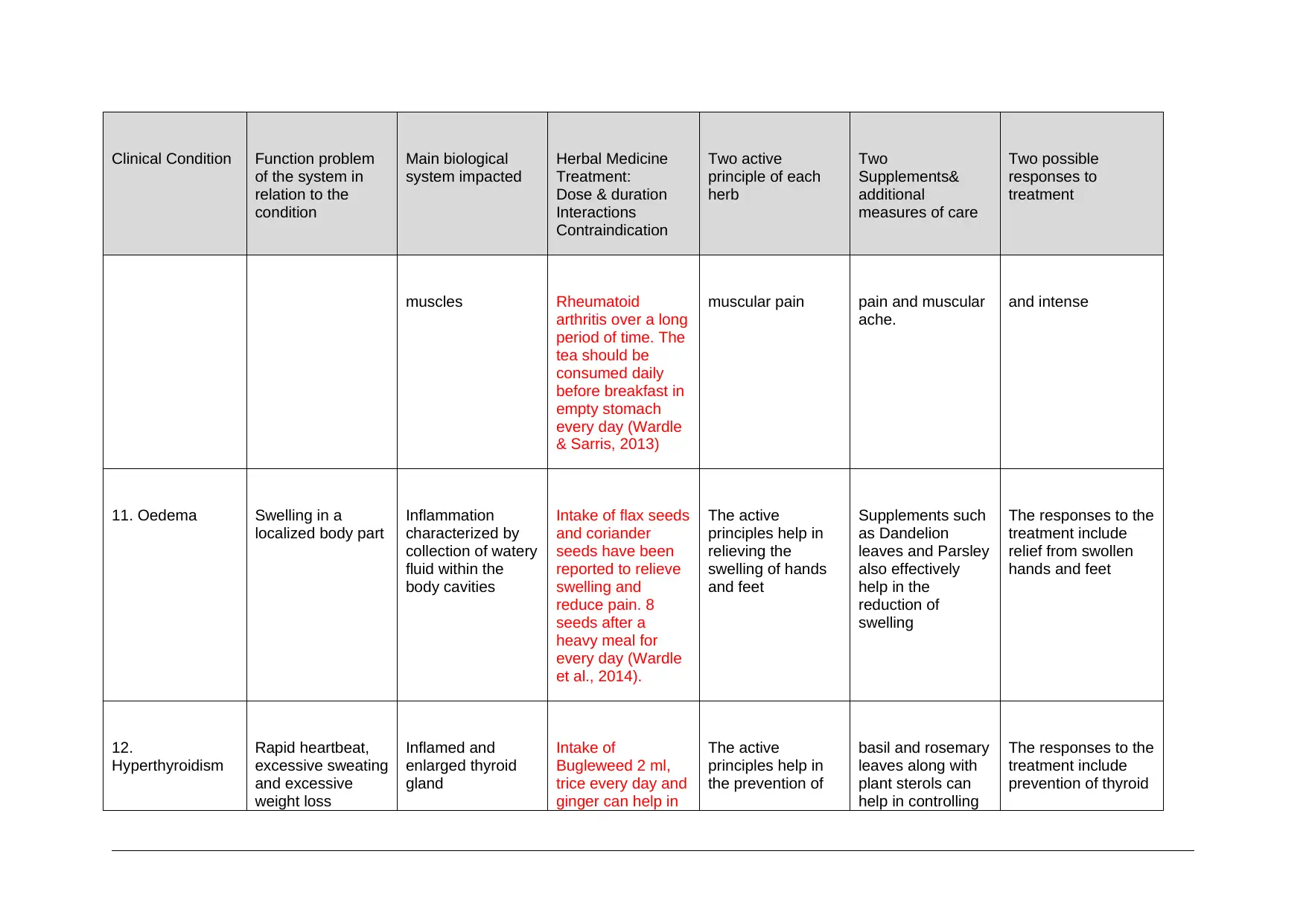
Clinical Condition Function problem
of the system in
relation to the
condition
Main biological
system impacted
Herbal Medicine
Treatment:
Dose & duration
Interactions
Contraindication
Two active
principle of each
herb
Two
Supplements&
additional
measures of care
Two possible
responses to
treatment
muscles Rheumatoid
arthritis over a long
period of time. The
tea should be
consumed daily
before breakfast in
empty stomach
every day (Wardle
& Sarris, 2013)
muscular pain pain and muscular
ache.
and intense
11. Oedema Swelling in a
localized body part
Inflammation
characterized by
collection of watery
fluid within the
body cavities
Intake of flax seeds
and coriander
seeds have been
reported to relieve
swelling and
reduce pain. 8
seeds after a
heavy meal for
every day (Wardle
et al., 2014).
The active
principles help in
relieving the
swelling of hands
and feet
Supplements such
as Dandelion
leaves and Parsley
also effectively
help in the
reduction of
swelling
The responses to the
treatment include
relief from swollen
hands and feet
12.
Hyperthyroidism
Rapid heartbeat,
excessive sweating
and excessive
weight loss
Inflamed and
enlarged thyroid
gland
Intake of
Bugleweed 2 ml,
trice every day and
ginger can help in
The active
principles help in
the prevention of
basil and rosemary
leaves along with
plant sterols can
help in controlling
The responses to the
treatment include
prevention of thyroid
of the system in
relation to the
condition
Main biological
system impacted
Herbal Medicine
Treatment:
Dose & duration
Interactions
Contraindication
Two active
principle of each
herb
Two
Supplements&
additional
measures of care
Two possible
responses to
treatment
muscles Rheumatoid
arthritis over a long
period of time. The
tea should be
consumed daily
before breakfast in
empty stomach
every day (Wardle
& Sarris, 2013)
muscular pain pain and muscular
ache.
and intense
11. Oedema Swelling in a
localized body part
Inflammation
characterized by
collection of watery
fluid within the
body cavities
Intake of flax seeds
and coriander
seeds have been
reported to relieve
swelling and
reduce pain. 8
seeds after a
heavy meal for
every day (Wardle
et al., 2014).
The active
principles help in
relieving the
swelling of hands
and feet
Supplements such
as Dandelion
leaves and Parsley
also effectively
help in the
reduction of
swelling
The responses to the
treatment include
relief from swollen
hands and feet
12.
Hyperthyroidism
Rapid heartbeat,
excessive sweating
and excessive
weight loss
Inflamed and
enlarged thyroid
gland
Intake of
Bugleweed 2 ml,
trice every day and
ginger can help in
The active
principles help in
the prevention of
basil and rosemary
leaves along with
plant sterols can
help in controlling
The responses to the
treatment include
prevention of thyroid
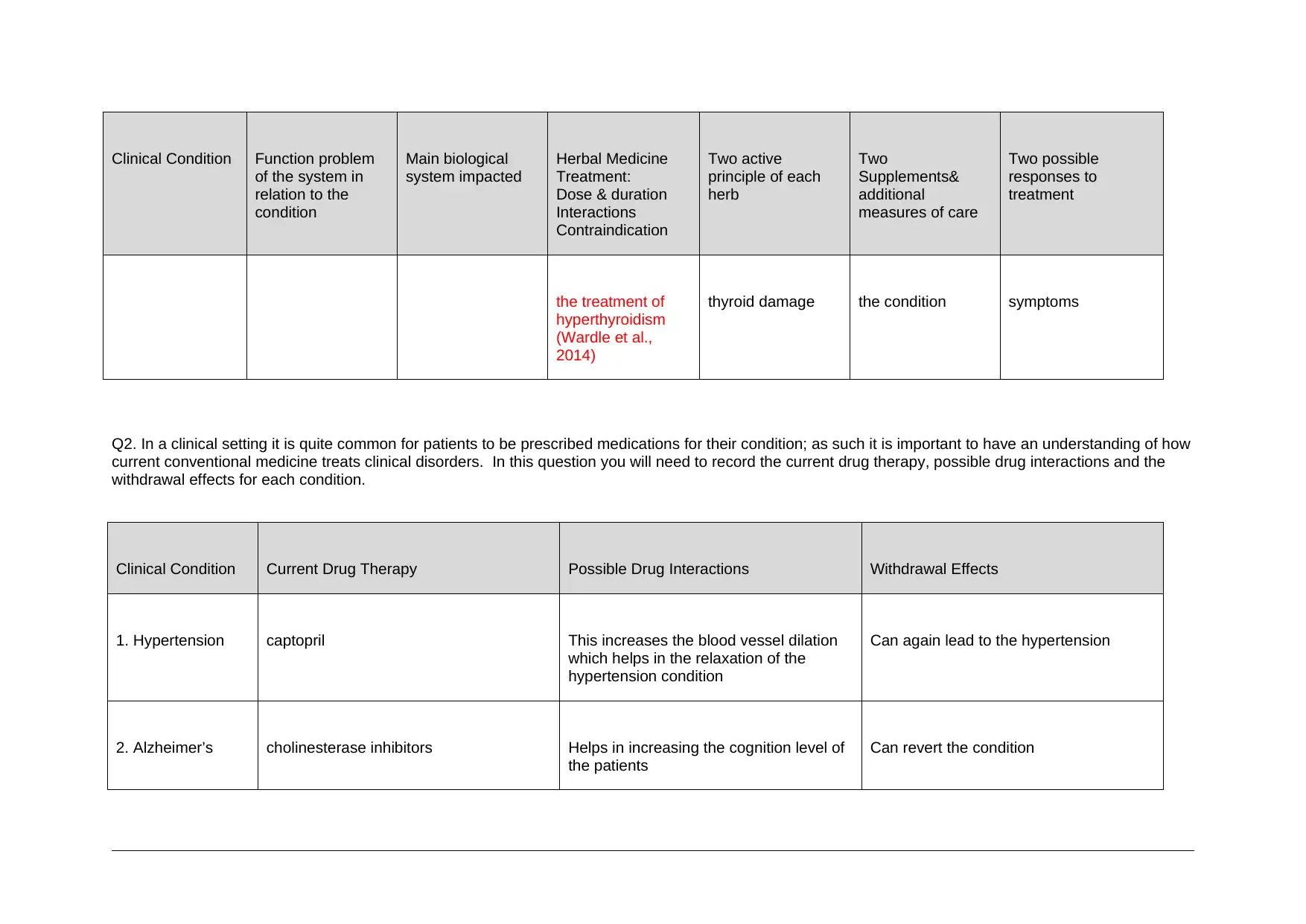
Clinical Condition Function problem
of the system in
relation to the
condition
Main biological
system impacted
Herbal Medicine
Treatment:
Dose & duration
Interactions
Contraindication
Two active
principle of each
herb
Two
Supplements&
additional
measures of care
Two possible
responses to
treatment
the treatment of
hyperthyroidism
(Wardle et al.,
2014)
thyroid damage the condition symptoms
Q2. In a clinical setting it is quite common for patients to be prescribed medications for their condition; as such it is important to have an understanding of how
current conventional medicine treats clinical disorders. In this question you will need to record the current drug therapy, possible drug interactions and the
withdrawal effects for each condition.
Clinical Condition Current Drug Therapy Possible Drug Interactions Withdrawal Effects
1. Hypertension captopril This increases the blood vessel dilation
which helps in the relaxation of the
hypertension condition
Can again lead to the hypertension
2. Alzheimer’s cholinesterase inhibitors Helps in increasing the cognition level of
the patients
Can revert the condition
of the system in
relation to the
condition
Main biological
system impacted
Herbal Medicine
Treatment:
Dose & duration
Interactions
Contraindication
Two active
principle of each
herb
Two
Supplements&
additional
measures of care
Two possible
responses to
treatment
the treatment of
hyperthyroidism
(Wardle et al.,
2014)
thyroid damage the condition symptoms
Q2. In a clinical setting it is quite common for patients to be prescribed medications for their condition; as such it is important to have an understanding of how
current conventional medicine treats clinical disorders. In this question you will need to record the current drug therapy, possible drug interactions and the
withdrawal effects for each condition.
Clinical Condition Current Drug Therapy Possible Drug Interactions Withdrawal Effects
1. Hypertension captopril This increases the blood vessel dilation
which helps in the relaxation of the
hypertension condition
Can again lead to the hypertension
2. Alzheimer’s cholinesterase inhibitors Helps in increasing the cognition level of
the patients
Can revert the condition
Secure Best Marks with AI Grader
Need help grading? Try our AI Grader for instant feedback on your assignments.
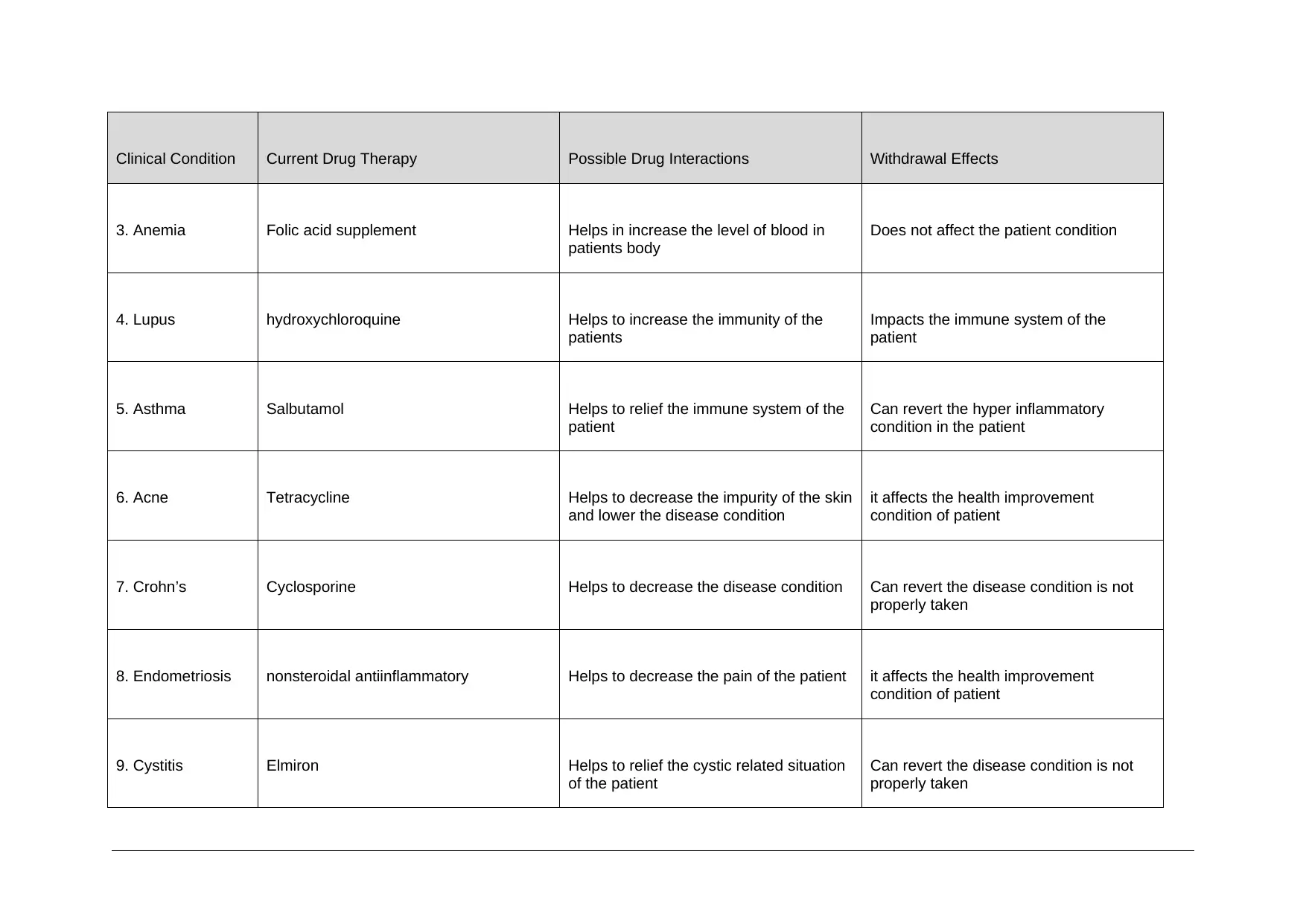
Clinical Condition Current Drug Therapy Possible Drug Interactions Withdrawal Effects
3. Anemia Folic acid supplement Helps in increase the level of blood in
patients body
Does not affect the patient condition
4. Lupus hydroxychloroquine Helps to increase the immunity of the
patients
Impacts the immune system of the
patient
5. Asthma Salbutamol Helps to relief the immune system of the
patient
Can revert the hyper inflammatory
condition in the patient
6. Acne Tetracycline Helps to decrease the impurity of the skin
and lower the disease condition
it affects the health improvement
condition of patient
7. Crohn’s Cyclosporine Helps to decrease the disease condition Can revert the disease condition is not
properly taken
8. Endometriosis nonsteroidal antiinflammatory Helps to decrease the pain of the patient it affects the health improvement
condition of patient
9. Cystitis Elmiron Helps to relief the cystic related situation
of the patient
Can revert the disease condition is not
properly taken
3. Anemia Folic acid supplement Helps in increase the level of blood in
patients body
Does not affect the patient condition
4. Lupus hydroxychloroquine Helps to increase the immunity of the
patients
Impacts the immune system of the
patient
5. Asthma Salbutamol Helps to relief the immune system of the
patient
Can revert the hyper inflammatory
condition in the patient
6. Acne Tetracycline Helps to decrease the impurity of the skin
and lower the disease condition
it affects the health improvement
condition of patient
7. Crohn’s Cyclosporine Helps to decrease the disease condition Can revert the disease condition is not
properly taken
8. Endometriosis nonsteroidal antiinflammatory Helps to decrease the pain of the patient it affects the health improvement
condition of patient
9. Cystitis Elmiron Helps to relief the cystic related situation
of the patient
Can revert the disease condition is not
properly taken
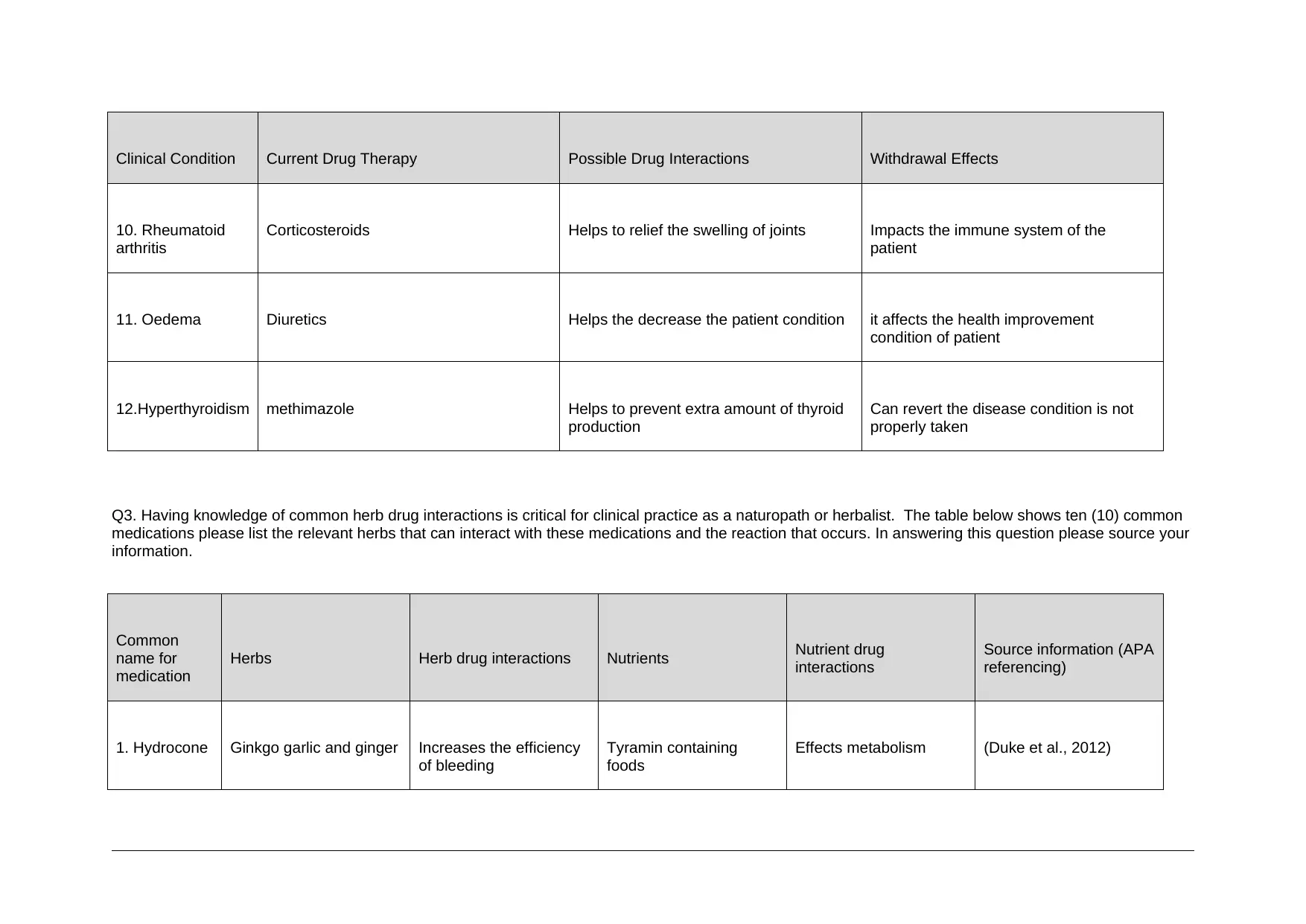
Clinical Condition Current Drug Therapy Possible Drug Interactions Withdrawal Effects
10. Rheumatoid
arthritis
Corticosteroids Helps to relief the swelling of joints Impacts the immune system of the
patient
11. Oedema Diuretics Helps the decrease the patient condition it affects the health improvement
condition of patient
12.Hyperthyroidism methimazole Helps to prevent extra amount of thyroid
production
Can revert the disease condition is not
properly taken
Q3. Having knowledge of common herb drug interactions is critical for clinical practice as a naturopath or herbalist. The table below shows ten (10) common
medications please list the relevant herbs that can interact with these medications and the reaction that occurs. In answering this question please source your
information.
Common
name for
medication
Herbs Herb drug interactions Nutrients Nutrient drug
interactions
Source information (APA
referencing)
1. Hydrocone Ginkgo garlic and ginger Increases the efficiency
of bleeding
Tyramin containing
foods
Effects metabolism (Duke et al., 2012)
10. Rheumatoid
arthritis
Corticosteroids Helps to relief the swelling of joints Impacts the immune system of the
patient
11. Oedema Diuretics Helps the decrease the patient condition it affects the health improvement
condition of patient
12.Hyperthyroidism methimazole Helps to prevent extra amount of thyroid
production
Can revert the disease condition is not
properly taken
Q3. Having knowledge of common herb drug interactions is critical for clinical practice as a naturopath or herbalist. The table below shows ten (10) common
medications please list the relevant herbs that can interact with these medications and the reaction that occurs. In answering this question please source your
information.
Common
name for
medication
Herbs Herb drug interactions Nutrients Nutrient drug
interactions
Source information (APA
referencing)
1. Hydrocone Ginkgo garlic and ginger Increases the efficiency
of bleeding
Tyramin containing
foods
Effects metabolism (Duke et al., 2012)
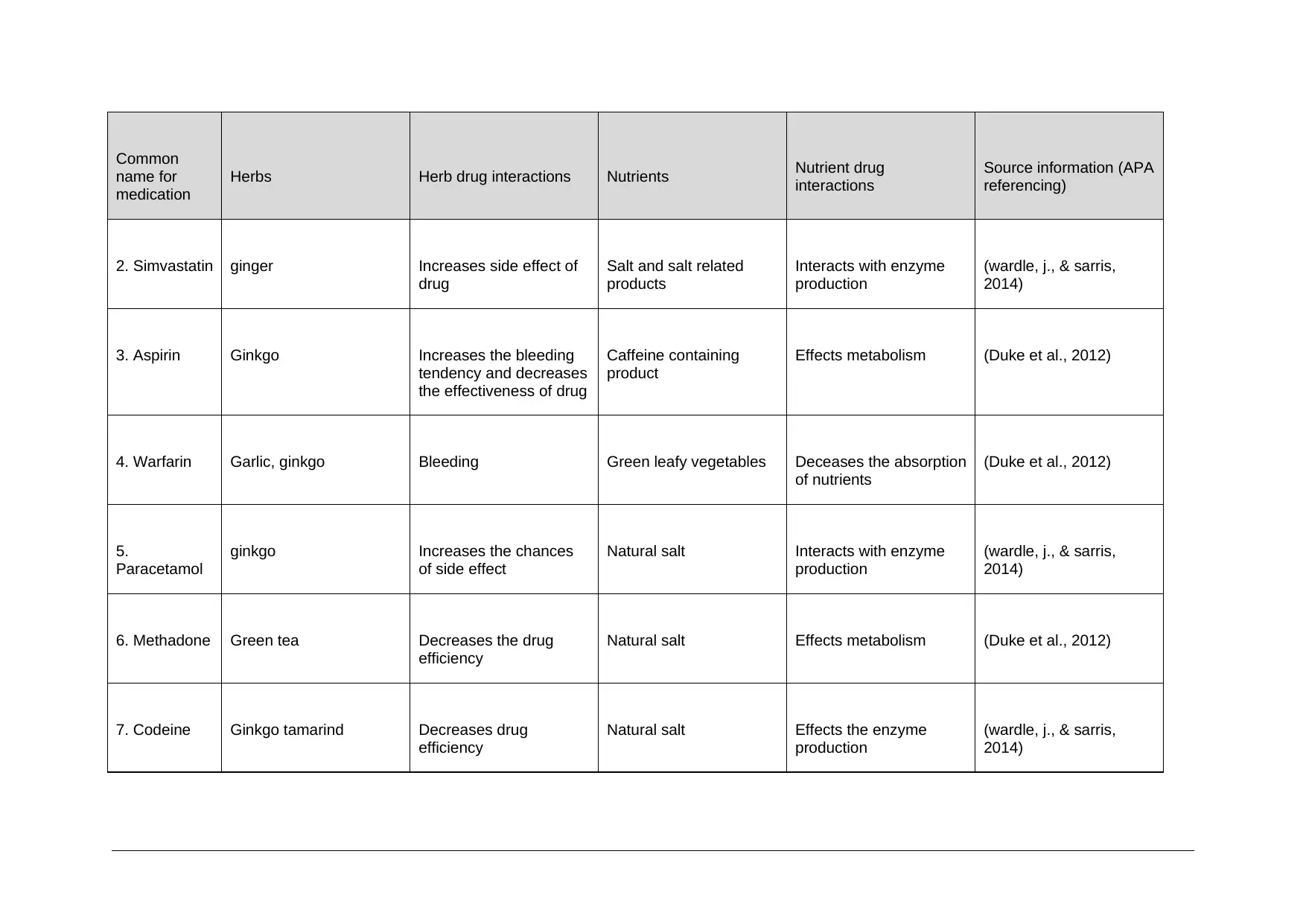
Common
name for
medication
Herbs Herb drug interactions Nutrients Nutrient drug
interactions
Source information (APA
referencing)
2. Simvastatin ginger Increases side effect of
drug
Salt and salt related
products
Interacts with enzyme
production
(wardle, j., & sarris,
2014)
3. Aspirin Ginkgo Increases the bleeding
tendency and decreases
the effectiveness of drug
Caffeine containing
product
Effects metabolism (Duke et al., 2012)
4. Warfarin Garlic, ginkgo Bleeding Green leafy vegetables Deceases the absorption
of nutrients
(Duke et al., 2012)
5.
Paracetamol
ginkgo Increases the chances
of side effect
Natural salt Interacts with enzyme
production
(wardle, j., & sarris,
2014)
6. Methadone Green tea Decreases the drug
efficiency
Natural salt Effects metabolism (Duke et al., 2012)
7. Codeine Ginkgo tamarind Decreases drug
efficiency
Natural salt Effects the enzyme
production
(wardle, j., & sarris,
2014)
name for
medication
Herbs Herb drug interactions Nutrients Nutrient drug
interactions
Source information (APA
referencing)
2. Simvastatin ginger Increases side effect of
drug
Salt and salt related
products
Interacts with enzyme
production
(wardle, j., & sarris,
2014)
3. Aspirin Ginkgo Increases the bleeding
tendency and decreases
the effectiveness of drug
Caffeine containing
product
Effects metabolism (Duke et al., 2012)
4. Warfarin Garlic, ginkgo Bleeding Green leafy vegetables Deceases the absorption
of nutrients
(Duke et al., 2012)
5.
Paracetamol
ginkgo Increases the chances
of side effect
Natural salt Interacts with enzyme
production
(wardle, j., & sarris,
2014)
6. Methadone Green tea Decreases the drug
efficiency
Natural salt Effects metabolism (Duke et al., 2012)
7. Codeine Ginkgo tamarind Decreases drug
efficiency
Natural salt Effects the enzyme
production
(wardle, j., & sarris,
2014)
Paraphrase This Document
Need a fresh take? Get an instant paraphrase of this document with our AI Paraphraser
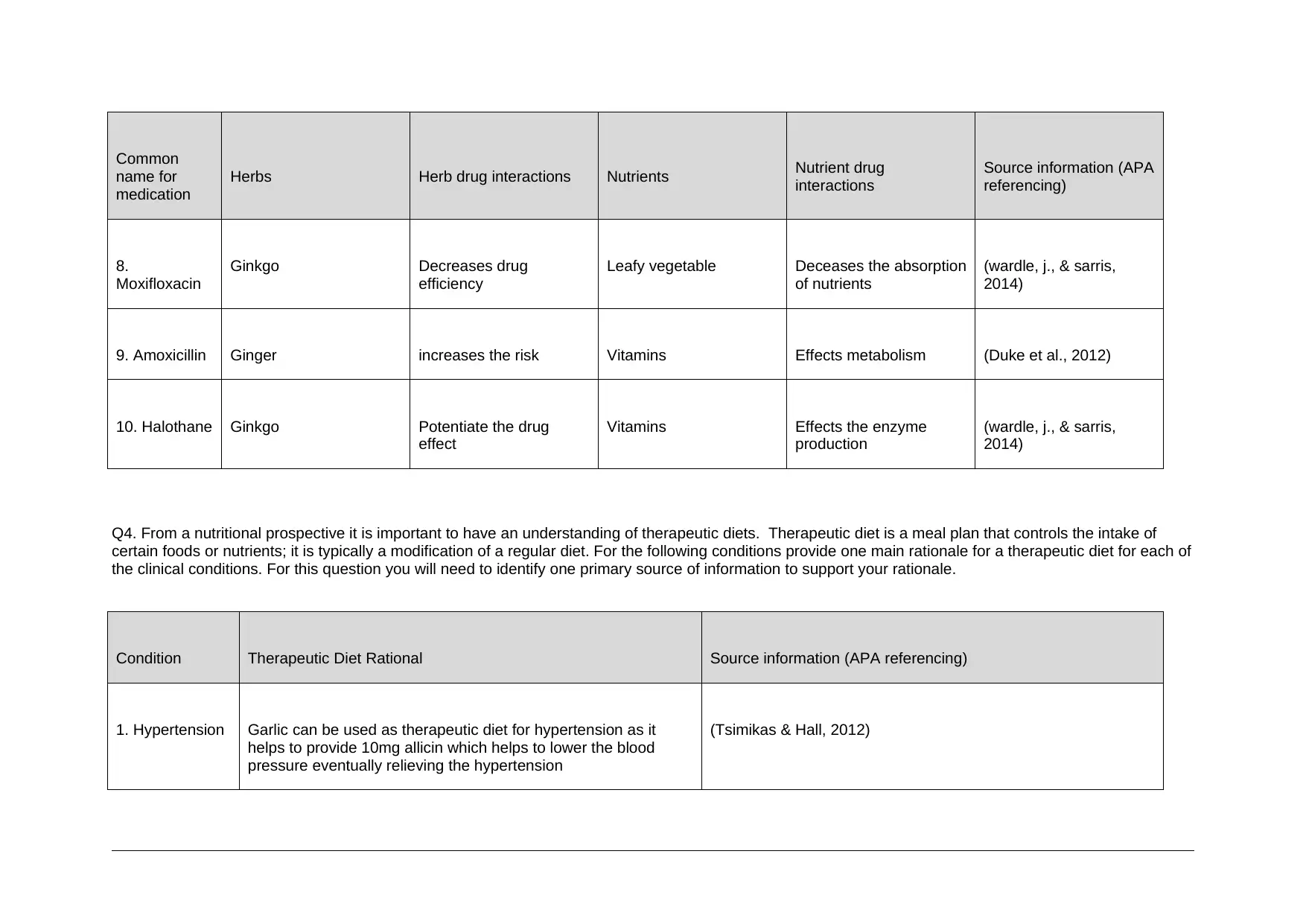
Common
name for
medication
Herbs Herb drug interactions Nutrients Nutrient drug
interactions
Source information (APA
referencing)
8.
Moxifloxacin
Ginkgo Decreases drug
efficiency
Leafy vegetable Deceases the absorption
of nutrients
(wardle, j., & sarris,
2014)
9. Amoxicillin Ginger increases the risk Vitamins Effects metabolism (Duke et al., 2012)
10. Halothane Ginkgo Potentiate the drug
effect
Vitamins Effects the enzyme
production
(wardle, j., & sarris,
2014)
Q4. From a nutritional prospective it is important to have an understanding of therapeutic diets. Therapeutic diet is a meal plan that controls the intake of
certain foods or nutrients; it is typically a modification of a regular diet. For the following conditions provide one main rationale for a therapeutic diet for each of
the clinical conditions. For this question you will need to identify one primary source of information to support your rationale.
Condition Therapeutic Diet Rational Source information (APA referencing)
1. Hypertension Garlic can be used as therapeutic diet for hypertension as it
helps to provide 10mg allicin which helps to lower the blood
pressure eventually relieving the hypertension
(Tsimikas & Hall, 2012)
name for
medication
Herbs Herb drug interactions Nutrients Nutrient drug
interactions
Source information (APA
referencing)
8.
Moxifloxacin
Ginkgo Decreases drug
efficiency
Leafy vegetable Deceases the absorption
of nutrients
(wardle, j., & sarris,
2014)
9. Amoxicillin Ginger increases the risk Vitamins Effects metabolism (Duke et al., 2012)
10. Halothane Ginkgo Potentiate the drug
effect
Vitamins Effects the enzyme
production
(wardle, j., & sarris,
2014)
Q4. From a nutritional prospective it is important to have an understanding of therapeutic diets. Therapeutic diet is a meal plan that controls the intake of
certain foods or nutrients; it is typically a modification of a regular diet. For the following conditions provide one main rationale for a therapeutic diet for each of
the clinical conditions. For this question you will need to identify one primary source of information to support your rationale.
Condition Therapeutic Diet Rational Source information (APA referencing)
1. Hypertension Garlic can be used as therapeutic diet for hypertension as it
helps to provide 10mg allicin which helps to lower the blood
pressure eventually relieving the hypertension
(Tsimikas & Hall, 2012)
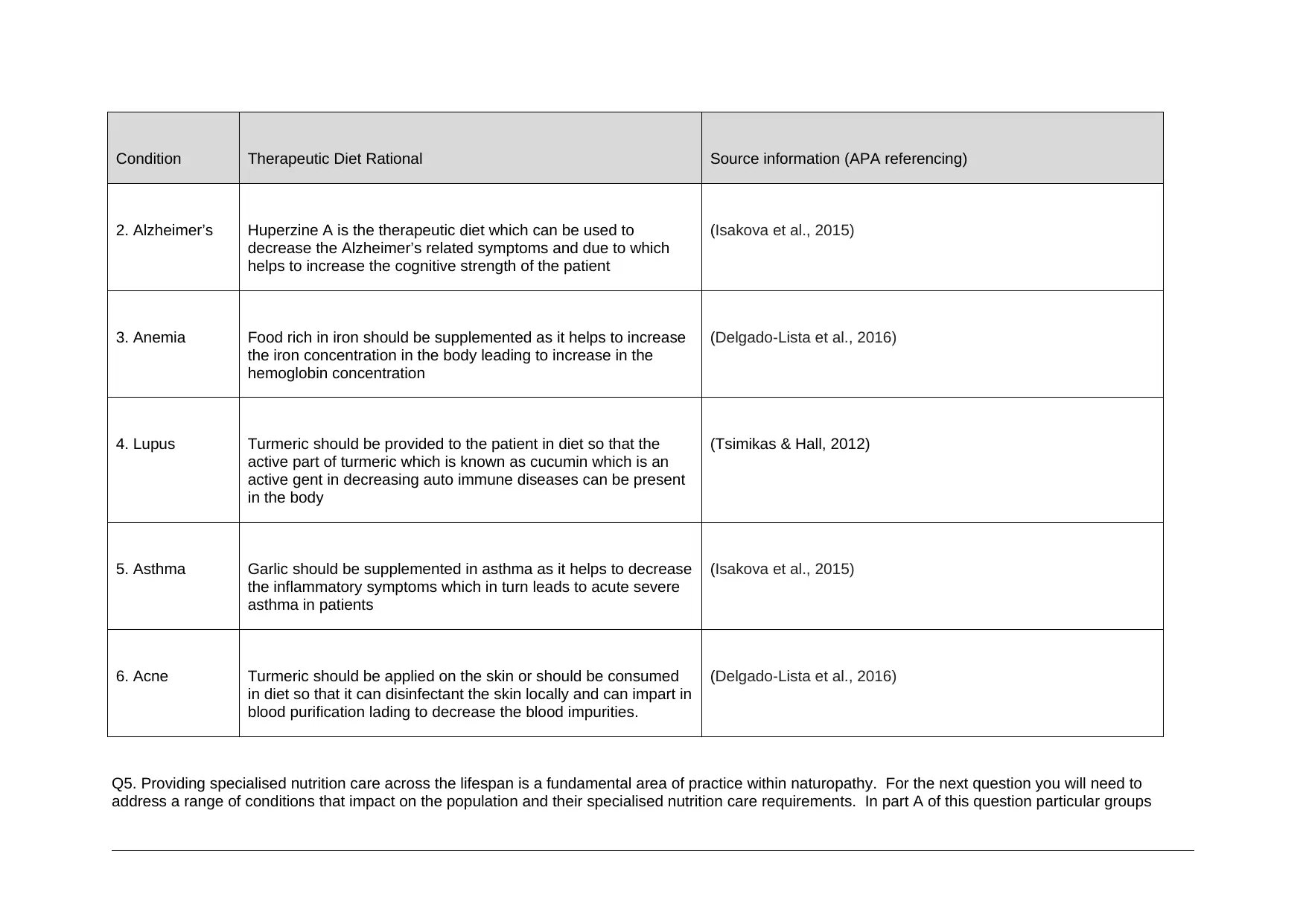
Condition Therapeutic Diet Rational Source information (APA referencing)
2. Alzheimer’s Huperzine A is the therapeutic diet which can be used to
decrease the Alzheimer’s related symptoms and due to which
helps to increase the cognitive strength of the patient
(Isakova et al., 2015)
3. Anemia Food rich in iron should be supplemented as it helps to increase
the iron concentration in the body leading to increase in the
hemoglobin concentration
(Delgado-Lista et al., 2016)
4. Lupus Turmeric should be provided to the patient in diet so that the
active part of turmeric which is known as cucumin which is an
active gent in decreasing auto immune diseases can be present
in the body
(Tsimikas & Hall, 2012)
5. Asthma Garlic should be supplemented in asthma as it helps to decrease
the inflammatory symptoms which in turn leads to acute severe
asthma in patients
(Isakova et al., 2015)
6. Acne Turmeric should be applied on the skin or should be consumed
in diet so that it can disinfectant the skin locally and can impart in
blood purification lading to decrease the blood impurities.
(Delgado-Lista et al., 2016)
Q5. Providing specialised nutrition care across the lifespan is a fundamental area of practice within naturopathy. For the next question you will need to
address a range of conditions that impact on the population and their specialised nutrition care requirements. In part A of this question particular groups
2. Alzheimer’s Huperzine A is the therapeutic diet which can be used to
decrease the Alzheimer’s related symptoms and due to which
helps to increase the cognitive strength of the patient
(Isakova et al., 2015)
3. Anemia Food rich in iron should be supplemented as it helps to increase
the iron concentration in the body leading to increase in the
hemoglobin concentration
(Delgado-Lista et al., 2016)
4. Lupus Turmeric should be provided to the patient in diet so that the
active part of turmeric which is known as cucumin which is an
active gent in decreasing auto immune diseases can be present
in the body
(Tsimikas & Hall, 2012)
5. Asthma Garlic should be supplemented in asthma as it helps to decrease
the inflammatory symptoms which in turn leads to acute severe
asthma in patients
(Isakova et al., 2015)
6. Acne Turmeric should be applied on the skin or should be consumed
in diet so that it can disinfectant the skin locally and can impart in
blood purification lading to decrease the blood impurities.
(Delgado-Lista et al., 2016)
Q5. Providing specialised nutrition care across the lifespan is a fundamental area of practice within naturopathy. For the next question you will need to
address a range of conditions that impact on the population and their specialised nutrition care requirements. In part A of this question particular groups
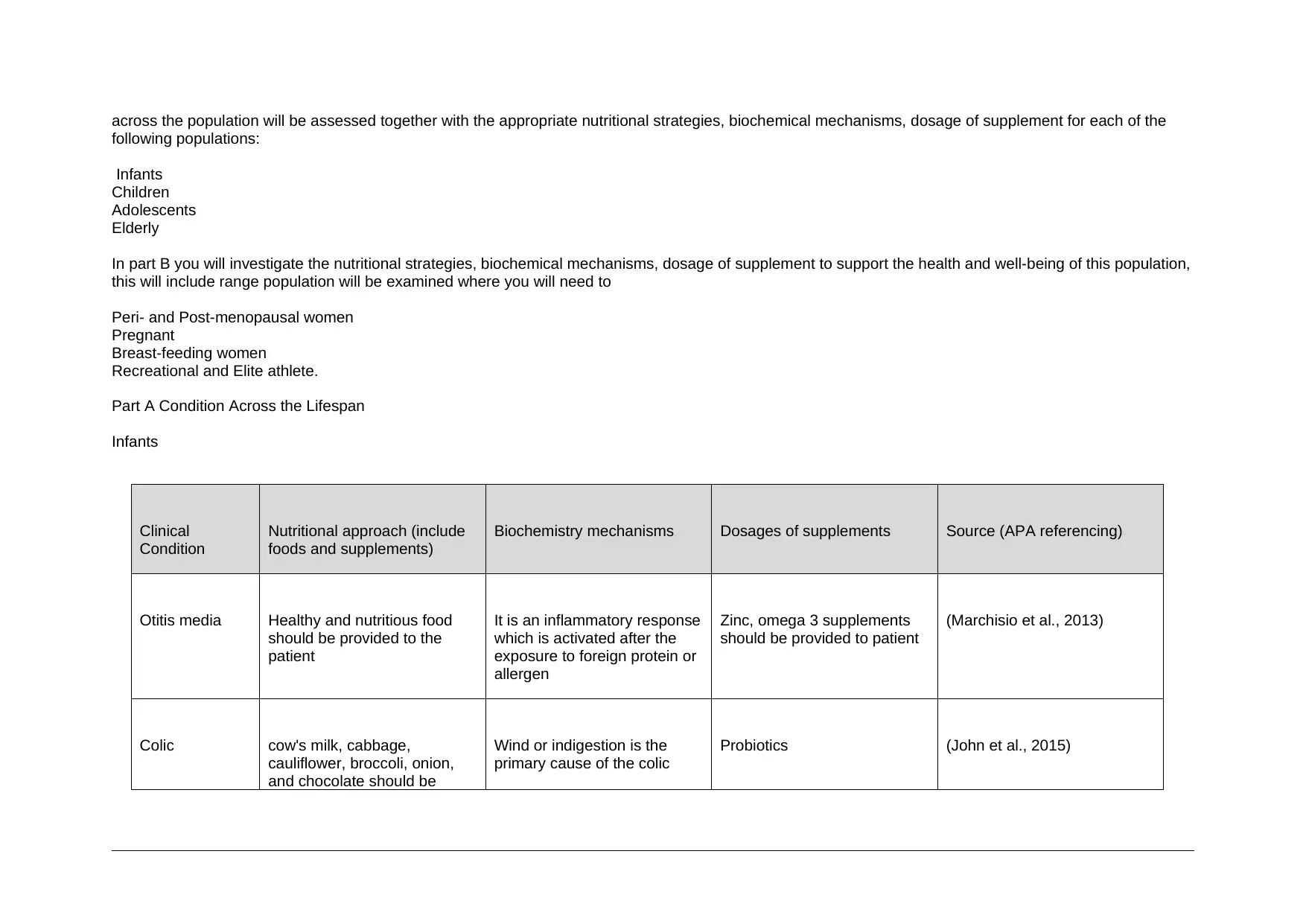
across the population will be assessed together with the appropriate nutritional strategies, biochemical mechanisms, dosage of supplement for each of the
following populations:
Infants
Children
Adolescents
Elderly
In part B you will investigate the nutritional strategies, biochemical mechanisms, dosage of supplement to support the health and well-being of this population,
this will include range population will be examined where you will need to
Peri- and Post-menopausal women
Pregnant
Breast-feeding women
Recreational and Elite athlete.
Part A Condition Across the Lifespan
Infants
Clinical
Condition
Nutritional approach (include
foods and supplements)
Biochemistry mechanisms Dosages of supplements Source (APA referencing)
Otitis media Healthy and nutritious food
should be provided to the
patient
It is an inflammatory response
which is activated after the
exposure to foreign protein or
allergen
Zinc, omega 3 supplements
should be provided to patient
(Marchisio et al., 2013)
Colic cow's milk, cabbage,
cauliflower, broccoli, onion,
and chocolate should be
Wind or indigestion is the
primary cause of the colic
Probiotics (John et al., 2015)
following populations:
Infants
Children
Adolescents
Elderly
In part B you will investigate the nutritional strategies, biochemical mechanisms, dosage of supplement to support the health and well-being of this population,
this will include range population will be examined where you will need to
Peri- and Post-menopausal women
Pregnant
Breast-feeding women
Recreational and Elite athlete.
Part A Condition Across the Lifespan
Infants
Clinical
Condition
Nutritional approach (include
foods and supplements)
Biochemistry mechanisms Dosages of supplements Source (APA referencing)
Otitis media Healthy and nutritious food
should be provided to the
patient
It is an inflammatory response
which is activated after the
exposure to foreign protein or
allergen
Zinc, omega 3 supplements
should be provided to patient
(Marchisio et al., 2013)
Colic cow's milk, cabbage,
cauliflower, broccoli, onion,
and chocolate should be
Wind or indigestion is the
primary cause of the colic
Probiotics (John et al., 2015)
Secure Best Marks with AI Grader
Need help grading? Try our AI Grader for instant feedback on your assignments.
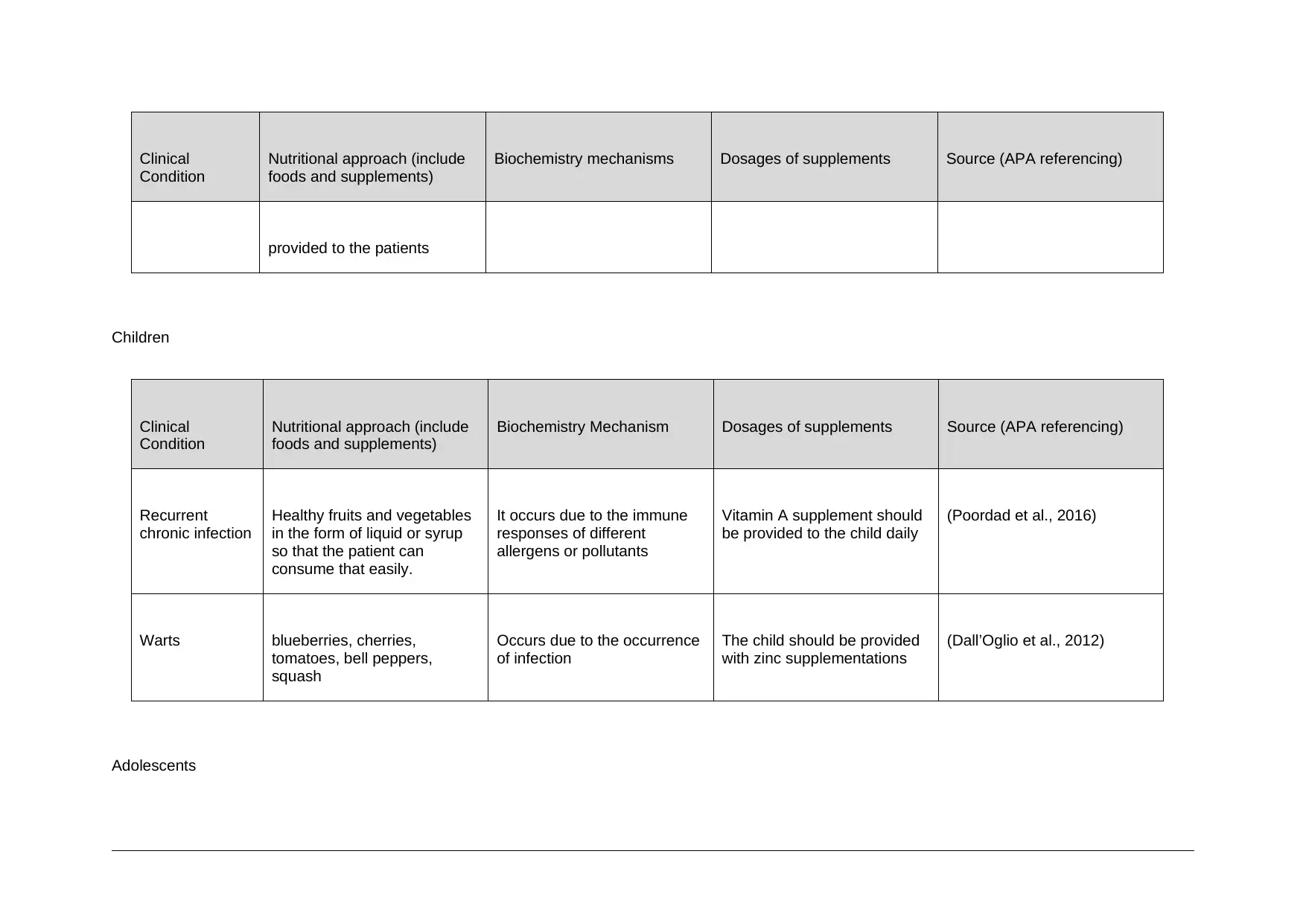
Clinical
Condition
Nutritional approach (include
foods and supplements)
Biochemistry mechanisms Dosages of supplements Source (APA referencing)
provided to the patients
Children
Clinical
Condition
Nutritional approach (include
foods and supplements)
Biochemistry Mechanism Dosages of supplements Source (APA referencing)
Recurrent
chronic infection
Healthy fruits and vegetables
in the form of liquid or syrup
so that the patient can
consume that easily.
It occurs due to the immune
responses of different
allergens or pollutants
Vitamin A supplement should
be provided to the child daily
(Poordad et al., 2016)
Warts blueberries, cherries,
tomatoes, bell peppers,
squash
Occurs due to the occurrence
of infection
The child should be provided
with zinc supplementations
(Dall’Oglio et al., 2012)
Adolescents
Condition
Nutritional approach (include
foods and supplements)
Biochemistry mechanisms Dosages of supplements Source (APA referencing)
provided to the patients
Children
Clinical
Condition
Nutritional approach (include
foods and supplements)
Biochemistry Mechanism Dosages of supplements Source (APA referencing)
Recurrent
chronic infection
Healthy fruits and vegetables
in the form of liquid or syrup
so that the patient can
consume that easily.
It occurs due to the immune
responses of different
allergens or pollutants
Vitamin A supplement should
be provided to the child daily
(Poordad et al., 2016)
Warts blueberries, cherries,
tomatoes, bell peppers,
squash
Occurs due to the occurrence
of infection
The child should be provided
with zinc supplementations
(Dall’Oglio et al., 2012)
Adolescents
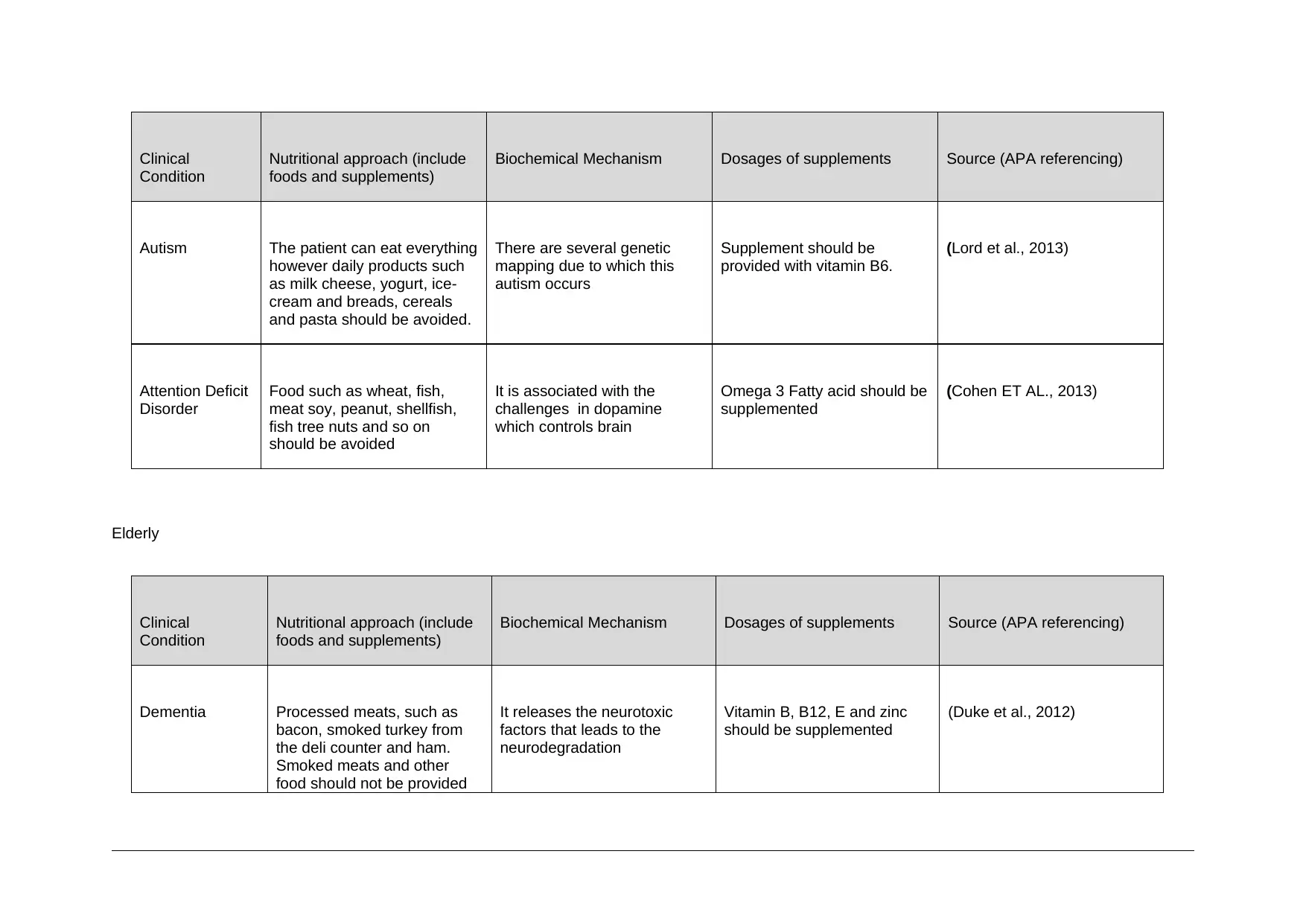
Clinical
Condition
Nutritional approach (include
foods and supplements)
Biochemical Mechanism Dosages of supplements Source (APA referencing)
Autism The patient can eat everything
however daily products such
as milk cheese, yogurt, ice-
cream and breads, cereals
and pasta should be avoided.
There are several genetic
mapping due to which this
autism occurs
Supplement should be
provided with vitamin B6.
(Lord et al., 2013)
Attention Deficit
Disorder
Food such as wheat, fish,
meat soy, peanut, shellfish,
fish tree nuts and so on
should be avoided
It is associated with the
challenges in dopamine
which controls brain
Omega 3 Fatty acid should be
supplemented
(Cohen ET AL., 2013)
Elderly
Clinical
Condition
Nutritional approach (include
foods and supplements)
Biochemical Mechanism Dosages of supplements Source (APA referencing)
Dementia Processed meats, such as
bacon, smoked turkey from
the deli counter and ham.
Smoked meats and other
food should not be provided
It releases the neurotoxic
factors that leads to the
neurodegradation
Vitamin B, B12, E and zinc
should be supplemented
(Duke et al., 2012)
Condition
Nutritional approach (include
foods and supplements)
Biochemical Mechanism Dosages of supplements Source (APA referencing)
Autism The patient can eat everything
however daily products such
as milk cheese, yogurt, ice-
cream and breads, cereals
and pasta should be avoided.
There are several genetic
mapping due to which this
autism occurs
Supplement should be
provided with vitamin B6.
(Lord et al., 2013)
Attention Deficit
Disorder
Food such as wheat, fish,
meat soy, peanut, shellfish,
fish tree nuts and so on
should be avoided
It is associated with the
challenges in dopamine
which controls brain
Omega 3 Fatty acid should be
supplemented
(Cohen ET AL., 2013)
Elderly
Clinical
Condition
Nutritional approach (include
foods and supplements)
Biochemical Mechanism Dosages of supplements Source (APA referencing)
Dementia Processed meats, such as
bacon, smoked turkey from
the deli counter and ham.
Smoked meats and other
food should not be provided
It releases the neurotoxic
factors that leads to the
neurodegradation
Vitamin B, B12, E and zinc
should be supplemented
(Duke et al., 2012)
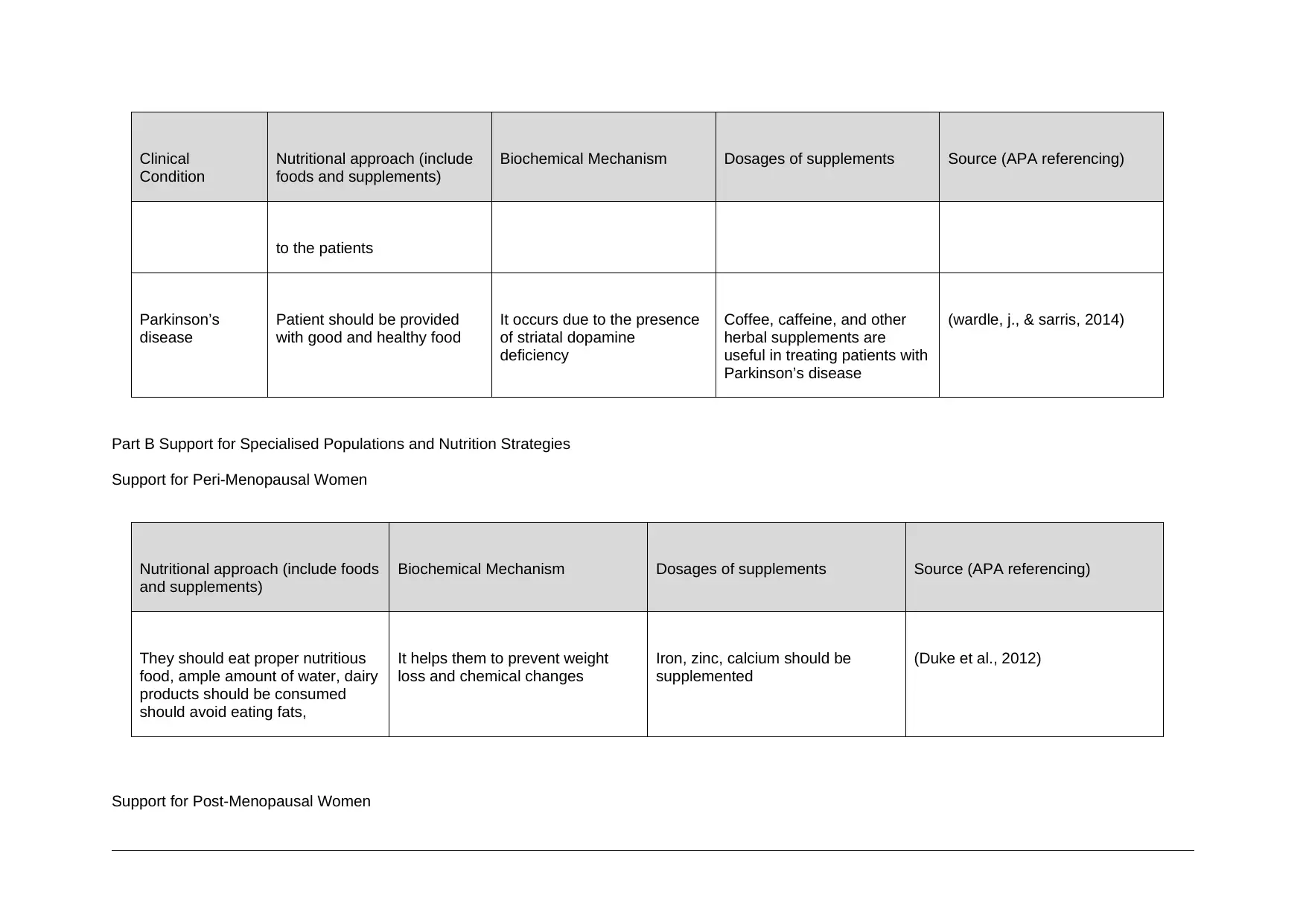
Clinical
Condition
Nutritional approach (include
foods and supplements)
Biochemical Mechanism Dosages of supplements Source (APA referencing)
to the patients
Parkinson’s
disease
Patient should be provided
with good and healthy food
It occurs due to the presence
of striatal dopamine
deficiency
Coffee, caffeine, and other
herbal supplements are
useful in treating patients with
Parkinson’s disease
(wardle, j., & sarris, 2014)
Part B Support for Specialised Populations and Nutrition Strategies
Support for Peri-Menopausal Women
Nutritional approach (include foods
and supplements)
Biochemical Mechanism Dosages of supplements Source (APA referencing)
They should eat proper nutritious
food, ample amount of water, dairy
products should be consumed
should avoid eating fats,
It helps them to prevent weight
loss and chemical changes
Iron, zinc, calcium should be
supplemented
(Duke et al., 2012)
Support for Post-Menopausal Women
Condition
Nutritional approach (include
foods and supplements)
Biochemical Mechanism Dosages of supplements Source (APA referencing)
to the patients
Parkinson’s
disease
Patient should be provided
with good and healthy food
It occurs due to the presence
of striatal dopamine
deficiency
Coffee, caffeine, and other
herbal supplements are
useful in treating patients with
Parkinson’s disease
(wardle, j., & sarris, 2014)
Part B Support for Specialised Populations and Nutrition Strategies
Support for Peri-Menopausal Women
Nutritional approach (include foods
and supplements)
Biochemical Mechanism Dosages of supplements Source (APA referencing)
They should eat proper nutritious
food, ample amount of water, dairy
products should be consumed
should avoid eating fats,
It helps them to prevent weight
loss and chemical changes
Iron, zinc, calcium should be
supplemented
(Duke et al., 2012)
Support for Post-Menopausal Women
Paraphrase This Document
Need a fresh take? Get an instant paraphrase of this document with our AI Paraphraser
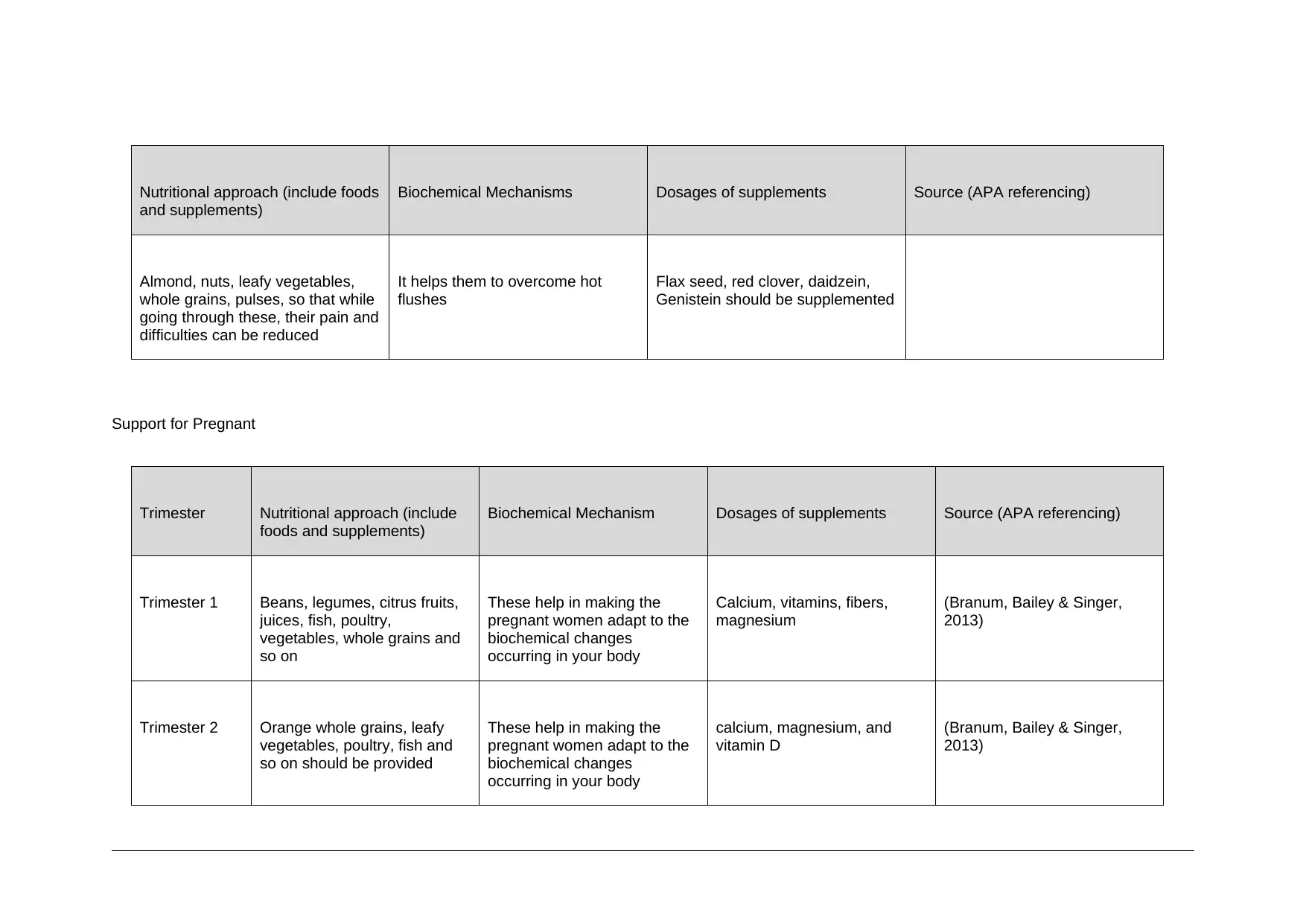
Nutritional approach (include foods
and supplements)
Biochemical Mechanisms Dosages of supplements Source (APA referencing)
Almond, nuts, leafy vegetables,
whole grains, pulses, so that while
going through these, their pain and
difficulties can be reduced
It helps them to overcome hot
flushes
Flax seed, red clover, daidzein,
Genistein should be supplemented
Support for Pregnant
Trimester Nutritional approach (include
foods and supplements)
Biochemical Mechanism Dosages of supplements Source (APA referencing)
Trimester 1 Beans, legumes, citrus fruits,
juices, fish, poultry,
vegetables, whole grains and
so on
These help in making the
pregnant women adapt to the
biochemical changes
occurring in your body
Calcium, vitamins, fibers,
magnesium
(Branum, Bailey & Singer,
2013)
Trimester 2 Orange whole grains, leafy
vegetables, poultry, fish and
so on should be provided
These help in making the
pregnant women adapt to the
biochemical changes
occurring in your body
calcium, magnesium, and
vitamin D
(Branum, Bailey & Singer,
2013)
and supplements)
Biochemical Mechanisms Dosages of supplements Source (APA referencing)
Almond, nuts, leafy vegetables,
whole grains, pulses, so that while
going through these, their pain and
difficulties can be reduced
It helps them to overcome hot
flushes
Flax seed, red clover, daidzein,
Genistein should be supplemented
Support for Pregnant
Trimester Nutritional approach (include
foods and supplements)
Biochemical Mechanism Dosages of supplements Source (APA referencing)
Trimester 1 Beans, legumes, citrus fruits,
juices, fish, poultry,
vegetables, whole grains and
so on
These help in making the
pregnant women adapt to the
biochemical changes
occurring in your body
Calcium, vitamins, fibers,
magnesium
(Branum, Bailey & Singer,
2013)
Trimester 2 Orange whole grains, leafy
vegetables, poultry, fish and
so on should be provided
These help in making the
pregnant women adapt to the
biochemical changes
occurring in your body
calcium, magnesium, and
vitamin D
(Branum, Bailey & Singer,
2013)
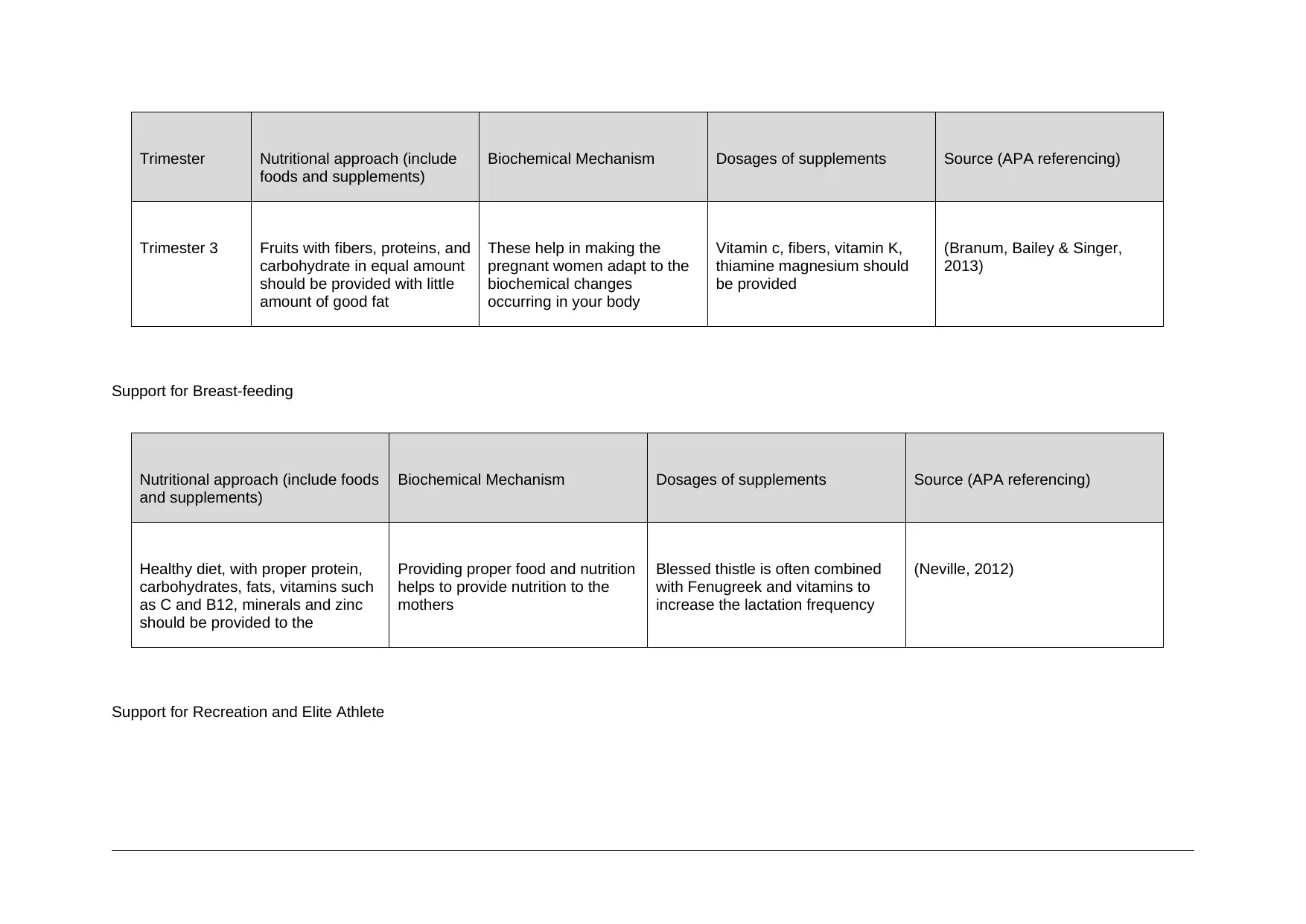
Trimester Nutritional approach (include
foods and supplements)
Biochemical Mechanism Dosages of supplements Source (APA referencing)
Trimester 3 Fruits with fibers, proteins, and
carbohydrate in equal amount
should be provided with little
amount of good fat
These help in making the
pregnant women adapt to the
biochemical changes
occurring in your body
Vitamin c, fibers, vitamin K,
thiamine magnesium should
be provided
(Branum, Bailey & Singer,
2013)
Support for Breast-feeding
Nutritional approach (include foods
and supplements)
Biochemical Mechanism Dosages of supplements Source (APA referencing)
Healthy diet, with proper protein,
carbohydrates, fats, vitamins such
as C and B12, minerals and zinc
should be provided to the
Providing proper food and nutrition
helps to provide nutrition to the
mothers
Blessed thistle is often combined
with Fenugreek and vitamins to
increase the lactation frequency
(Neville, 2012)
Support for Recreation and Elite Athlete
foods and supplements)
Biochemical Mechanism Dosages of supplements Source (APA referencing)
Trimester 3 Fruits with fibers, proteins, and
carbohydrate in equal amount
should be provided with little
amount of good fat
These help in making the
pregnant women adapt to the
biochemical changes
occurring in your body
Vitamin c, fibers, vitamin K,
thiamine magnesium should
be provided
(Branum, Bailey & Singer,
2013)
Support for Breast-feeding
Nutritional approach (include foods
and supplements)
Biochemical Mechanism Dosages of supplements Source (APA referencing)
Healthy diet, with proper protein,
carbohydrates, fats, vitamins such
as C and B12, minerals and zinc
should be provided to the
Providing proper food and nutrition
helps to provide nutrition to the
mothers
Blessed thistle is often combined
with Fenugreek and vitamins to
increase the lactation frequency
(Neville, 2012)
Support for Recreation and Elite Athlete
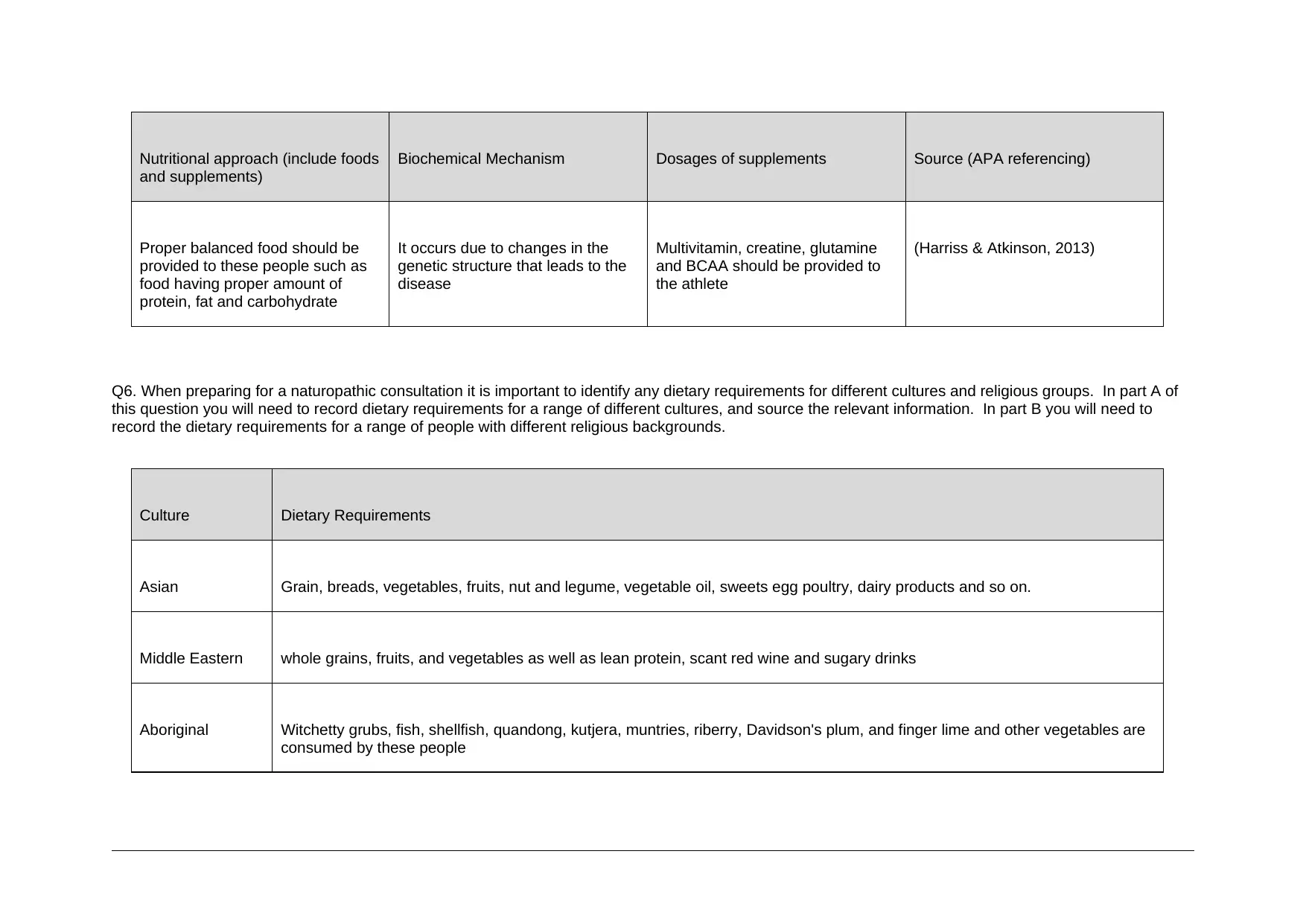
Nutritional approach (include foods
and supplements)
Biochemical Mechanism Dosages of supplements Source (APA referencing)
Proper balanced food should be
provided to these people such as
food having proper amount of
protein, fat and carbohydrate
It occurs due to changes in the
genetic structure that leads to the
disease
Multivitamin, creatine, glutamine
and BCAA should be provided to
the athlete
(Harriss & Atkinson, 2013)
Q6. When preparing for a naturopathic consultation it is important to identify any dietary requirements for different cultures and religious groups. In part A of
this question you will need to record dietary requirements for a range of different cultures, and source the relevant information. In part B you will need to
record the dietary requirements for a range of people with different religious backgrounds.
Culture Dietary Requirements
Asian Grain, breads, vegetables, fruits, nut and legume, vegetable oil, sweets egg poultry, dairy products and so on.
Middle Eastern whole grains, fruits, and vegetables as well as lean protein, scant red wine and sugary drinks
Aboriginal Witchetty grubs, fish, shellfish, quandong, kutjera, muntries, riberry, Davidson's plum, and finger lime and other vegetables are
consumed by these people
and supplements)
Biochemical Mechanism Dosages of supplements Source (APA referencing)
Proper balanced food should be
provided to these people such as
food having proper amount of
protein, fat and carbohydrate
It occurs due to changes in the
genetic structure that leads to the
disease
Multivitamin, creatine, glutamine
and BCAA should be provided to
the athlete
(Harriss & Atkinson, 2013)
Q6. When preparing for a naturopathic consultation it is important to identify any dietary requirements for different cultures and religious groups. In part A of
this question you will need to record dietary requirements for a range of different cultures, and source the relevant information. In part B you will need to
record the dietary requirements for a range of people with different religious backgrounds.
Culture Dietary Requirements
Asian Grain, breads, vegetables, fruits, nut and legume, vegetable oil, sweets egg poultry, dairy products and so on.
Middle Eastern whole grains, fruits, and vegetables as well as lean protein, scant red wine and sugary drinks
Aboriginal Witchetty grubs, fish, shellfish, quandong, kutjera, muntries, riberry, Davidson's plum, and finger lime and other vegetables are
consumed by these people
Secure Best Marks with AI Grader
Need help grading? Try our AI Grader for instant feedback on your assignments.
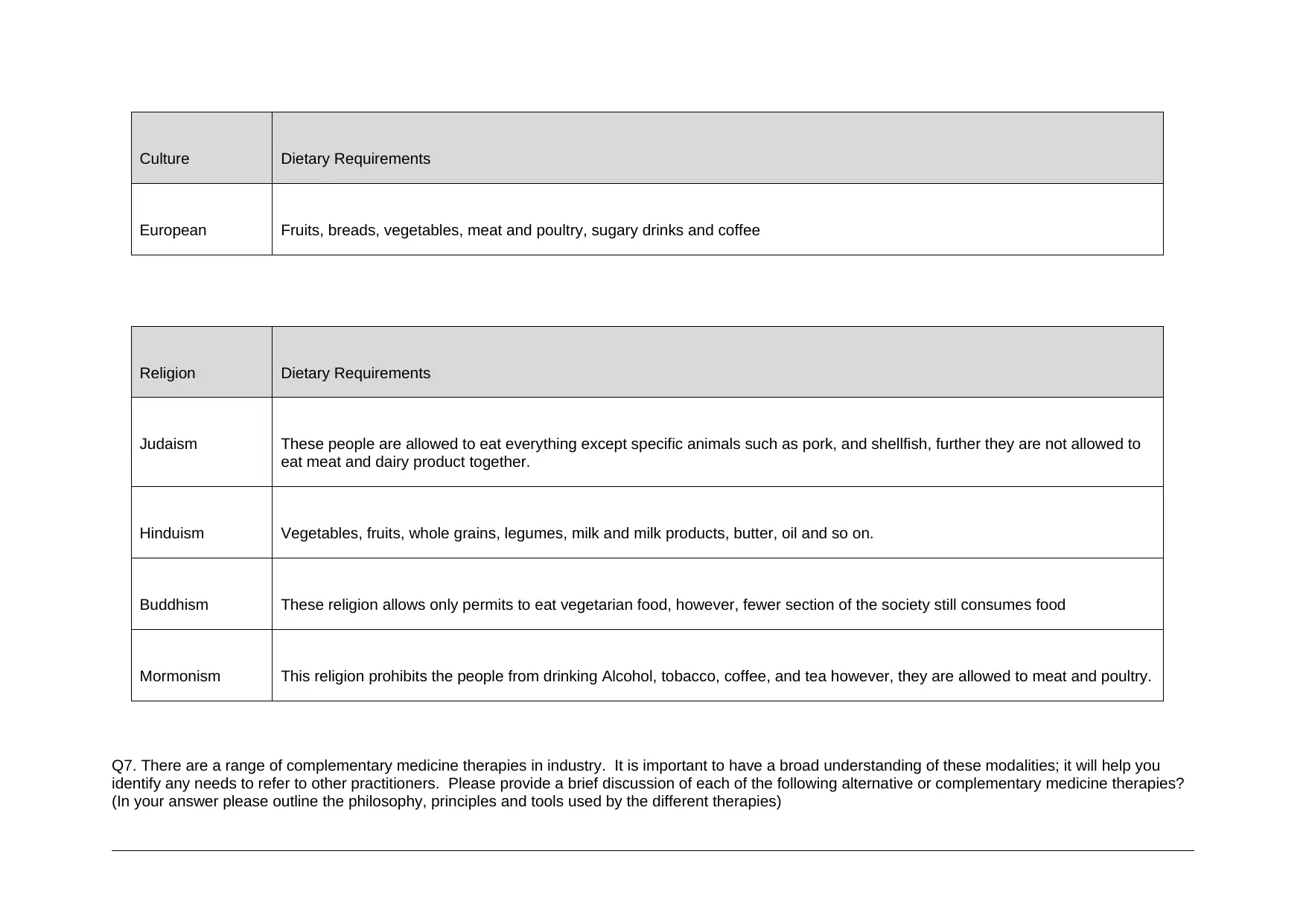
Culture Dietary Requirements
European Fruits, breads, vegetables, meat and poultry, sugary drinks and coffee
Religion Dietary Requirements
Judaism These people are allowed to eat everything except specific animals such as pork, and shellfish, further they are not allowed to
eat meat and dairy product together.
Hinduism Vegetables, fruits, whole grains, legumes, milk and milk products, butter, oil and so on.
Buddhism These religion allows only permits to eat vegetarian food, however, fewer section of the society still consumes food
Mormonism This religion prohibits the people from drinking Alcohol, tobacco, coffee, and tea however, they are allowed to meat and poultry.
Q7. There are a range of complementary medicine therapies in industry. It is important to have a broad understanding of these modalities; it will help you
identify any needs to refer to other practitioners. Please provide a brief discussion of each of the following alternative or complementary medicine therapies?
(In your answer please outline the philosophy, principles and tools used by the different therapies)
European Fruits, breads, vegetables, meat and poultry, sugary drinks and coffee
Religion Dietary Requirements
Judaism These people are allowed to eat everything except specific animals such as pork, and shellfish, further they are not allowed to
eat meat and dairy product together.
Hinduism Vegetables, fruits, whole grains, legumes, milk and milk products, butter, oil and so on.
Buddhism These religion allows only permits to eat vegetarian food, however, fewer section of the society still consumes food
Mormonism This religion prohibits the people from drinking Alcohol, tobacco, coffee, and tea however, they are allowed to meat and poultry.
Q7. There are a range of complementary medicine therapies in industry. It is important to have a broad understanding of these modalities; it will help you
identify any needs to refer to other practitioners. Please provide a brief discussion of each of the following alternative or complementary medicine therapies?
(In your answer please outline the philosophy, principles and tools used by the different therapies)
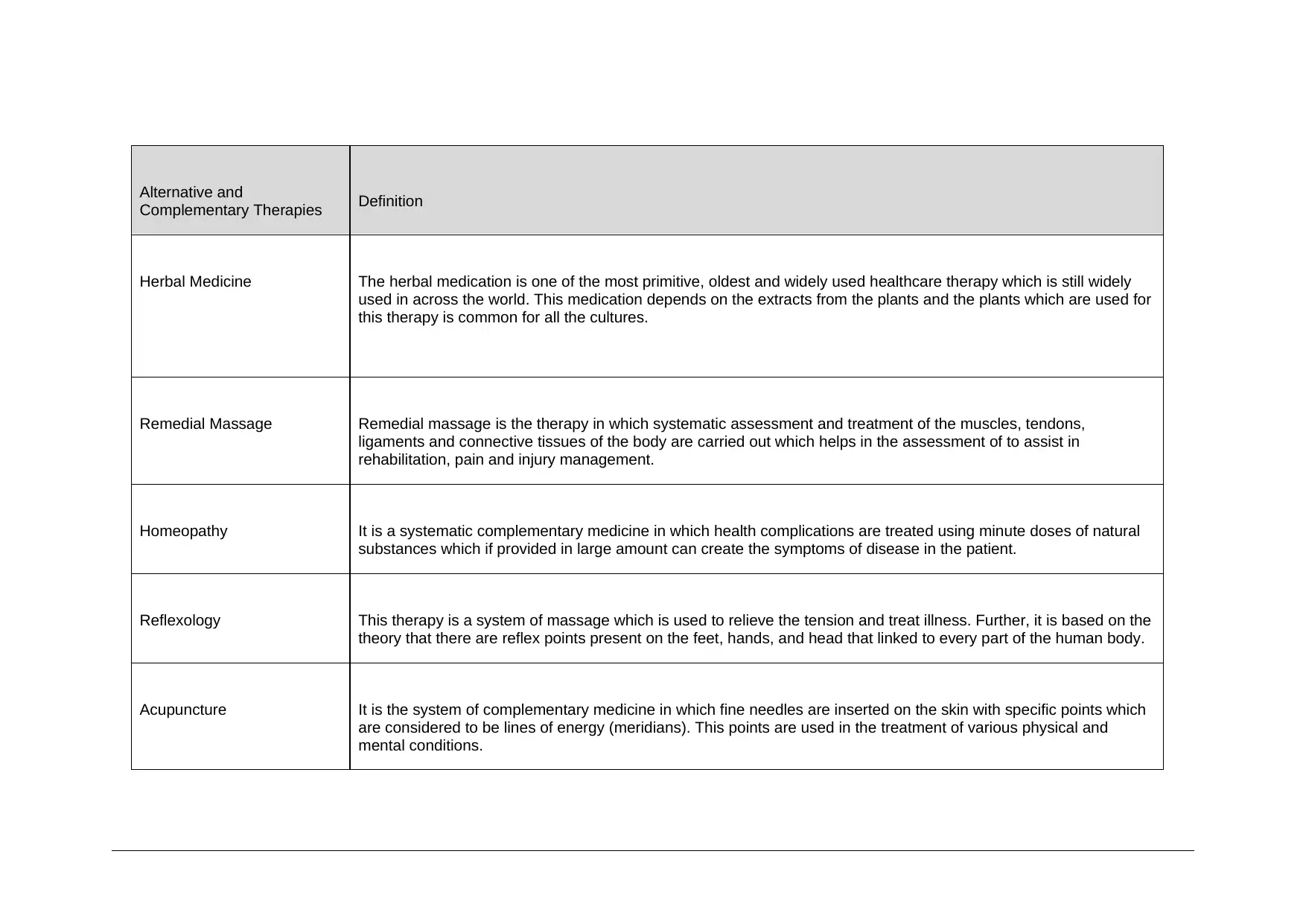
Alternative and
Complementary Therapies Definition
Herbal Medicine The herbal medication is one of the most primitive, oldest and widely used healthcare therapy which is still widely
used in across the world. This medication depends on the extracts from the plants and the plants which are used for
this therapy is common for all the cultures.
Remedial Massage Remedial massage is the therapy in which systematic assessment and treatment of the muscles, tendons,
ligaments and connective tissues of the body are carried out which helps in the assessment of to assist in
rehabilitation, pain and injury management.
Homeopathy It is a systematic complementary medicine in which health complications are treated using minute doses of natural
substances which if provided in large amount can create the symptoms of disease in the patient.
Reflexology This therapy is a system of massage which is used to relieve the tension and treat illness. Further, it is based on the
theory that there are reflex points present on the feet, hands, and head that linked to every part of the human body.
Acupuncture It is the system of complementary medicine in which fine needles are inserted on the skin with specific points which
are considered to be lines of energy (meridians). This points are used in the treatment of various physical and
mental conditions.
Complementary Therapies Definition
Herbal Medicine The herbal medication is one of the most primitive, oldest and widely used healthcare therapy which is still widely
used in across the world. This medication depends on the extracts from the plants and the plants which are used for
this therapy is common for all the cultures.
Remedial Massage Remedial massage is the therapy in which systematic assessment and treatment of the muscles, tendons,
ligaments and connective tissues of the body are carried out which helps in the assessment of to assist in
rehabilitation, pain and injury management.
Homeopathy It is a systematic complementary medicine in which health complications are treated using minute doses of natural
substances which if provided in large amount can create the symptoms of disease in the patient.
Reflexology This therapy is a system of massage which is used to relieve the tension and treat illness. Further, it is based on the
theory that there are reflex points present on the feet, hands, and head that linked to every part of the human body.
Acupuncture It is the system of complementary medicine in which fine needles are inserted on the skin with specific points which
are considered to be lines of energy (meridians). This points are used in the treatment of various physical and
mental conditions.
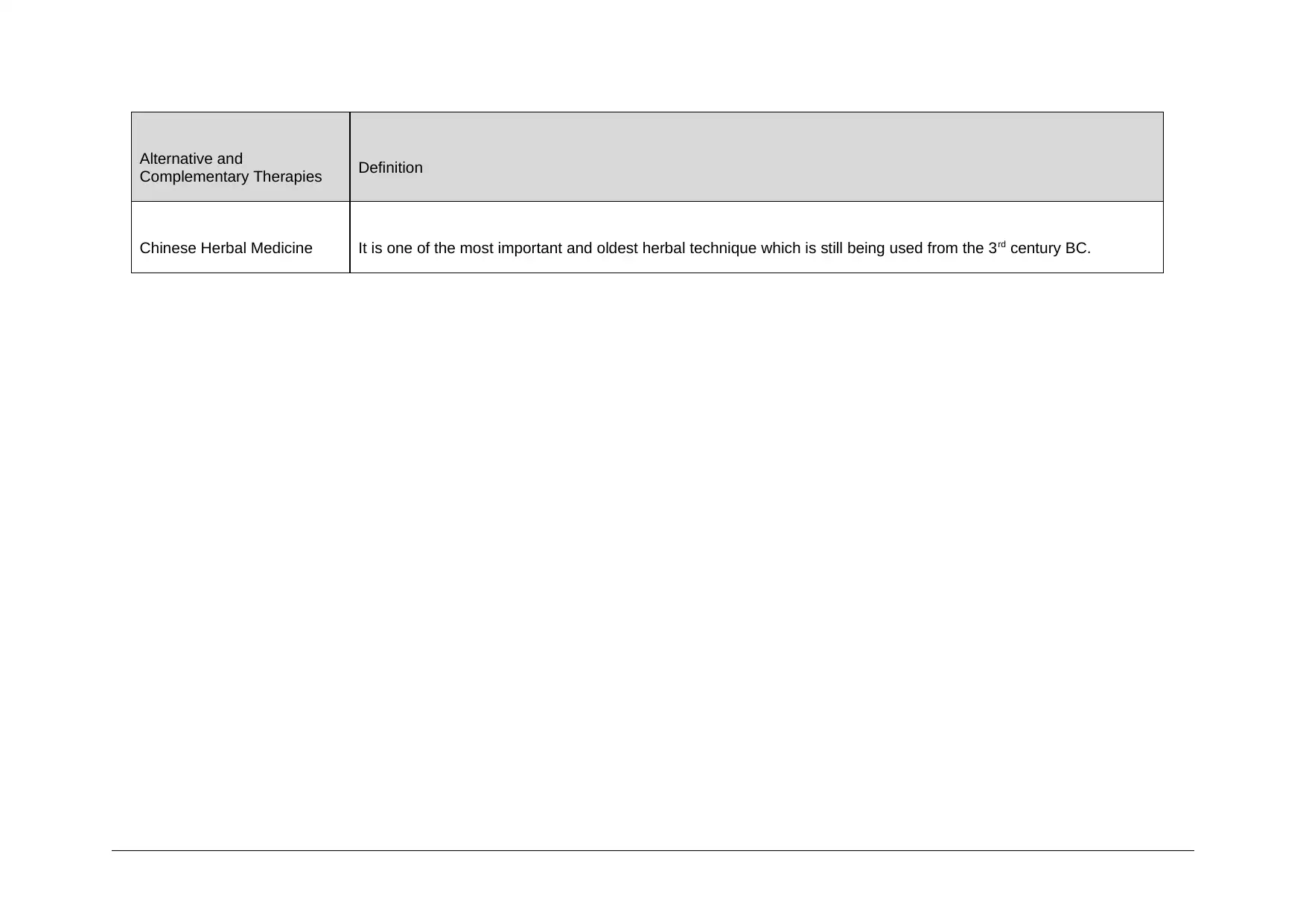
Alternative and
Complementary Therapies Definition
Chinese Herbal Medicine It is one of the most important and oldest herbal technique which is still being used from the 3rd century BC.
Complementary Therapies Definition
Chinese Herbal Medicine It is one of the most important and oldest herbal technique which is still being used from the 3rd century BC.
Paraphrase This Document
Need a fresh take? Get an instant paraphrase of this document with our AI Paraphraser
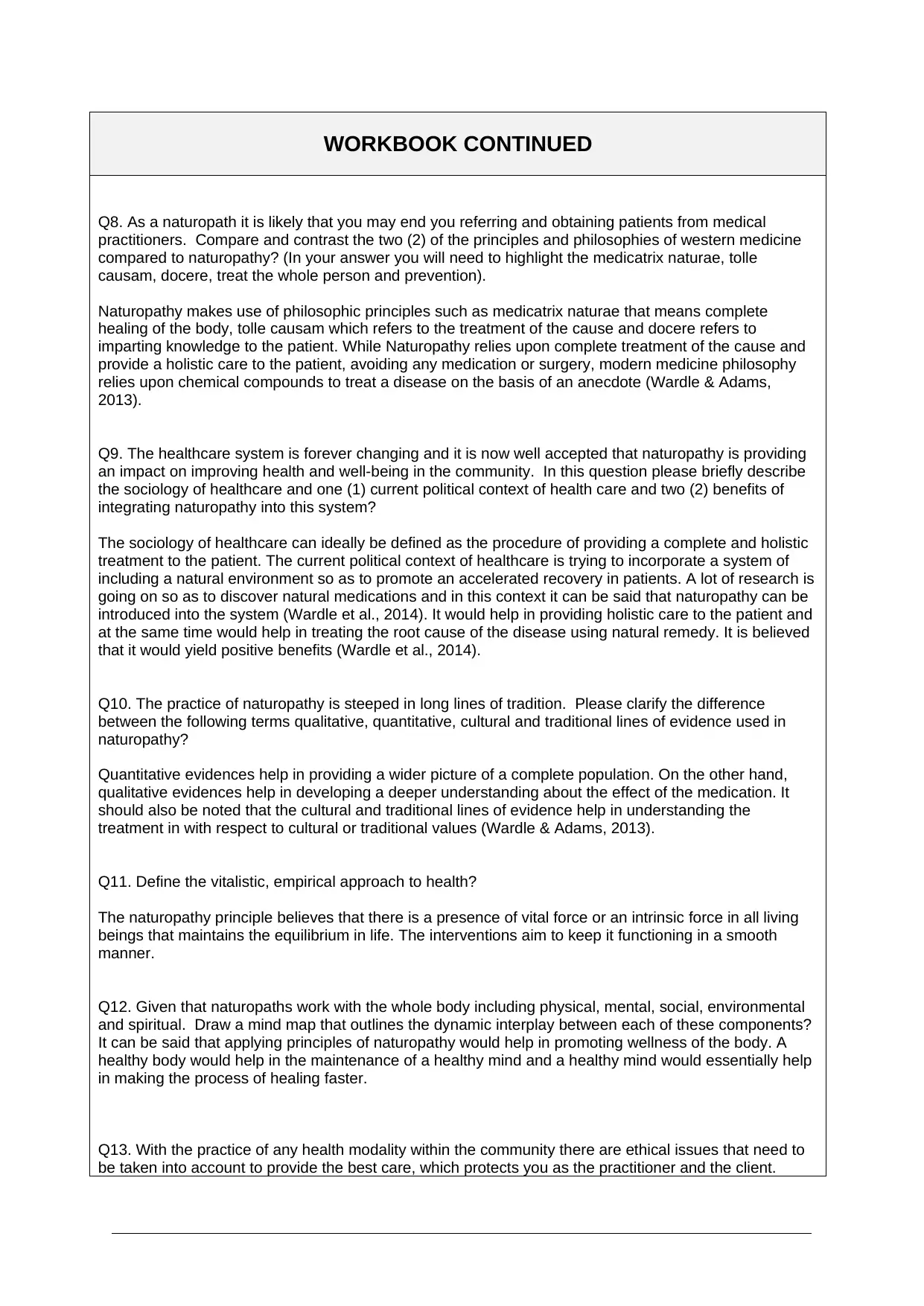
WORKBOOK CONTINUED
Q8. As a naturopath it is likely that you may end you referring and obtaining patients from medical
practitioners. Compare and contrast the two (2) of the principles and philosophies of western medicine
compared to naturopathy? (In your answer you will need to highlight the medicatrix naturae, tolle
causam, docere, treat the whole person and prevention).
Naturopathy makes use of philosophic principles such as medicatrix naturae that means complete
healing of the body, tolle causam which refers to the treatment of the cause and docere refers to
imparting knowledge to the patient. While Naturopathy relies upon complete treatment of the cause and
provide a holistic care to the patient, avoiding any medication or surgery, modern medicine philosophy
relies upon chemical compounds to treat a disease on the basis of an anecdote (Wardle & Adams,
2013).
Q9. The healthcare system is forever changing and it is now well accepted that naturopathy is providing
an impact on improving health and well-being in the community. In this question please briefly describe
the sociology of healthcare and one (1) current political context of health care and two (2) benefits of
integrating naturopathy into this system?
The sociology of healthcare can ideally be defined as the procedure of providing a complete and holistic
treatment to the patient. The current political context of healthcare is trying to incorporate a system of
including a natural environment so as to promote an accelerated recovery in patients. A lot of research is
going on so as to discover natural medications and in this context it can be said that naturopathy can be
introduced into the system (Wardle et al., 2014). It would help in providing holistic care to the patient and
at the same time would help in treating the root cause of the disease using natural remedy. It is believed
that it would yield positive benefits (Wardle et al., 2014).
Q10. The practice of naturopathy is steeped in long lines of tradition. Please clarify the difference
between the following terms qualitative, quantitative, cultural and traditional lines of evidence used in
naturopathy?
Quantitative evidences help in providing a wider picture of a complete population. On the other hand,
qualitative evidences help in developing a deeper understanding about the effect of the medication. It
should also be noted that the cultural and traditional lines of evidence help in understanding the
treatment in with respect to cultural or traditional values (Wardle & Adams, 2013).
Q11. Define the vitalistic, empirical approach to health?
The naturopathy principle believes that there is a presence of vital force or an intrinsic force in all living
beings that maintains the equilibrium in life. The interventions aim to keep it functioning in a smooth
manner.
Q12. Given that naturopaths work with the whole body including physical, mental, social, environmental
and spiritual. Draw a mind map that outlines the dynamic interplay between each of these components?
It can be said that applying principles of naturopathy would help in promoting wellness of the body. A
healthy body would help in the maintenance of a healthy mind and a healthy mind would essentially help
in making the process of healing faster.
Q13. With the practice of any health modality within the community there are ethical issues that need to
be taken into account to provide the best care, which protects you as the practitioner and the client.
Q8. As a naturopath it is likely that you may end you referring and obtaining patients from medical
practitioners. Compare and contrast the two (2) of the principles and philosophies of western medicine
compared to naturopathy? (In your answer you will need to highlight the medicatrix naturae, tolle
causam, docere, treat the whole person and prevention).
Naturopathy makes use of philosophic principles such as medicatrix naturae that means complete
healing of the body, tolle causam which refers to the treatment of the cause and docere refers to
imparting knowledge to the patient. While Naturopathy relies upon complete treatment of the cause and
provide a holistic care to the patient, avoiding any medication or surgery, modern medicine philosophy
relies upon chemical compounds to treat a disease on the basis of an anecdote (Wardle & Adams,
2013).
Q9. The healthcare system is forever changing and it is now well accepted that naturopathy is providing
an impact on improving health and well-being in the community. In this question please briefly describe
the sociology of healthcare and one (1) current political context of health care and two (2) benefits of
integrating naturopathy into this system?
The sociology of healthcare can ideally be defined as the procedure of providing a complete and holistic
treatment to the patient. The current political context of healthcare is trying to incorporate a system of
including a natural environment so as to promote an accelerated recovery in patients. A lot of research is
going on so as to discover natural medications and in this context it can be said that naturopathy can be
introduced into the system (Wardle et al., 2014). It would help in providing holistic care to the patient and
at the same time would help in treating the root cause of the disease using natural remedy. It is believed
that it would yield positive benefits (Wardle et al., 2014).
Q10. The practice of naturopathy is steeped in long lines of tradition. Please clarify the difference
between the following terms qualitative, quantitative, cultural and traditional lines of evidence used in
naturopathy?
Quantitative evidences help in providing a wider picture of a complete population. On the other hand,
qualitative evidences help in developing a deeper understanding about the effect of the medication. It
should also be noted that the cultural and traditional lines of evidence help in understanding the
treatment in with respect to cultural or traditional values (Wardle & Adams, 2013).
Q11. Define the vitalistic, empirical approach to health?
The naturopathy principle believes that there is a presence of vital force or an intrinsic force in all living
beings that maintains the equilibrium in life. The interventions aim to keep it functioning in a smooth
manner.
Q12. Given that naturopaths work with the whole body including physical, mental, social, environmental
and spiritual. Draw a mind map that outlines the dynamic interplay between each of these components?
It can be said that applying principles of naturopathy would help in promoting wellness of the body. A
healthy body would help in the maintenance of a healthy mind and a healthy mind would essentially help
in making the process of healing faster.
Q13. With the practice of any health modality within the community there are ethical issues that need to
be taken into account to provide the best care, which protects you as the practitioner and the client.
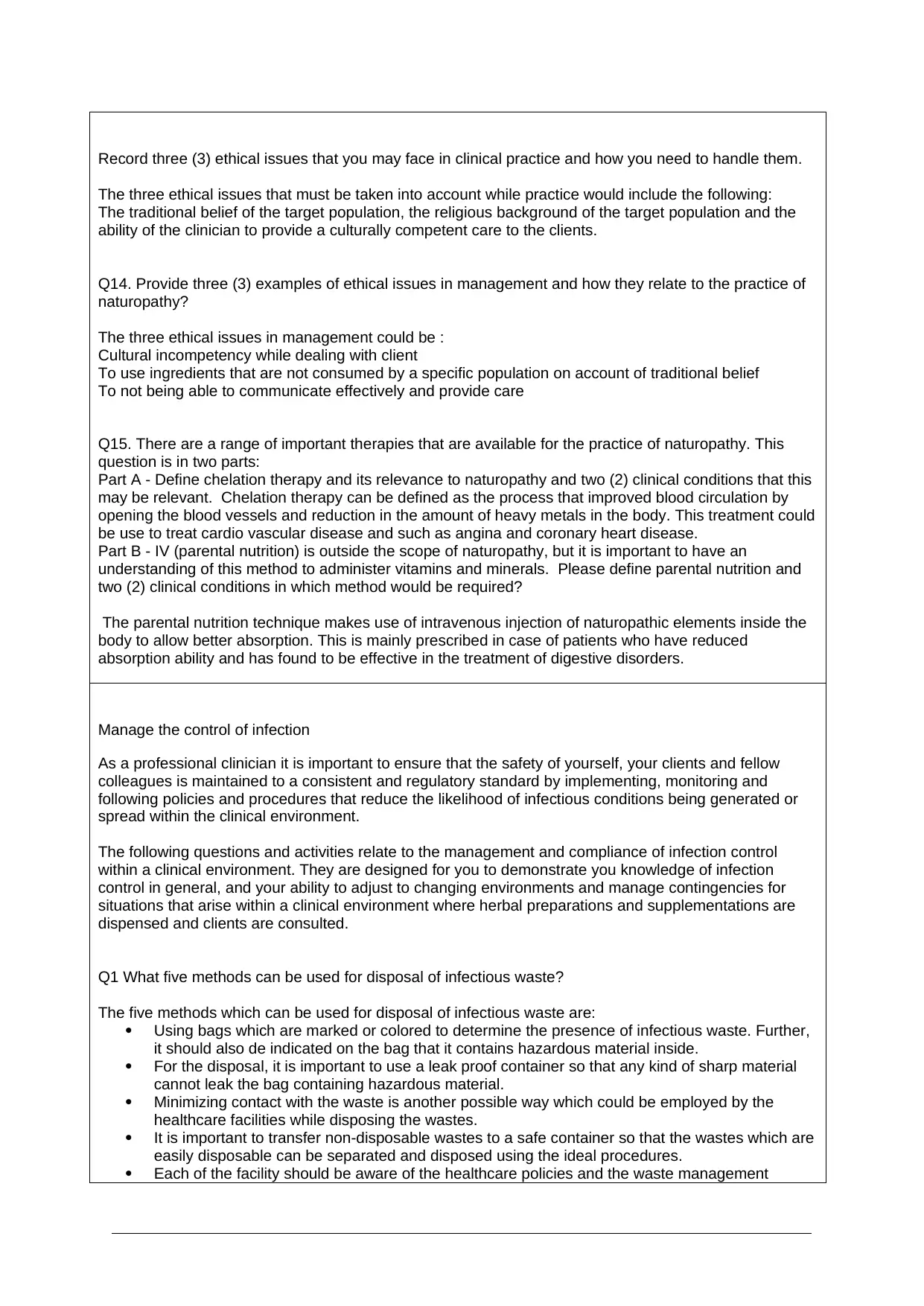
Record three (3) ethical issues that you may face in clinical practice and how you need to handle them.
The three ethical issues that must be taken into account while practice would include the following:
The traditional belief of the target population, the religious background of the target population and the
ability of the clinician to provide a culturally competent care to the clients.
Q14. Provide three (3) examples of ethical issues in management and how they relate to the practice of
naturopathy?
The three ethical issues in management could be :
Cultural incompetency while dealing with client
To use ingredients that are not consumed by a specific population on account of traditional belief
To not being able to communicate effectively and provide care
Q15. There are a range of important therapies that are available for the practice of naturopathy. This
question is in two parts:
Part A - Define chelation therapy and its relevance to naturopathy and two (2) clinical conditions that this
may be relevant. Chelation therapy can be defined as the process that improved blood circulation by
opening the blood vessels and reduction in the amount of heavy metals in the body. This treatment could
be use to treat cardio vascular disease and such as angina and coronary heart disease.
Part B - IV (parental nutrition) is outside the scope of naturopathy, but it is important to have an
understanding of this method to administer vitamins and minerals. Please define parental nutrition and
two (2) clinical conditions in which method would be required?
The parental nutrition technique makes use of intravenous injection of naturopathic elements inside the
body to allow better absorption. This is mainly prescribed in case of patients who have reduced
absorption ability and has found to be effective in the treatment of digestive disorders.
Manage the control of infection
As a professional clinician it is important to ensure that the safety of yourself, your clients and fellow
colleagues is maintained to a consistent and regulatory standard by implementing, monitoring and
following policies and procedures that reduce the likelihood of infectious conditions being generated or
spread within the clinical environment.
The following questions and activities relate to the management and compliance of infection control
within a clinical environment. They are designed for you to demonstrate you knowledge of infection
control in general, and your ability to adjust to changing environments and manage contingencies for
situations that arise within a clinical environment where herbal preparations and supplementations are
dispensed and clients are consulted.
Q1 What five methods can be used for disposal of infectious waste?
The five methods which can be used for disposal of infectious waste are:
Using bags which are marked or colored to determine the presence of infectious waste. Further,
it should also de indicated on the bag that it contains hazardous material inside.
For the disposal, it is important to use a leak proof container so that any kind of sharp material
cannot leak the bag containing hazardous material.
Minimizing contact with the waste is another possible way which could be employed by the
healthcare facilities while disposing the wastes.
It is important to transfer non-disposable wastes to a safe container so that the wastes which are
easily disposable can be separated and disposed using the ideal procedures.
Each of the facility should be aware of the healthcare policies and the waste management
The three ethical issues that must be taken into account while practice would include the following:
The traditional belief of the target population, the religious background of the target population and the
ability of the clinician to provide a culturally competent care to the clients.
Q14. Provide three (3) examples of ethical issues in management and how they relate to the practice of
naturopathy?
The three ethical issues in management could be :
Cultural incompetency while dealing with client
To use ingredients that are not consumed by a specific population on account of traditional belief
To not being able to communicate effectively and provide care
Q15. There are a range of important therapies that are available for the practice of naturopathy. This
question is in two parts:
Part A - Define chelation therapy and its relevance to naturopathy and two (2) clinical conditions that this
may be relevant. Chelation therapy can be defined as the process that improved blood circulation by
opening the blood vessels and reduction in the amount of heavy metals in the body. This treatment could
be use to treat cardio vascular disease and such as angina and coronary heart disease.
Part B - IV (parental nutrition) is outside the scope of naturopathy, but it is important to have an
understanding of this method to administer vitamins and minerals. Please define parental nutrition and
two (2) clinical conditions in which method would be required?
The parental nutrition technique makes use of intravenous injection of naturopathic elements inside the
body to allow better absorption. This is mainly prescribed in case of patients who have reduced
absorption ability and has found to be effective in the treatment of digestive disorders.
Manage the control of infection
As a professional clinician it is important to ensure that the safety of yourself, your clients and fellow
colleagues is maintained to a consistent and regulatory standard by implementing, monitoring and
following policies and procedures that reduce the likelihood of infectious conditions being generated or
spread within the clinical environment.
The following questions and activities relate to the management and compliance of infection control
within a clinical environment. They are designed for you to demonstrate you knowledge of infection
control in general, and your ability to adjust to changing environments and manage contingencies for
situations that arise within a clinical environment where herbal preparations and supplementations are
dispensed and clients are consulted.
Q1 What five methods can be used for disposal of infectious waste?
The five methods which can be used for disposal of infectious waste are:
Using bags which are marked or colored to determine the presence of infectious waste. Further,
it should also de indicated on the bag that it contains hazardous material inside.
For the disposal, it is important to use a leak proof container so that any kind of sharp material
cannot leak the bag containing hazardous material.
Minimizing contact with the waste is another possible way which could be employed by the
healthcare facilities while disposing the wastes.
It is important to transfer non-disposable wastes to a safe container so that the wastes which are
easily disposable can be separated and disposed using the ideal procedures.
Each of the facility should be aware of the healthcare policies and the waste management
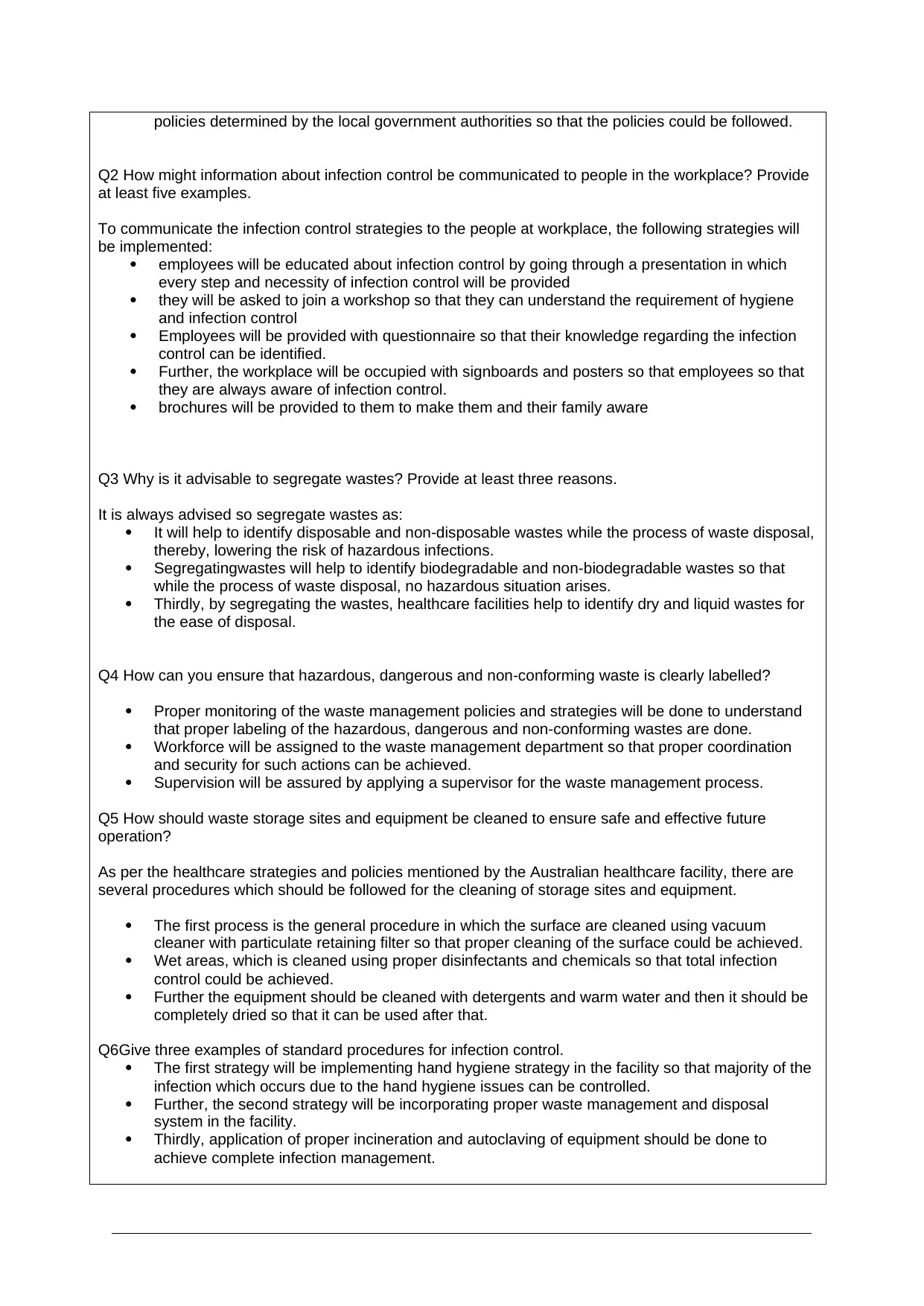
policies determined by the local government authorities so that the policies could be followed.
Q2 How might information about infection control be communicated to people in the workplace? Provide
at least five examples.
To communicate the infection control strategies to the people at workplace, the following strategies will
be implemented:
employees will be educated about infection control by going through a presentation in which
every step and necessity of infection control will be provided
they will be asked to join a workshop so that they can understand the requirement of hygiene
and infection control
Employees will be provided with questionnaire so that their knowledge regarding the infection
control can be identified.
Further, the workplace will be occupied with signboards and posters so that employees so that
they are always aware of infection control.
brochures will be provided to them to make them and their family aware
Q3 Why is it advisable to segregate wastes? Provide at least three reasons.
It is always advised so segregate wastes as:
It will help to identify disposable and non-disposable wastes while the process of waste disposal,
thereby, lowering the risk of hazardous infections.
Segregatingwastes will help to identify biodegradable and non-biodegradable wastes so that
while the process of waste disposal, no hazardous situation arises.
Thirdly, by segregating the wastes, healthcare facilities help to identify dry and liquid wastes for
the ease of disposal.
Q4 How can you ensure that hazardous, dangerous and non-conforming waste is clearly labelled?
Proper monitoring of the waste management policies and strategies will be done to understand
that proper labeling of the hazardous, dangerous and non-conforming wastes are done.
Workforce will be assigned to the waste management department so that proper coordination
and security for such actions can be achieved.
Supervision will be assured by applying a supervisor for the waste management process.
Q5 How should waste storage sites and equipment be cleaned to ensure safe and effective future
operation?
As per the healthcare strategies and policies mentioned by the Australian healthcare facility, there are
several procedures which should be followed for the cleaning of storage sites and equipment.
The first process is the general procedure in which the surface are cleaned using vacuum
cleaner with particulate retaining filter so that proper cleaning of the surface could be achieved.
Wet areas, which is cleaned using proper disinfectants and chemicals so that total infection
control could be achieved.
Further the equipment should be cleaned with detergents and warm water and then it should be
completely dried so that it can be used after that.
Q6Give three examples of standard procedures for infection control.
The first strategy will be implementing hand hygiene strategy in the facility so that majority of the
infection which occurs due to the hand hygiene issues can be controlled.
Further, the second strategy will be incorporating proper waste management and disposal
system in the facility.
Thirdly, application of proper incineration and autoclaving of equipment should be done to
achieve complete infection management.
Q2 How might information about infection control be communicated to people in the workplace? Provide
at least five examples.
To communicate the infection control strategies to the people at workplace, the following strategies will
be implemented:
employees will be educated about infection control by going through a presentation in which
every step and necessity of infection control will be provided
they will be asked to join a workshop so that they can understand the requirement of hygiene
and infection control
Employees will be provided with questionnaire so that their knowledge regarding the infection
control can be identified.
Further, the workplace will be occupied with signboards and posters so that employees so that
they are always aware of infection control.
brochures will be provided to them to make them and their family aware
Q3 Why is it advisable to segregate wastes? Provide at least three reasons.
It is always advised so segregate wastes as:
It will help to identify disposable and non-disposable wastes while the process of waste disposal,
thereby, lowering the risk of hazardous infections.
Segregatingwastes will help to identify biodegradable and non-biodegradable wastes so that
while the process of waste disposal, no hazardous situation arises.
Thirdly, by segregating the wastes, healthcare facilities help to identify dry and liquid wastes for
the ease of disposal.
Q4 How can you ensure that hazardous, dangerous and non-conforming waste is clearly labelled?
Proper monitoring of the waste management policies and strategies will be done to understand
that proper labeling of the hazardous, dangerous and non-conforming wastes are done.
Workforce will be assigned to the waste management department so that proper coordination
and security for such actions can be achieved.
Supervision will be assured by applying a supervisor for the waste management process.
Q5 How should waste storage sites and equipment be cleaned to ensure safe and effective future
operation?
As per the healthcare strategies and policies mentioned by the Australian healthcare facility, there are
several procedures which should be followed for the cleaning of storage sites and equipment.
The first process is the general procedure in which the surface are cleaned using vacuum
cleaner with particulate retaining filter so that proper cleaning of the surface could be achieved.
Wet areas, which is cleaned using proper disinfectants and chemicals so that total infection
control could be achieved.
Further the equipment should be cleaned with detergents and warm water and then it should be
completely dried so that it can be used after that.
Q6Give three examples of standard procedures for infection control.
The first strategy will be implementing hand hygiene strategy in the facility so that majority of the
infection which occurs due to the hand hygiene issues can be controlled.
Further, the second strategy will be incorporating proper waste management and disposal
system in the facility.
Thirdly, application of proper incineration and autoclaving of equipment should be done to
achieve complete infection management.
Secure Best Marks with AI Grader
Need help grading? Try our AI Grader for instant feedback on your assignments.
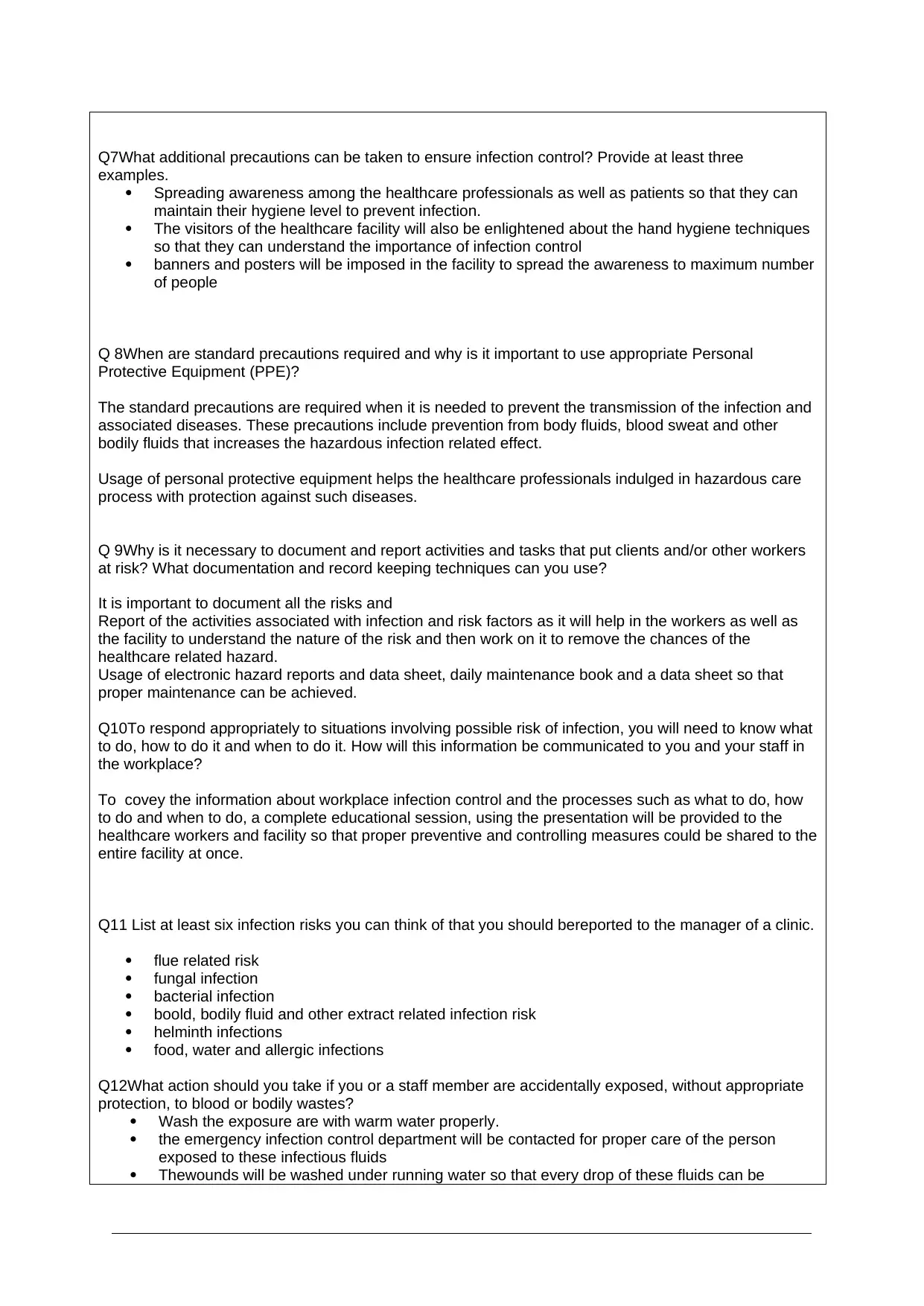
Q7What additional precautions can be taken to ensure infection control? Provide at least three
examples.
Spreading awareness among the healthcare professionals as well as patients so that they can
maintain their hygiene level to prevent infection.
The visitors of the healthcare facility will also be enlightened about the hand hygiene techniques
so that they can understand the importance of infection control
banners and posters will be imposed in the facility to spread the awareness to maximum number
of people
Q 8When are standard precautions required and why is it important to use appropriate Personal
Protective Equipment (PPE)?
The standard precautions are required when it is needed to prevent the transmission of the infection and
associated diseases. These precautions include prevention from body fluids, blood sweat and other
bodily fluids that increases the hazardous infection related effect.
Usage of personal protective equipment helps the healthcare professionals indulged in hazardous care
process with protection against such diseases.
Q 9Why is it necessary to document and report activities and tasks that put clients and/or other workers
at risk? What documentation and record keeping techniques can you use?
It is important to document all the risks and
Report of the activities associated with infection and risk factors as it will help in the workers as well as
the facility to understand the nature of the risk and then work on it to remove the chances of the
healthcare related hazard.
Usage of electronic hazard reports and data sheet, daily maintenance book and a data sheet so that
proper maintenance can be achieved.
Q10To respond appropriately to situations involving possible risk of infection, you will need to know what
to do, how to do it and when to do it. How will this information be communicated to you and your staff in
the workplace?
To covey the information about workplace infection control and the processes such as what to do, how
to do and when to do, a complete educational session, using the presentation will be provided to the
healthcare workers and facility so that proper preventive and controlling measures could be shared to the
entire facility at once.
Q11 List at least six infection risks you can think of that you should bereported to the manager of a clinic.
flue related risk
fungal infection
bacterial infection
boold, bodily fluid and other extract related infection risk
helminth infections
food, water and allergic infections
Q12What action should you take if you or a staff member are accidentally exposed, without appropriate
protection, to blood or bodily wastes?
Wash the exposure are with warm water properly.
the emergency infection control department will be contacted for proper care of the person
exposed to these infectious fluids
Thewounds will be washed under running water so that every drop of these fluids can be
examples.
Spreading awareness among the healthcare professionals as well as patients so that they can
maintain their hygiene level to prevent infection.
The visitors of the healthcare facility will also be enlightened about the hand hygiene techniques
so that they can understand the importance of infection control
banners and posters will be imposed in the facility to spread the awareness to maximum number
of people
Q 8When are standard precautions required and why is it important to use appropriate Personal
Protective Equipment (PPE)?
The standard precautions are required when it is needed to prevent the transmission of the infection and
associated diseases. These precautions include prevention from body fluids, blood sweat and other
bodily fluids that increases the hazardous infection related effect.
Usage of personal protective equipment helps the healthcare professionals indulged in hazardous care
process with protection against such diseases.
Q 9Why is it necessary to document and report activities and tasks that put clients and/or other workers
at risk? What documentation and record keeping techniques can you use?
It is important to document all the risks and
Report of the activities associated with infection and risk factors as it will help in the workers as well as
the facility to understand the nature of the risk and then work on it to remove the chances of the
healthcare related hazard.
Usage of electronic hazard reports and data sheet, daily maintenance book and a data sheet so that
proper maintenance can be achieved.
Q10To respond appropriately to situations involving possible risk of infection, you will need to know what
to do, how to do it and when to do it. How will this information be communicated to you and your staff in
the workplace?
To covey the information about workplace infection control and the processes such as what to do, how
to do and when to do, a complete educational session, using the presentation will be provided to the
healthcare workers and facility so that proper preventive and controlling measures could be shared to the
entire facility at once.
Q11 List at least six infection risks you can think of that you should bereported to the manager of a clinic.
flue related risk
fungal infection
bacterial infection
boold, bodily fluid and other extract related infection risk
helminth infections
food, water and allergic infections
Q12What action should you take if you or a staff member are accidentally exposed, without appropriate
protection, to blood or bodily wastes?
Wash the exposure are with warm water properly.
the emergency infection control department will be contacted for proper care of the person
exposed to these infectious fluids
Thewounds will be washed under running water so that every drop of these fluids can be
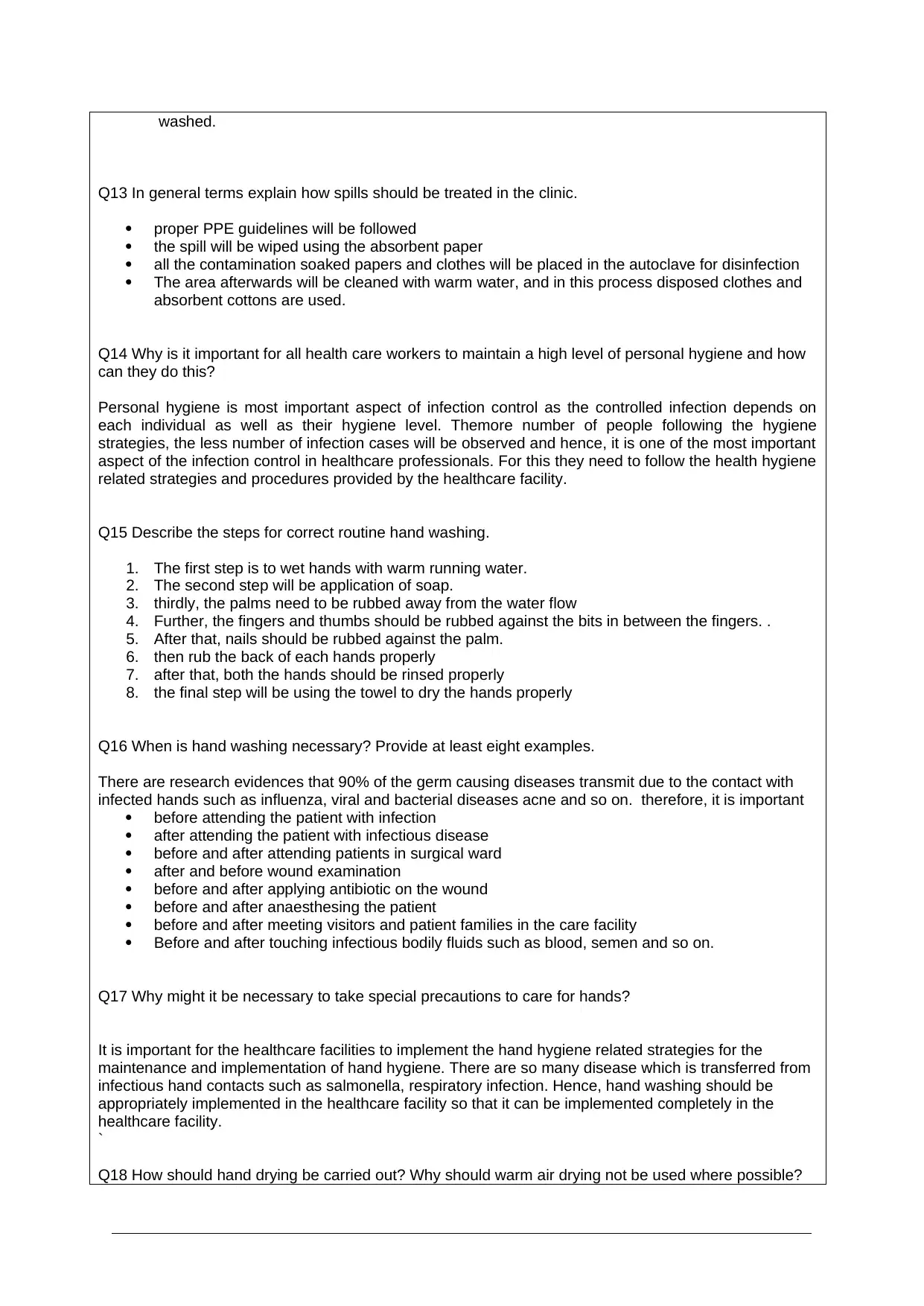
washed.
Q13 In general terms explain how spills should be treated in the clinic.
proper PPE guidelines will be followed
the spill will be wiped using the absorbent paper
all the contamination soaked papers and clothes will be placed in the autoclave for disinfection
The area afterwards will be cleaned with warm water, and in this process disposed clothes and
absorbent cottons are used.
Q14 Why is it important for all health care workers to maintain a high level of personal hygiene and how
can they do this?
Personal hygiene is most important aspect of infection control as the controlled infection depends on
each individual as well as their hygiene level. Themore number of people following the hygiene
strategies, the less number of infection cases will be observed and hence, it is one of the most important
aspect of the infection control in healthcare professionals. For this they need to follow the health hygiene
related strategies and procedures provided by the healthcare facility.
Q15 Describe the steps for correct routine hand washing.
1. The first step is to wet hands with warm running water.
2. The second step will be application of soap.
3. thirdly, the palms need to be rubbed away from the water flow
4. Further, the fingers and thumbs should be rubbed against the bits in between the fingers. .
5. After that, nails should be rubbed against the palm.
6. then rub the back of each hands properly
7. after that, both the hands should be rinsed properly
8. the final step will be using the towel to dry the hands properly
Q16 When is hand washing necessary? Provide at least eight examples.
There are research evidences that 90% of the germ causing diseases transmit due to the contact with
infected hands such as influenza, viral and bacterial diseases acne and so on. therefore, it is important
before attending the patient with infection
after attending the patient with infectious disease
before and after attending patients in surgical ward
after and before wound examination
before and after applying antibiotic on the wound
before and after anaesthesing the patient
before and after meeting visitors and patient families in the care facility
Before and after touching infectious bodily fluids such as blood, semen and so on.
Q17 Why might it be necessary to take special precautions to care for hands?
It is important for the healthcare facilities to implement the hand hygiene related strategies for the
maintenance and implementation of hand hygiene. There are so many disease which is transferred from
infectious hand contacts such as salmonella, respiratory infection. Hence, hand washing should be
appropriately implemented in the healthcare facility so that it can be implemented completely in the
healthcare facility.
`
Q18 How should hand drying be carried out? Why should warm air drying not be used where possible?
Q13 In general terms explain how spills should be treated in the clinic.
proper PPE guidelines will be followed
the spill will be wiped using the absorbent paper
all the contamination soaked papers and clothes will be placed in the autoclave for disinfection
The area afterwards will be cleaned with warm water, and in this process disposed clothes and
absorbent cottons are used.
Q14 Why is it important for all health care workers to maintain a high level of personal hygiene and how
can they do this?
Personal hygiene is most important aspect of infection control as the controlled infection depends on
each individual as well as their hygiene level. Themore number of people following the hygiene
strategies, the less number of infection cases will be observed and hence, it is one of the most important
aspect of the infection control in healthcare professionals. For this they need to follow the health hygiene
related strategies and procedures provided by the healthcare facility.
Q15 Describe the steps for correct routine hand washing.
1. The first step is to wet hands with warm running water.
2. The second step will be application of soap.
3. thirdly, the palms need to be rubbed away from the water flow
4. Further, the fingers and thumbs should be rubbed against the bits in between the fingers. .
5. After that, nails should be rubbed against the palm.
6. then rub the back of each hands properly
7. after that, both the hands should be rinsed properly
8. the final step will be using the towel to dry the hands properly
Q16 When is hand washing necessary? Provide at least eight examples.
There are research evidences that 90% of the germ causing diseases transmit due to the contact with
infected hands such as influenza, viral and bacterial diseases acne and so on. therefore, it is important
before attending the patient with infection
after attending the patient with infectious disease
before and after attending patients in surgical ward
after and before wound examination
before and after applying antibiotic on the wound
before and after anaesthesing the patient
before and after meeting visitors and patient families in the care facility
Before and after touching infectious bodily fluids such as blood, semen and so on.
Q17 Why might it be necessary to take special precautions to care for hands?
It is important for the healthcare facilities to implement the hand hygiene related strategies for the
maintenance and implementation of hand hygiene. There are so many disease which is transferred from
infectious hand contacts such as salmonella, respiratory infection. Hence, hand washing should be
appropriately implemented in the healthcare facility so that it can be implemented completely in the
healthcare facility.
`
Q18 How should hand drying be carried out? Why should warm air drying not be used where possible?
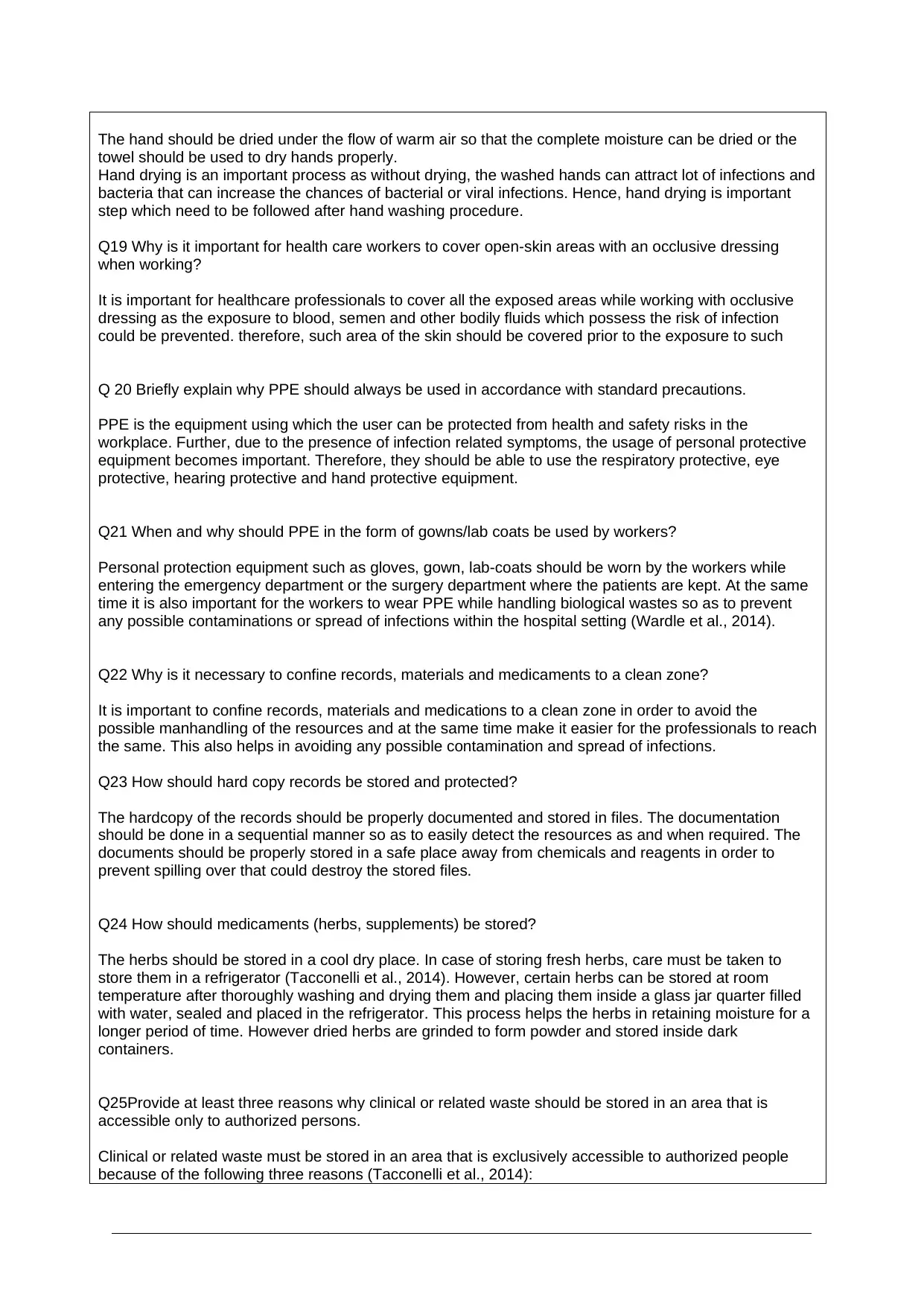
The hand should be dried under the flow of warm air so that the complete moisture can be dried or the
towel should be used to dry hands properly.
Hand drying is an important process as without drying, the washed hands can attract lot of infections and
bacteria that can increase the chances of bacterial or viral infections. Hence, hand drying is important
step which need to be followed after hand washing procedure.
Q19 Why is it important for health care workers to cover open-skin areas with an occlusive dressing
when working?
It is important for healthcare professionals to cover all the exposed areas while working with occlusive
dressing as the exposure to blood, semen and other bodily fluids which possess the risk of infection
could be prevented. therefore, such area of the skin should be covered prior to the exposure to such
Q 20 Briefly explain why PPE should always be used in accordance with standard precautions.
PPE is the equipment using which the user can be protected from health and safety risks in the
workplace. Further, due to the presence of infection related symptoms, the usage of personal protective
equipment becomes important. Therefore, they should be able to use the respiratory protective, eye
protective, hearing protective and hand protective equipment.
Q21 When and why should PPE in the form of gowns/lab coats be used by workers?
Personal protection equipment such as gloves, gown, lab-coats should be worn by the workers while
entering the emergency department or the surgery department where the patients are kept. At the same
time it is also important for the workers to wear PPE while handling biological wastes so as to prevent
any possible contaminations or spread of infections within the hospital setting (Wardle et al., 2014).
Q22 Why is it necessary to confine records, materials and medicaments to a clean zone?
It is important to confine records, materials and medications to a clean zone in order to avoid the
possible manhandling of the resources and at the same time make it easier for the professionals to reach
the same. This also helps in avoiding any possible contamination and spread of infections.
Q23 How should hard copy records be stored and protected?
The hardcopy of the records should be properly documented and stored in files. The documentation
should be done in a sequential manner so as to easily detect the resources as and when required. The
documents should be properly stored in a safe place away from chemicals and reagents in order to
prevent spilling over that could destroy the stored files.
Q24 How should medicaments (herbs, supplements) be stored?
The herbs should be stored in a cool dry place. In case of storing fresh herbs, care must be taken to
store them in a refrigerator (Tacconelli et al., 2014). However, certain herbs can be stored at room
temperature after thoroughly washing and drying them and placing them inside a glass jar quarter filled
with water, sealed and placed in the refrigerator. This process helps the herbs in retaining moisture for a
longer period of time. However dried herbs are grinded to form powder and stored inside dark
containers.
Q25Provide at least three reasons why clinical or related waste should be stored in an area that is
accessible only to authorized persons.
Clinical or related waste must be stored in an area that is exclusively accessible to authorized people
because of the following three reasons (Tacconelli et al., 2014):
towel should be used to dry hands properly.
Hand drying is an important process as without drying, the washed hands can attract lot of infections and
bacteria that can increase the chances of bacterial or viral infections. Hence, hand drying is important
step which need to be followed after hand washing procedure.
Q19 Why is it important for health care workers to cover open-skin areas with an occlusive dressing
when working?
It is important for healthcare professionals to cover all the exposed areas while working with occlusive
dressing as the exposure to blood, semen and other bodily fluids which possess the risk of infection
could be prevented. therefore, such area of the skin should be covered prior to the exposure to such
Q 20 Briefly explain why PPE should always be used in accordance with standard precautions.
PPE is the equipment using which the user can be protected from health and safety risks in the
workplace. Further, due to the presence of infection related symptoms, the usage of personal protective
equipment becomes important. Therefore, they should be able to use the respiratory protective, eye
protective, hearing protective and hand protective equipment.
Q21 When and why should PPE in the form of gowns/lab coats be used by workers?
Personal protection equipment such as gloves, gown, lab-coats should be worn by the workers while
entering the emergency department or the surgery department where the patients are kept. At the same
time it is also important for the workers to wear PPE while handling biological wastes so as to prevent
any possible contaminations or spread of infections within the hospital setting (Wardle et al., 2014).
Q22 Why is it necessary to confine records, materials and medicaments to a clean zone?
It is important to confine records, materials and medications to a clean zone in order to avoid the
possible manhandling of the resources and at the same time make it easier for the professionals to reach
the same. This also helps in avoiding any possible contamination and spread of infections.
Q23 How should hard copy records be stored and protected?
The hardcopy of the records should be properly documented and stored in files. The documentation
should be done in a sequential manner so as to easily detect the resources as and when required. The
documents should be properly stored in a safe place away from chemicals and reagents in order to
prevent spilling over that could destroy the stored files.
Q24 How should medicaments (herbs, supplements) be stored?
The herbs should be stored in a cool dry place. In case of storing fresh herbs, care must be taken to
store them in a refrigerator (Tacconelli et al., 2014). However, certain herbs can be stored at room
temperature after thoroughly washing and drying them and placing them inside a glass jar quarter filled
with water, sealed and placed in the refrigerator. This process helps the herbs in retaining moisture for a
longer period of time. However dried herbs are grinded to form powder and stored inside dark
containers.
Q25Provide at least three reasons why clinical or related waste should be stored in an area that is
accessible only to authorized persons.
Clinical or related waste must be stored in an area that is exclusively accessible to authorized people
because of the following three reasons (Tacconelli et al., 2014):
Paraphrase This Document
Need a fresh take? Get an instant paraphrase of this document with our AI Paraphraser
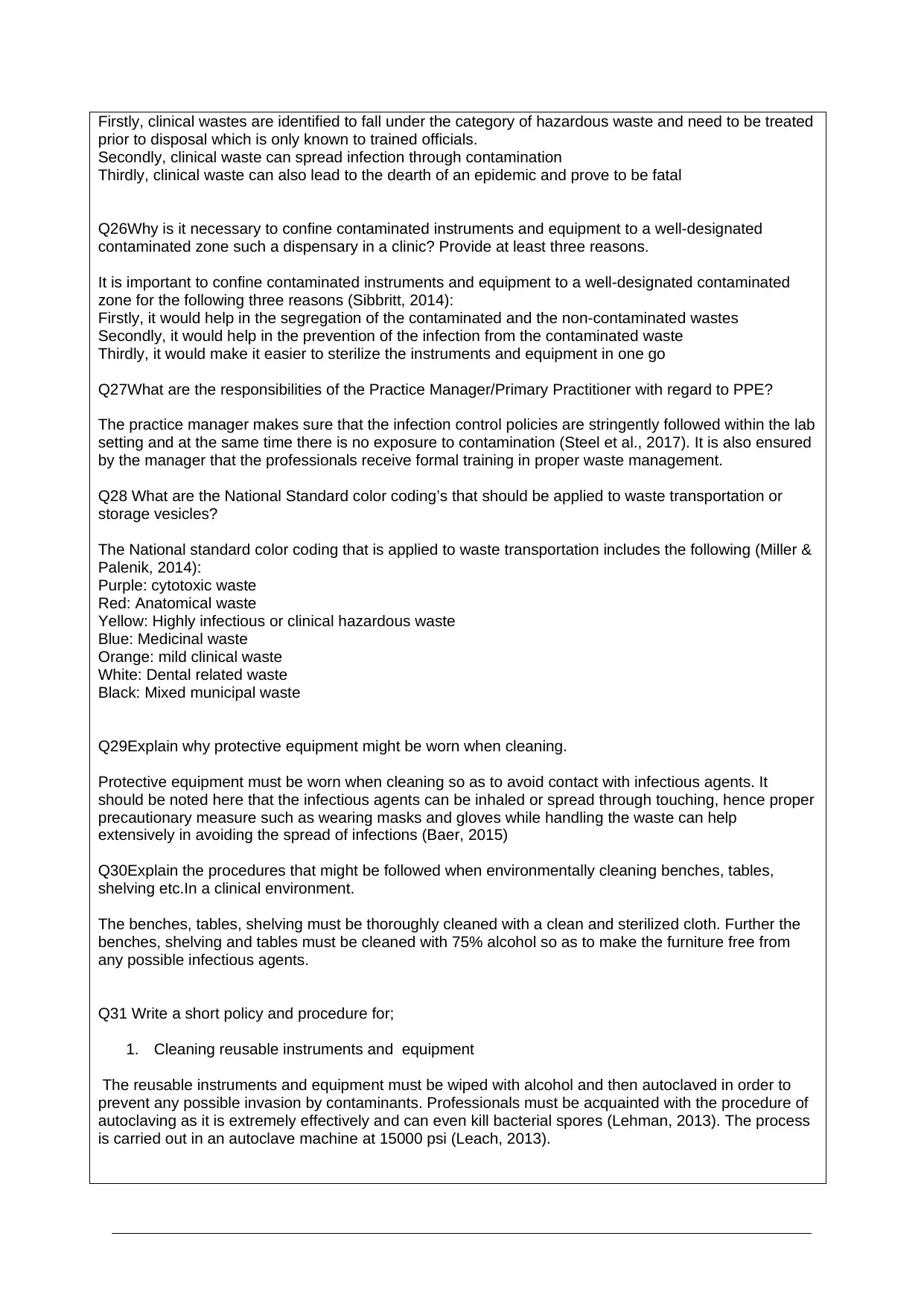
Firstly, clinical wastes are identified to fall under the category of hazardous waste and need to be treated
prior to disposal which is only known to trained officials.
Secondly, clinical waste can spread infection through contamination
Thirdly, clinical waste can also lead to the dearth of an epidemic and prove to be fatal
Q26Why is it necessary to confine contaminated instruments and equipment to a well-designated
contaminated zone such a dispensary in a clinic? Provide at least three reasons.
It is important to confine contaminated instruments and equipment to a well-designated contaminated
zone for the following three reasons (Sibbritt, 2014):
Firstly, it would help in the segregation of the contaminated and the non-contaminated wastes
Secondly, it would help in the prevention of the infection from the contaminated waste
Thirdly, it would make it easier to sterilize the instruments and equipment in one go
Q27What are the responsibilities of the Practice Manager/Primary Practitioner with regard to PPE?
The practice manager makes sure that the infection control policies are stringently followed within the lab
setting and at the same time there is no exposure to contamination (Steel et al., 2017). It is also ensured
by the manager that the professionals receive formal training in proper waste management.
Q28 What are the National Standard color coding’s that should be applied to waste transportation or
storage vesicles?
The National standard color coding that is applied to waste transportation includes the following (Miller &
Palenik, 2014):
Purple: cytotoxic waste
Red: Anatomical waste
Yellow: Highly infectious or clinical hazardous waste
Blue: Medicinal waste
Orange: mild clinical waste
White: Dental related waste
Black: Mixed municipal waste
Q29Explain why protective equipment might be worn when cleaning.
Protective equipment must be worn when cleaning so as to avoid contact with infectious agents. It
should be noted here that the infectious agents can be inhaled or spread through touching, hence proper
precautionary measure such as wearing masks and gloves while handling the waste can help
extensively in avoiding the spread of infections (Baer, 2015)
Q30Explain the procedures that might be followed when environmentally cleaning benches, tables,
shelving etc.In a clinical environment.
The benches, tables, shelving must be thoroughly cleaned with a clean and sterilized cloth. Further the
benches, shelving and tables must be cleaned with 75% alcohol so as to make the furniture free from
any possible infectious agents.
Q31 Write a short policy and procedure for;
1. Cleaning reusable instruments and equipment
The reusable instruments and equipment must be wiped with alcohol and then autoclaved in order to
prevent any possible invasion by contaminants. Professionals must be acquainted with the procedure of
autoclaving as it is extremely effectively and can even kill bacterial spores (Lehman, 2013). The process
is carried out in an autoclave machine at 15000 psi (Leach, 2013).
prior to disposal which is only known to trained officials.
Secondly, clinical waste can spread infection through contamination
Thirdly, clinical waste can also lead to the dearth of an epidemic and prove to be fatal
Q26Why is it necessary to confine contaminated instruments and equipment to a well-designated
contaminated zone such a dispensary in a clinic? Provide at least three reasons.
It is important to confine contaminated instruments and equipment to a well-designated contaminated
zone for the following three reasons (Sibbritt, 2014):
Firstly, it would help in the segregation of the contaminated and the non-contaminated wastes
Secondly, it would help in the prevention of the infection from the contaminated waste
Thirdly, it would make it easier to sterilize the instruments and equipment in one go
Q27What are the responsibilities of the Practice Manager/Primary Practitioner with regard to PPE?
The practice manager makes sure that the infection control policies are stringently followed within the lab
setting and at the same time there is no exposure to contamination (Steel et al., 2017). It is also ensured
by the manager that the professionals receive formal training in proper waste management.
Q28 What are the National Standard color coding’s that should be applied to waste transportation or
storage vesicles?
The National standard color coding that is applied to waste transportation includes the following (Miller &
Palenik, 2014):
Purple: cytotoxic waste
Red: Anatomical waste
Yellow: Highly infectious or clinical hazardous waste
Blue: Medicinal waste
Orange: mild clinical waste
White: Dental related waste
Black: Mixed municipal waste
Q29Explain why protective equipment might be worn when cleaning.
Protective equipment must be worn when cleaning so as to avoid contact with infectious agents. It
should be noted here that the infectious agents can be inhaled or spread through touching, hence proper
precautionary measure such as wearing masks and gloves while handling the waste can help
extensively in avoiding the spread of infections (Baer, 2015)
Q30Explain the procedures that might be followed when environmentally cleaning benches, tables,
shelving etc.In a clinical environment.
The benches, tables, shelving must be thoroughly cleaned with a clean and sterilized cloth. Further the
benches, shelving and tables must be cleaned with 75% alcohol so as to make the furniture free from
any possible infectious agents.
Q31 Write a short policy and procedure for;
1. Cleaning reusable instruments and equipment
The reusable instruments and equipment must be wiped with alcohol and then autoclaved in order to
prevent any possible invasion by contaminants. Professionals must be acquainted with the procedure of
autoclaving as it is extremely effectively and can even kill bacterial spores (Lehman, 2013). The process
is carried out in an autoclave machine at 15000 psi (Leach, 2013).
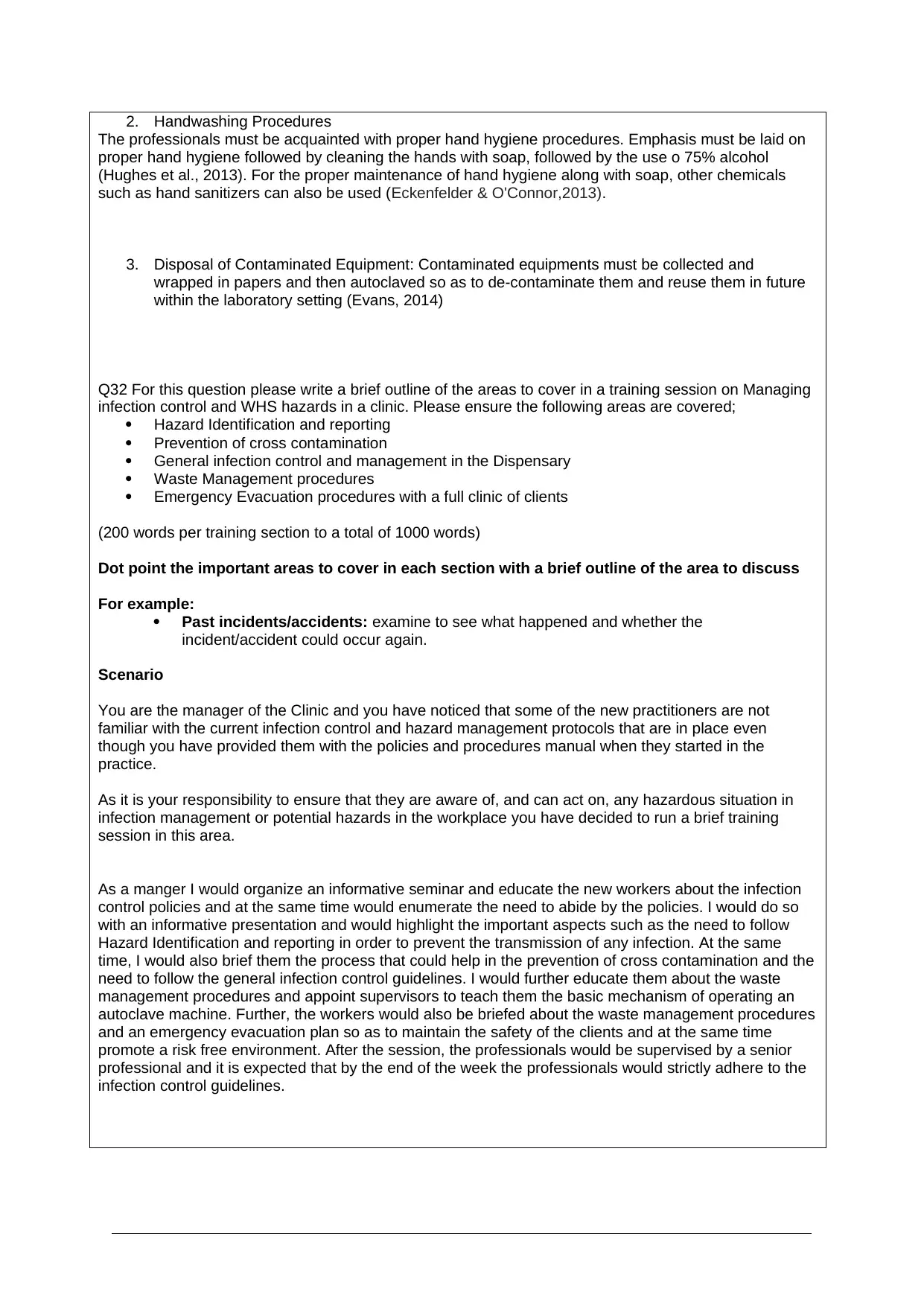
2. Handwashing Procedures
The professionals must be acquainted with proper hand hygiene procedures. Emphasis must be laid on
proper hand hygiene followed by cleaning the hands with soap, followed by the use o 75% alcohol
(Hughes et al., 2013). For the proper maintenance of hand hygiene along with soap, other chemicals
such as hand sanitizers can also be used (Eckenfelder & O'Connor,2013).
3. Disposal of Contaminated Equipment: Contaminated equipments must be collected and
wrapped in papers and then autoclaved so as to de-contaminate them and reuse them in future
within the laboratory setting (Evans, 2014)
Q32 For this question please write a brief outline of the areas to cover in a training session on Managing
infection control and WHS hazards in a clinic. Please ensure the following areas are covered;
Hazard Identification and reporting
Prevention of cross contamination
General infection control and management in the Dispensary
Waste Management procedures
Emergency Evacuation procedures with a full clinic of clients
(200 words per training section to a total of 1000 words)
Dot point the important areas to cover in each section with a brief outline of the area to discuss
For example:
Past incidents/accidents: examine to see what happened and whether the
incident/accident could occur again.
Scenario
You are the manager of the Clinic and you have noticed that some of the new practitioners are not
familiar with the current infection control and hazard management protocols that are in place even
though you have provided them with the policies and procedures manual when they started in the
practice.
As it is your responsibility to ensure that they are aware of, and can act on, any hazardous situation in
infection management or potential hazards in the workplace you have decided to run a brief training
session in this area.
As a manger I would organize an informative seminar and educate the new workers about the infection
control policies and at the same time would enumerate the need to abide by the policies. I would do so
with an informative presentation and would highlight the important aspects such as the need to follow
Hazard Identification and reporting in order to prevent the transmission of any infection. At the same
time, I would also brief them the process that could help in the prevention of cross contamination and the
need to follow the general infection control guidelines. I would further educate them about the waste
management procedures and appoint supervisors to teach them the basic mechanism of operating an
autoclave machine. Further, the workers would also be briefed about the waste management procedures
and an emergency evacuation plan so as to maintain the safety of the clients and at the same time
promote a risk free environment. After the session, the professionals would be supervised by a senior
professional and it is expected that by the end of the week the professionals would strictly adhere to the
infection control guidelines.
The professionals must be acquainted with proper hand hygiene procedures. Emphasis must be laid on
proper hand hygiene followed by cleaning the hands with soap, followed by the use o 75% alcohol
(Hughes et al., 2013). For the proper maintenance of hand hygiene along with soap, other chemicals
such as hand sanitizers can also be used (Eckenfelder & O'Connor,2013).
3. Disposal of Contaminated Equipment: Contaminated equipments must be collected and
wrapped in papers and then autoclaved so as to de-contaminate them and reuse them in future
within the laboratory setting (Evans, 2014)
Q32 For this question please write a brief outline of the areas to cover in a training session on Managing
infection control and WHS hazards in a clinic. Please ensure the following areas are covered;
Hazard Identification and reporting
Prevention of cross contamination
General infection control and management in the Dispensary
Waste Management procedures
Emergency Evacuation procedures with a full clinic of clients
(200 words per training section to a total of 1000 words)
Dot point the important areas to cover in each section with a brief outline of the area to discuss
For example:
Past incidents/accidents: examine to see what happened and whether the
incident/accident could occur again.
Scenario
You are the manager of the Clinic and you have noticed that some of the new practitioners are not
familiar with the current infection control and hazard management protocols that are in place even
though you have provided them with the policies and procedures manual when they started in the
practice.
As it is your responsibility to ensure that they are aware of, and can act on, any hazardous situation in
infection management or potential hazards in the workplace you have decided to run a brief training
session in this area.
As a manger I would organize an informative seminar and educate the new workers about the infection
control policies and at the same time would enumerate the need to abide by the policies. I would do so
with an informative presentation and would highlight the important aspects such as the need to follow
Hazard Identification and reporting in order to prevent the transmission of any infection. At the same
time, I would also brief them the process that could help in the prevention of cross contamination and the
need to follow the general infection control guidelines. I would further educate them about the waste
management procedures and appoint supervisors to teach them the basic mechanism of operating an
autoclave machine. Further, the workers would also be briefed about the waste management procedures
and an emergency evacuation plan so as to maintain the safety of the clients and at the same time
promote a risk free environment. After the session, the professionals would be supervised by a senior
professional and it is expected that by the end of the week the professionals would strictly adhere to the
infection control guidelines.
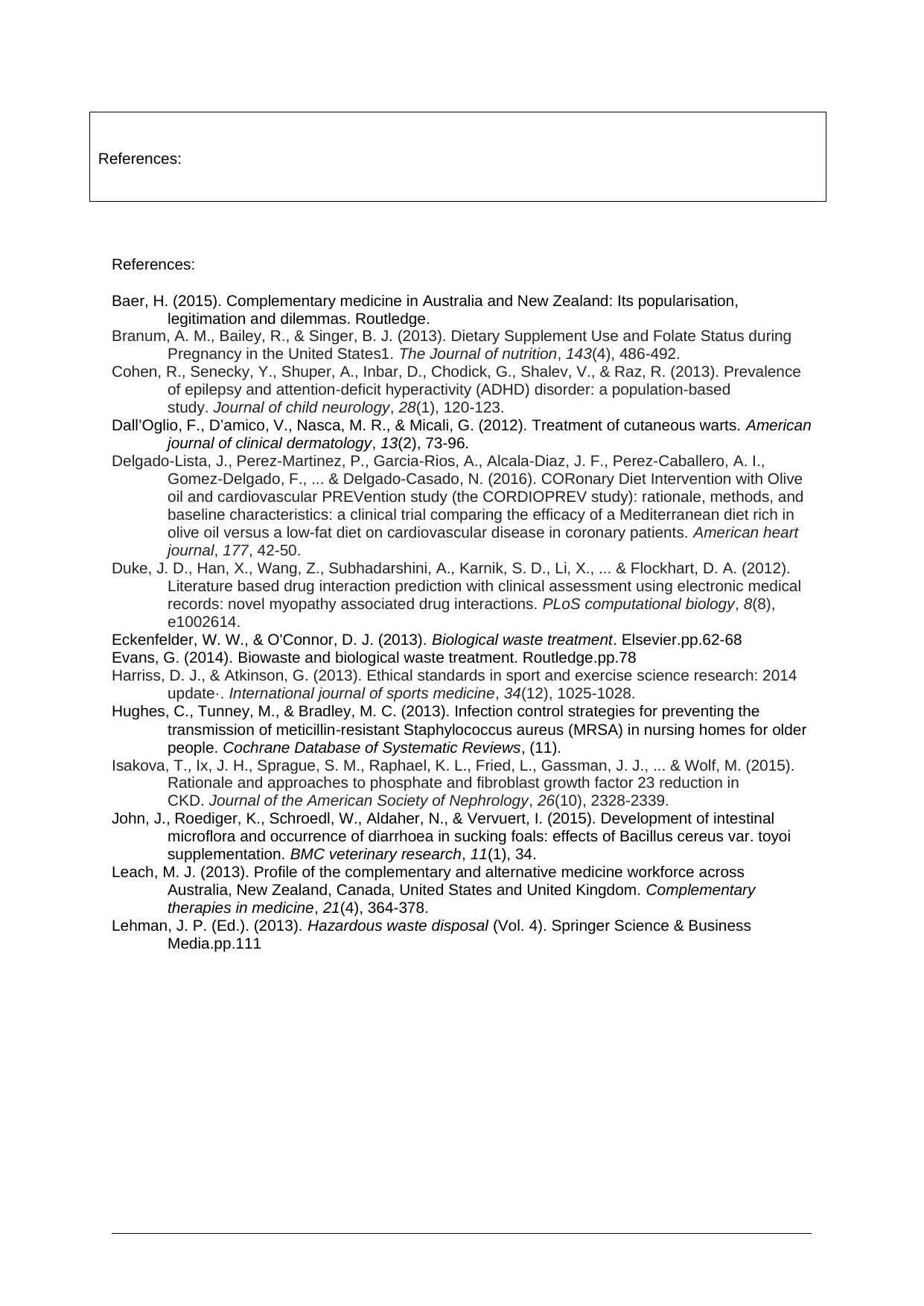
References:
References:
Baer, H. (2015). Complementary medicine in Australia and New Zealand: Its popularisation,
legitimation and dilemmas. Routledge.
Branum, A. M., Bailey, R., & Singer, B. J. (2013). Dietary Supplement Use and Folate Status during
Pregnancy in the United States1. The Journal of nutrition, 143(4), 486-492.
Cohen, R., Senecky, Y., Shuper, A., Inbar, D., Chodick, G., Shalev, V., & Raz, R. (2013). Prevalence
of epilepsy and attention-deficit hyperactivity (ADHD) disorder: a population-based
study. Journal of child neurology, 28(1), 120-123.
Dall’Oglio, F., D’amico, V., Nasca, M. R., & Micali, G. (2012). Treatment of cutaneous warts. American
journal of clinical dermatology, 13(2), 73-96.
Delgado-Lista, J., Perez-Martinez, P., Garcia-Rios, A., Alcala-Diaz, J. F., Perez-Caballero, A. I.,
Gomez-Delgado, F., ... & Delgado-Casado, N. (2016). CORonary Diet Intervention with Olive
oil and cardiovascular PREVention study (the CORDIOPREV study): rationale, methods, and
baseline characteristics: a clinical trial comparing the efficacy of a Mediterranean diet rich in
olive oil versus a low-fat diet on cardiovascular disease in coronary patients. American heart
journal, 177, 42-50.
Duke, J. D., Han, X., Wang, Z., Subhadarshini, A., Karnik, S. D., Li, X., ... & Flockhart, D. A. (2012).
Literature based drug interaction prediction with clinical assessment using electronic medical
records: novel myopathy associated drug interactions. PLoS computational biology, 8(8),
e1002614.
Eckenfelder, W. W., & O'Connor, D. J. (2013). Biological waste treatment. Elsevier.pp.62-68
Evans, G. (2014). Biowaste and biological waste treatment. Routledge.pp.78
Harriss, D. J., & Atkinson, G. (2013). Ethical standards in sport and exercise science research: 2014
update·. International journal of sports medicine, 34(12), 1025-1028.
Hughes, C., Tunney, M., & Bradley, M. C. (2013). Infection control strategies for preventing the
transmission of meticillin‐resistant Staphylococcus aureus (MRSA) in nursing homes for older
people. Cochrane Database of Systematic Reviews, (11).
Isakova, T., Ix, J. H., Sprague, S. M., Raphael, K. L., Fried, L., Gassman, J. J., ... & Wolf, M. (2015).
Rationale and approaches to phosphate and fibroblast growth factor 23 reduction in
CKD. Journal of the American Society of Nephrology, 26(10), 2328-2339.
John, J., Roediger, K., Schroedl, W., Aldaher, N., & Vervuert, I. (2015). Development of intestinal
microflora and occurrence of diarrhoea in sucking foals: effects of Bacillus cereus var. toyoi
supplementation. BMC veterinary research, 11(1), 34.
Leach, M. J. (2013). Profile of the complementary and alternative medicine workforce across
Australia, New Zealand, Canada, United States and United Kingdom. Complementary
therapies in medicine, 21(4), 364-378.
Lehman, J. P. (Ed.). (2013). Hazardous waste disposal (Vol. 4). Springer Science & Business
Media.pp.111
References:
Baer, H. (2015). Complementary medicine in Australia and New Zealand: Its popularisation,
legitimation and dilemmas. Routledge.
Branum, A. M., Bailey, R., & Singer, B. J. (2013). Dietary Supplement Use and Folate Status during
Pregnancy in the United States1. The Journal of nutrition, 143(4), 486-492.
Cohen, R., Senecky, Y., Shuper, A., Inbar, D., Chodick, G., Shalev, V., & Raz, R. (2013). Prevalence
of epilepsy and attention-deficit hyperactivity (ADHD) disorder: a population-based
study. Journal of child neurology, 28(1), 120-123.
Dall’Oglio, F., D’amico, V., Nasca, M. R., & Micali, G. (2012). Treatment of cutaneous warts. American
journal of clinical dermatology, 13(2), 73-96.
Delgado-Lista, J., Perez-Martinez, P., Garcia-Rios, A., Alcala-Diaz, J. F., Perez-Caballero, A. I.,
Gomez-Delgado, F., ... & Delgado-Casado, N. (2016). CORonary Diet Intervention with Olive
oil and cardiovascular PREVention study (the CORDIOPREV study): rationale, methods, and
baseline characteristics: a clinical trial comparing the efficacy of a Mediterranean diet rich in
olive oil versus a low-fat diet on cardiovascular disease in coronary patients. American heart
journal, 177, 42-50.
Duke, J. D., Han, X., Wang, Z., Subhadarshini, A., Karnik, S. D., Li, X., ... & Flockhart, D. A. (2012).
Literature based drug interaction prediction with clinical assessment using electronic medical
records: novel myopathy associated drug interactions. PLoS computational biology, 8(8),
e1002614.
Eckenfelder, W. W., & O'Connor, D. J. (2013). Biological waste treatment. Elsevier.pp.62-68
Evans, G. (2014). Biowaste and biological waste treatment. Routledge.pp.78
Harriss, D. J., & Atkinson, G. (2013). Ethical standards in sport and exercise science research: 2014
update·. International journal of sports medicine, 34(12), 1025-1028.
Hughes, C., Tunney, M., & Bradley, M. C. (2013). Infection control strategies for preventing the
transmission of meticillin‐resistant Staphylococcus aureus (MRSA) in nursing homes for older
people. Cochrane Database of Systematic Reviews, (11).
Isakova, T., Ix, J. H., Sprague, S. M., Raphael, K. L., Fried, L., Gassman, J. J., ... & Wolf, M. (2015).
Rationale and approaches to phosphate and fibroblast growth factor 23 reduction in
CKD. Journal of the American Society of Nephrology, 26(10), 2328-2339.
John, J., Roediger, K., Schroedl, W., Aldaher, N., & Vervuert, I. (2015). Development of intestinal
microflora and occurrence of diarrhoea in sucking foals: effects of Bacillus cereus var. toyoi
supplementation. BMC veterinary research, 11(1), 34.
Leach, M. J. (2013). Profile of the complementary and alternative medicine workforce across
Australia, New Zealand, Canada, United States and United Kingdom. Complementary
therapies in medicine, 21(4), 364-378.
Lehman, J. P. (Ed.). (2013). Hazardous waste disposal (Vol. 4). Springer Science & Business
Media.pp.111
Secure Best Marks with AI Grader
Need help grading? Try our AI Grader for instant feedback on your assignments.
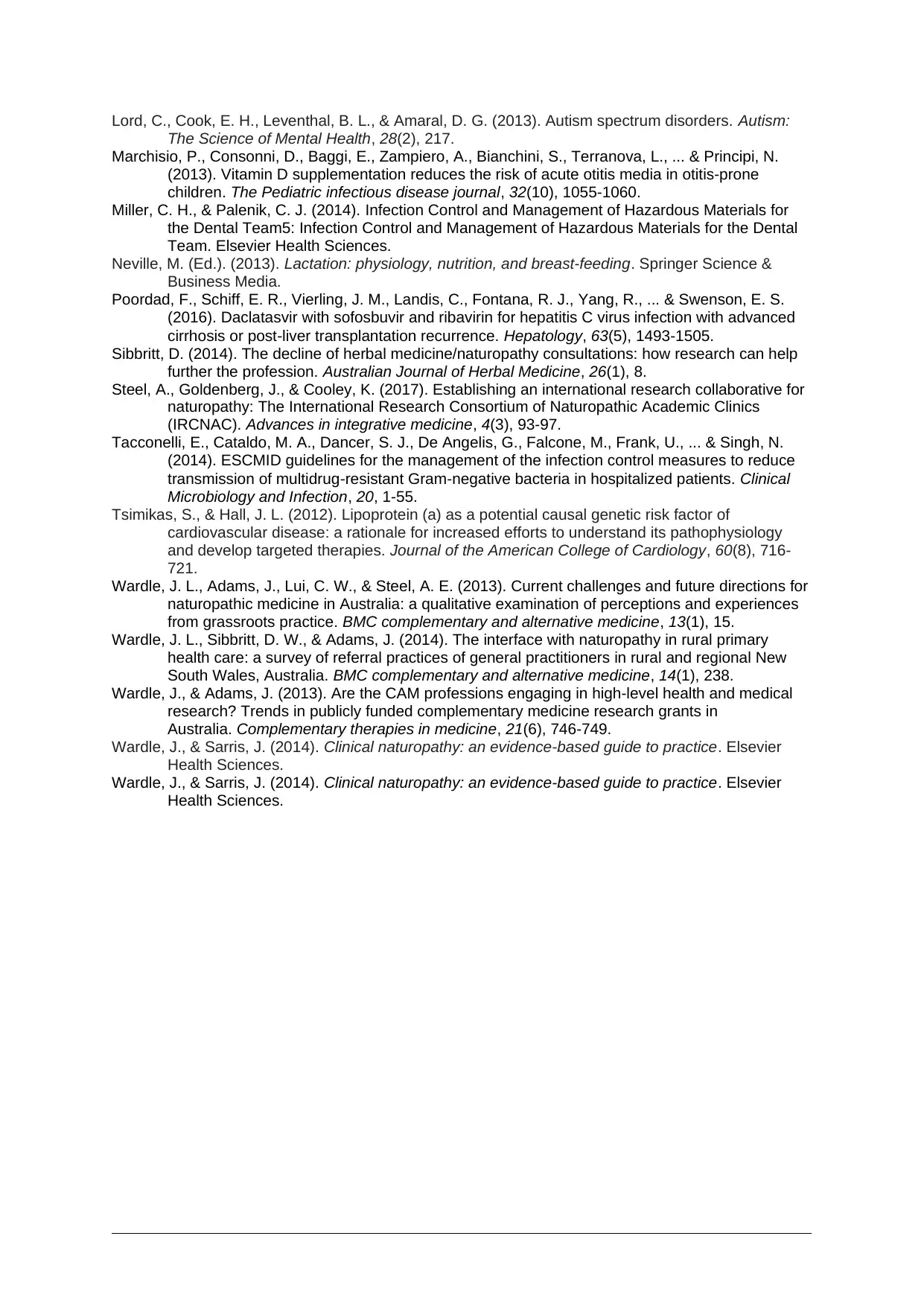
Lord, C., Cook, E. H., Leventhal, B. L., & Amaral, D. G. (2013). Autism spectrum disorders. Autism:
The Science of Mental Health, 28(2), 217.
Marchisio, P., Consonni, D., Baggi, E., Zampiero, A., Bianchini, S., Terranova, L., ... & Principi, N.
(2013). Vitamin D supplementation reduces the risk of acute otitis media in otitis-prone
children. The Pediatric infectious disease journal, 32(10), 1055-1060.
Miller, C. H., & Palenik, C. J. (2014). Infection Control and Management of Hazardous Materials for
the Dental Team5: Infection Control and Management of Hazardous Materials for the Dental
Team. Elsevier Health Sciences.
Neville, M. (Ed.). (2013). Lactation: physiology, nutrition, and breast-feeding. Springer Science &
Business Media.
Poordad, F., Schiff, E. R., Vierling, J. M., Landis, C., Fontana, R. J., Yang, R., ... & Swenson, E. S.
(2016). Daclatasvir with sofosbuvir and ribavirin for hepatitis C virus infection with advanced
cirrhosis or post‐liver transplantation recurrence. Hepatology, 63(5), 1493-1505.
Sibbritt, D. (2014). The decline of herbal medicine/naturopathy consultations: how research can help
further the profession. Australian Journal of Herbal Medicine, 26(1), 8.
Steel, A., Goldenberg, J., & Cooley, K. (2017). Establishing an international research collaborative for
naturopathy: The International Research Consortium of Naturopathic Academic Clinics
(IRCNAC). Advances in integrative medicine, 4(3), 93-97.
Tacconelli, E., Cataldo, M. A., Dancer, S. J., De Angelis, G., Falcone, M., Frank, U., ... & Singh, N.
(2014). ESCMID guidelines for the management of the infection control measures to reduce
transmission of multidrug‐resistant Gram‐negative bacteria in hospitalized patients. Clinical
Microbiology and Infection, 20, 1-55.
Tsimikas, S., & Hall, J. L. (2012). Lipoprotein (a) as a potential causal genetic risk factor of
cardiovascular disease: a rationale for increased efforts to understand its pathophysiology
and develop targeted therapies. Journal of the American College of Cardiology, 60(8), 716-
721.
Wardle, J. L., Adams, J., Lui, C. W., & Steel, A. E. (2013). Current challenges and future directions for
naturopathic medicine in Australia: a qualitative examination of perceptions and experiences
from grassroots practice. BMC complementary and alternative medicine, 13(1), 15.
Wardle, J. L., Sibbritt, D. W., & Adams, J. (2014). The interface with naturopathy in rural primary
health care: a survey of referral practices of general practitioners in rural and regional New
South Wales, Australia. BMC complementary and alternative medicine, 14(1), 238.
Wardle, J., & Adams, J. (2013). Are the CAM professions engaging in high-level health and medical
research? Trends in publicly funded complementary medicine research grants in
Australia. Complementary therapies in medicine, 21(6), 746-749.
Wardle, J., & Sarris, J. (2014). Clinical naturopathy: an evidence-based guide to practice. Elsevier
Health Sciences.
Wardle, J., & Sarris, J. (2014). Clinical naturopathy: an evidence-based guide to practice. Elsevier
Health Sciences.
The Science of Mental Health, 28(2), 217.
Marchisio, P., Consonni, D., Baggi, E., Zampiero, A., Bianchini, S., Terranova, L., ... & Principi, N.
(2013). Vitamin D supplementation reduces the risk of acute otitis media in otitis-prone
children. The Pediatric infectious disease journal, 32(10), 1055-1060.
Miller, C. H., & Palenik, C. J. (2014). Infection Control and Management of Hazardous Materials for
the Dental Team5: Infection Control and Management of Hazardous Materials for the Dental
Team. Elsevier Health Sciences.
Neville, M. (Ed.). (2013). Lactation: physiology, nutrition, and breast-feeding. Springer Science &
Business Media.
Poordad, F., Schiff, E. R., Vierling, J. M., Landis, C., Fontana, R. J., Yang, R., ... & Swenson, E. S.
(2016). Daclatasvir with sofosbuvir and ribavirin for hepatitis C virus infection with advanced
cirrhosis or post‐liver transplantation recurrence. Hepatology, 63(5), 1493-1505.
Sibbritt, D. (2014). The decline of herbal medicine/naturopathy consultations: how research can help
further the profession. Australian Journal of Herbal Medicine, 26(1), 8.
Steel, A., Goldenberg, J., & Cooley, K. (2017). Establishing an international research collaborative for
naturopathy: The International Research Consortium of Naturopathic Academic Clinics
(IRCNAC). Advances in integrative medicine, 4(3), 93-97.
Tacconelli, E., Cataldo, M. A., Dancer, S. J., De Angelis, G., Falcone, M., Frank, U., ... & Singh, N.
(2014). ESCMID guidelines for the management of the infection control measures to reduce
transmission of multidrug‐resistant Gram‐negative bacteria in hospitalized patients. Clinical
Microbiology and Infection, 20, 1-55.
Tsimikas, S., & Hall, J. L. (2012). Lipoprotein (a) as a potential causal genetic risk factor of
cardiovascular disease: a rationale for increased efforts to understand its pathophysiology
and develop targeted therapies. Journal of the American College of Cardiology, 60(8), 716-
721.
Wardle, J. L., Adams, J., Lui, C. W., & Steel, A. E. (2013). Current challenges and future directions for
naturopathic medicine in Australia: a qualitative examination of perceptions and experiences
from grassroots practice. BMC complementary and alternative medicine, 13(1), 15.
Wardle, J. L., Sibbritt, D. W., & Adams, J. (2014). The interface with naturopathy in rural primary
health care: a survey of referral practices of general practitioners in rural and regional New
South Wales, Australia. BMC complementary and alternative medicine, 14(1), 238.
Wardle, J., & Adams, J. (2013). Are the CAM professions engaging in high-level health and medical
research? Trends in publicly funded complementary medicine research grants in
Australia. Complementary therapies in medicine, 21(6), 746-749.
Wardle, J., & Sarris, J. (2014). Clinical naturopathy: an evidence-based guide to practice. Elsevier
Health Sciences.
Wardle, J., & Sarris, J. (2014). Clinical naturopathy: an evidence-based guide to practice. Elsevier
Health Sciences.
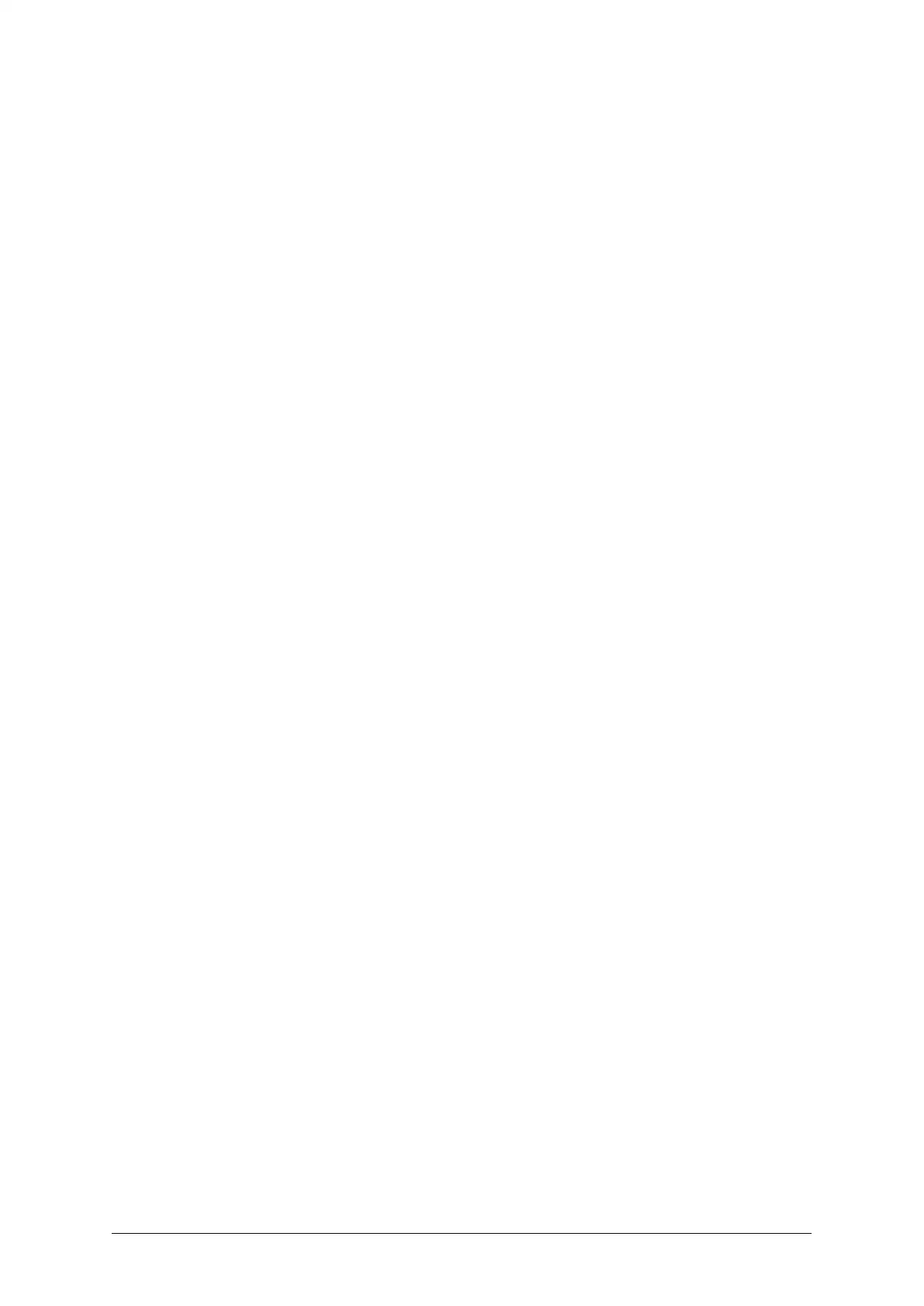
1 out of 36
Your All-in-One AI-Powered Toolkit for Academic Success.
+13062052269
info@desklib.com
Available 24*7 on WhatsApp / Email
![[object Object]](/_next/static/media/star-bottom.7253800d.svg)
Unlock your academic potential
© 2024 | Zucol Services PVT LTD | All rights reserved.